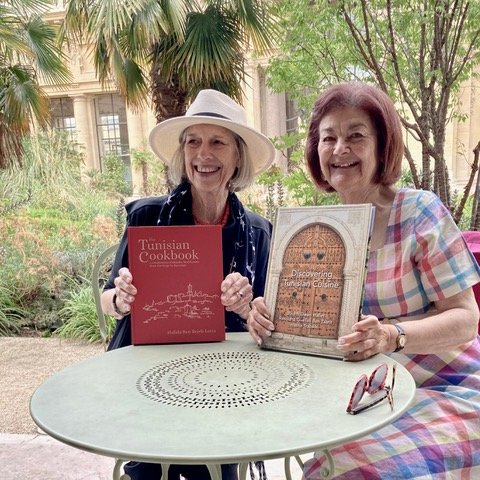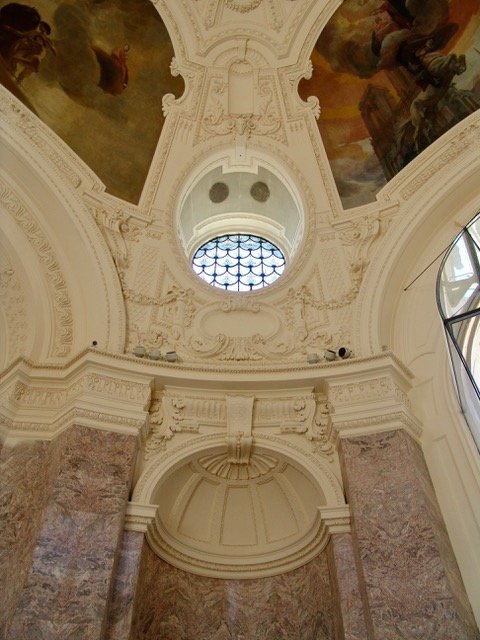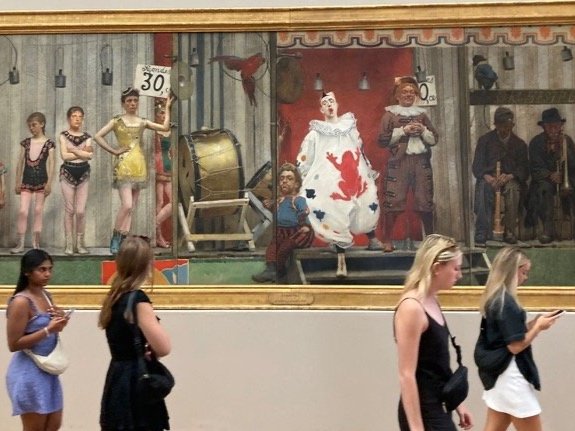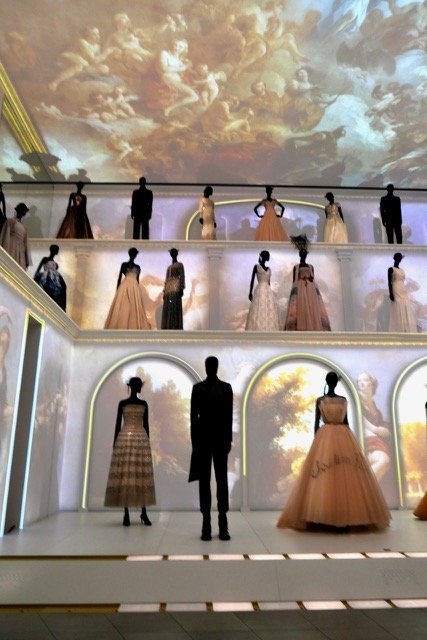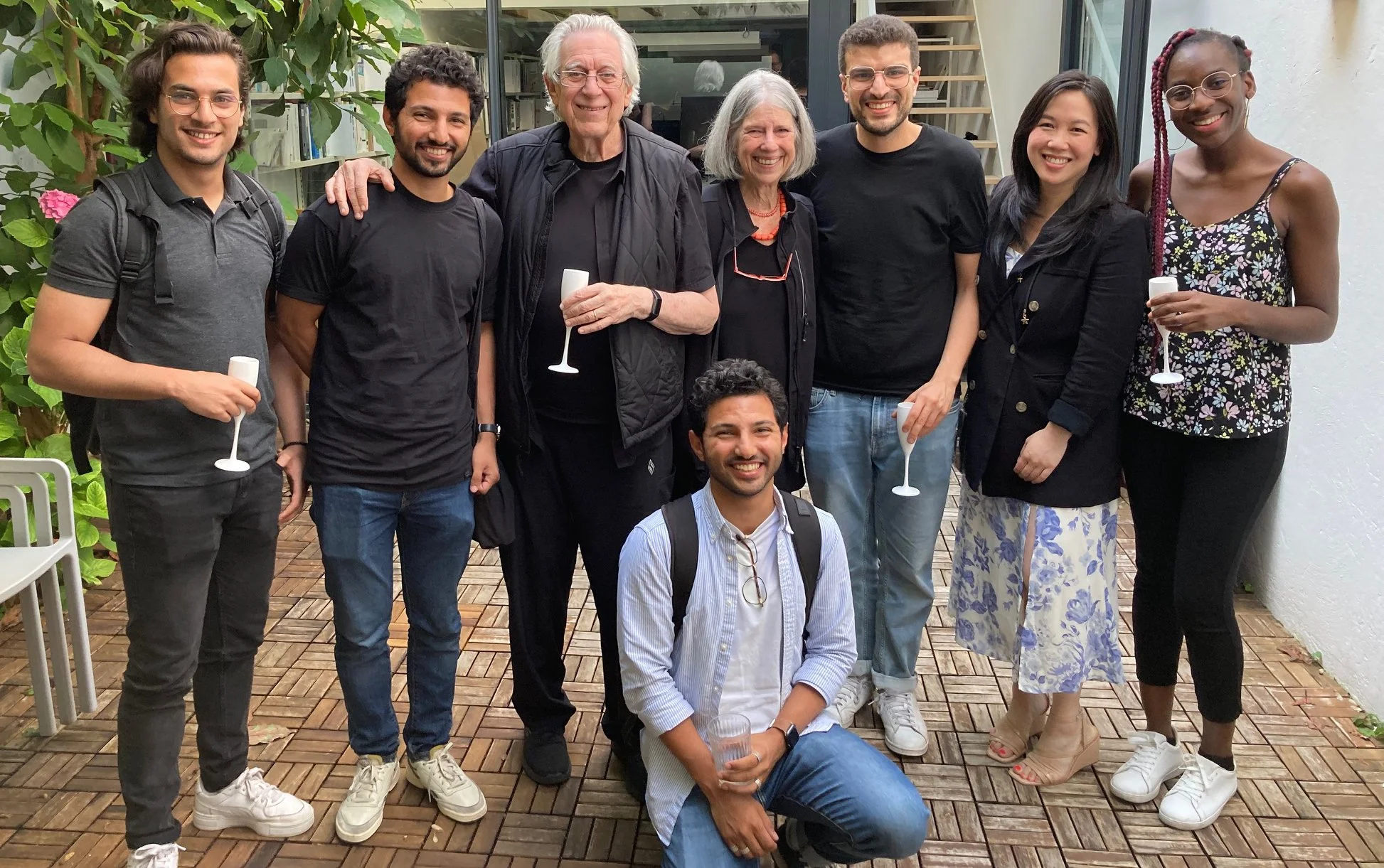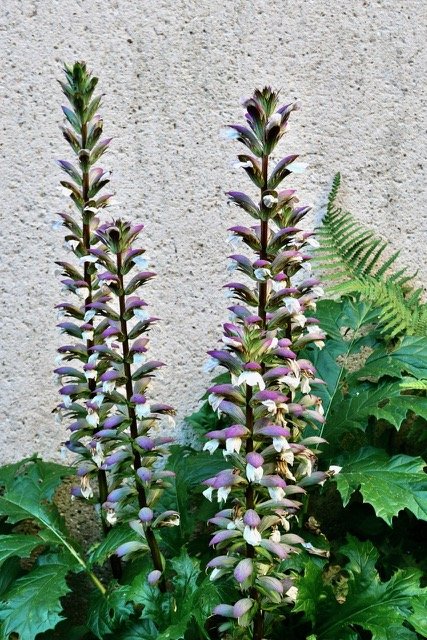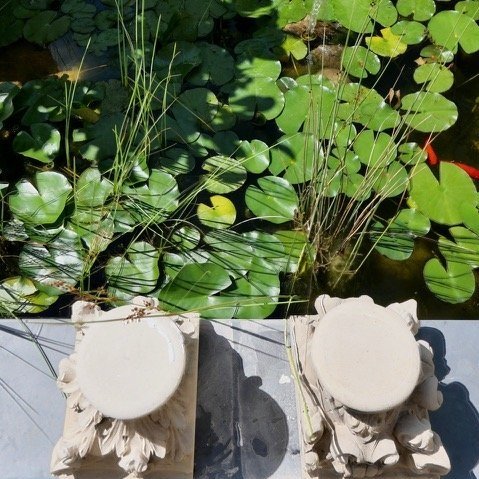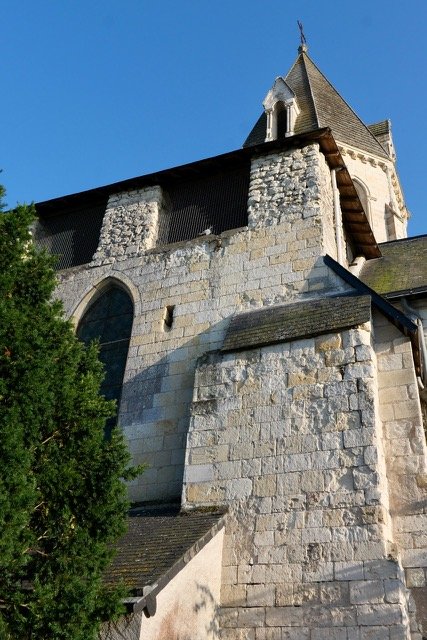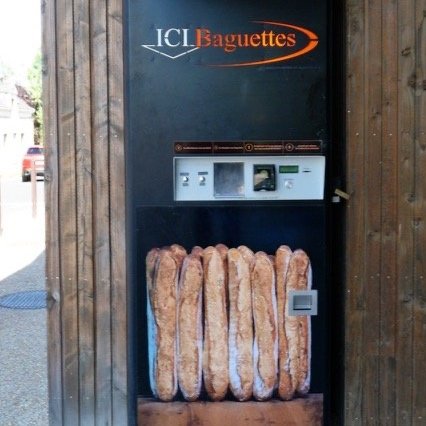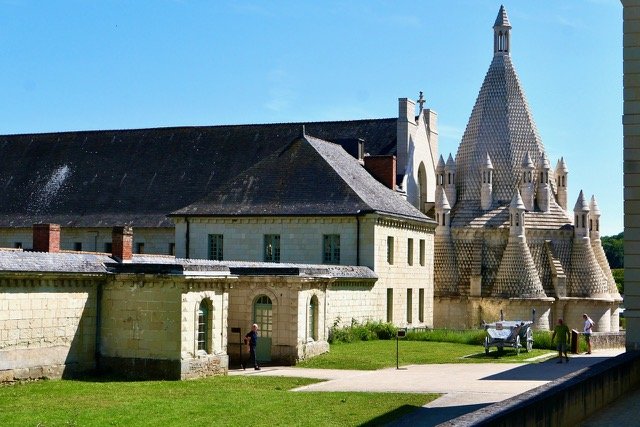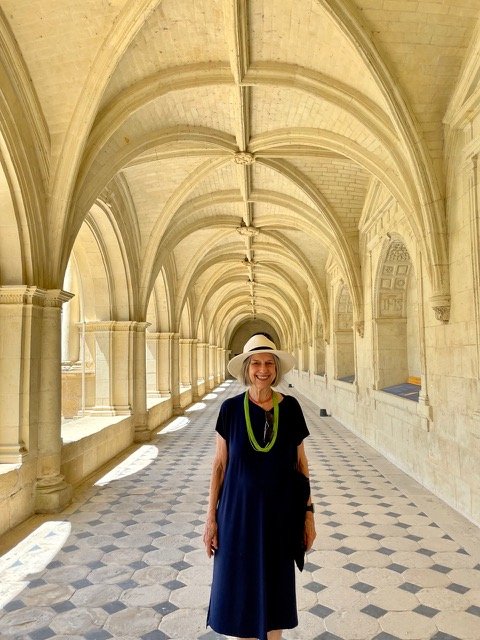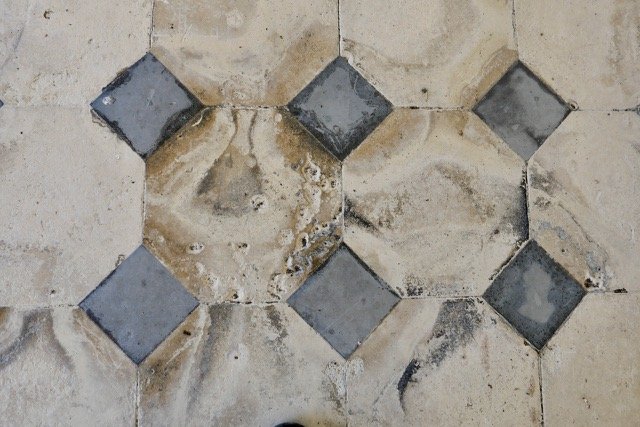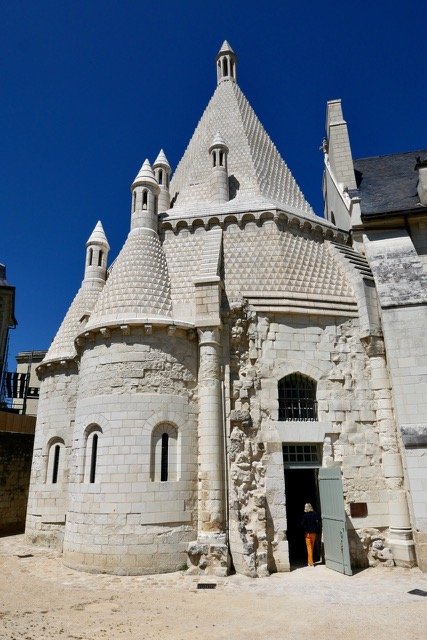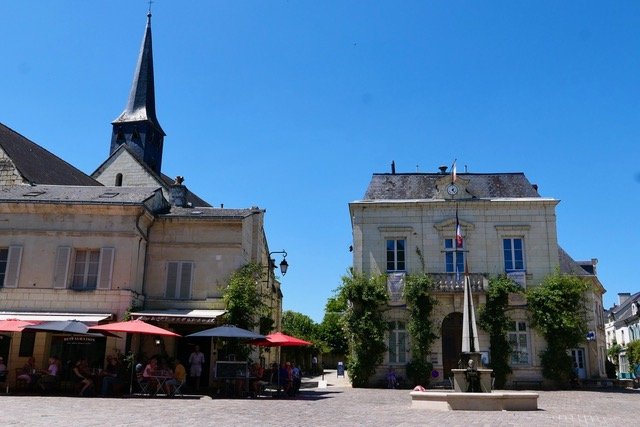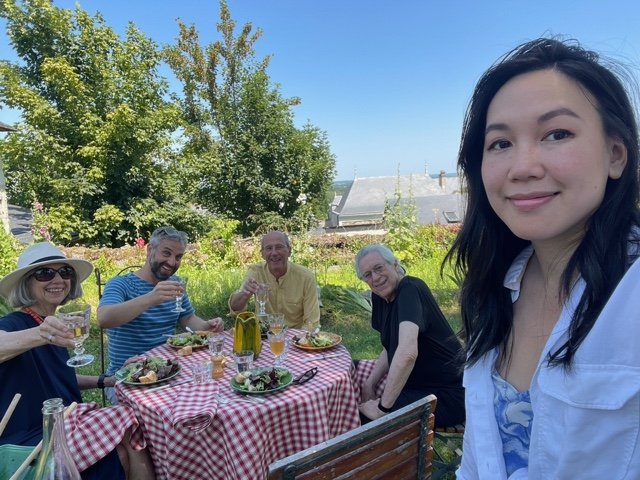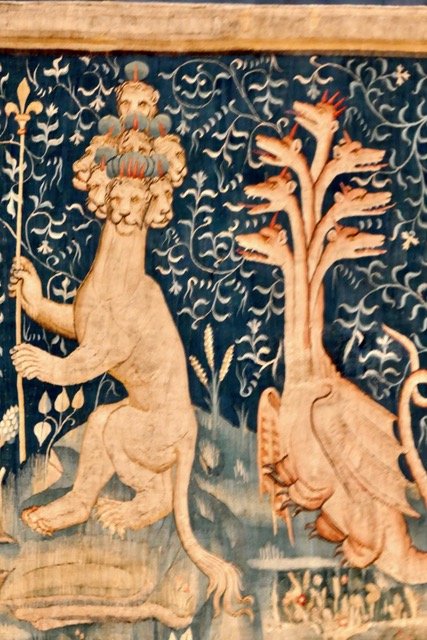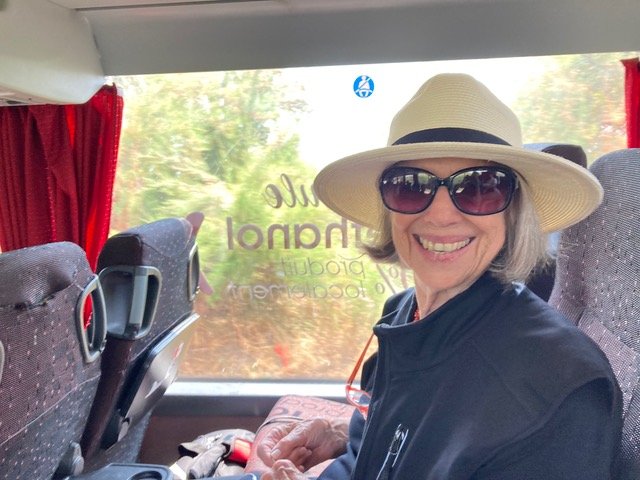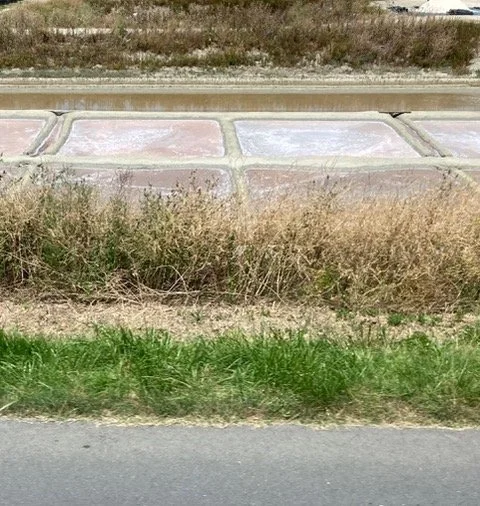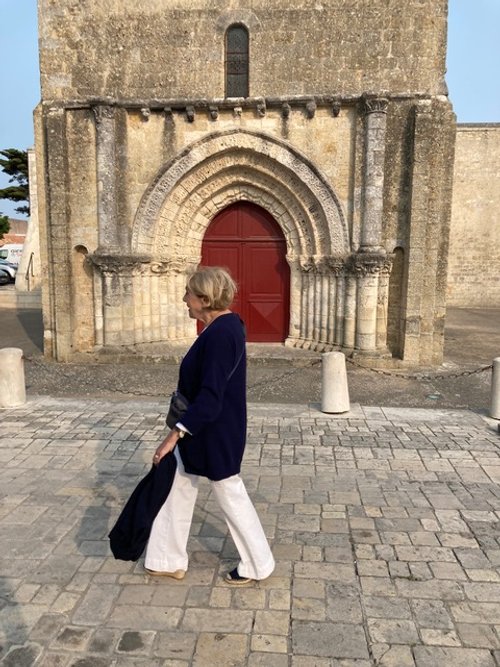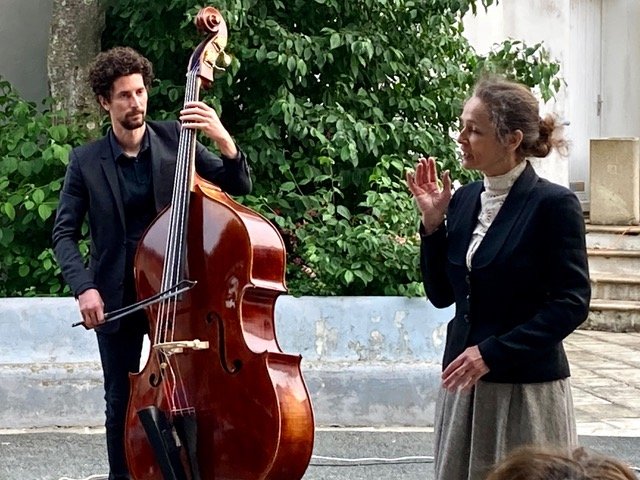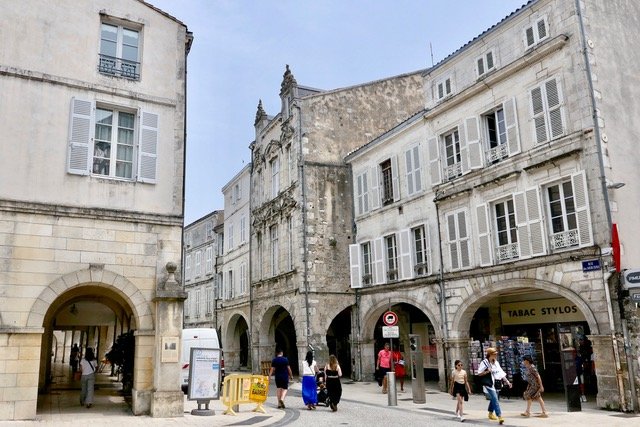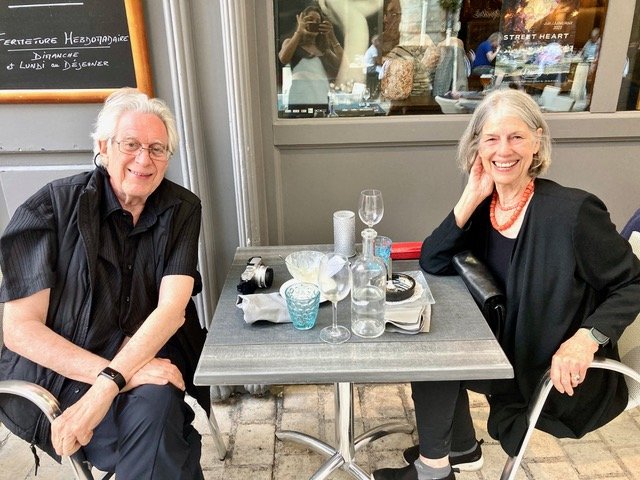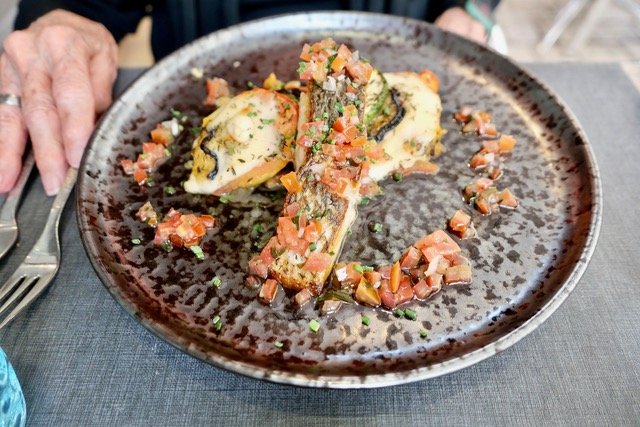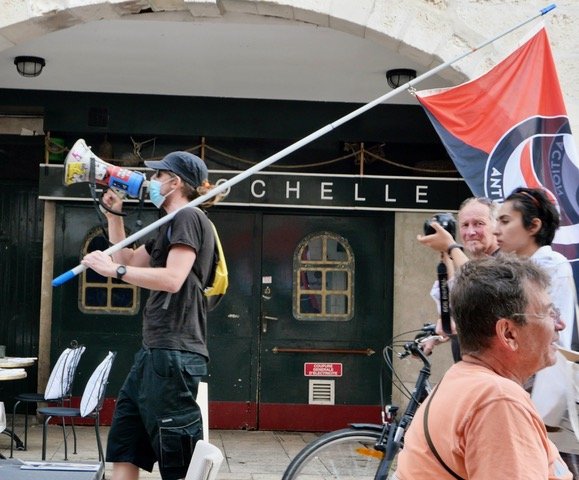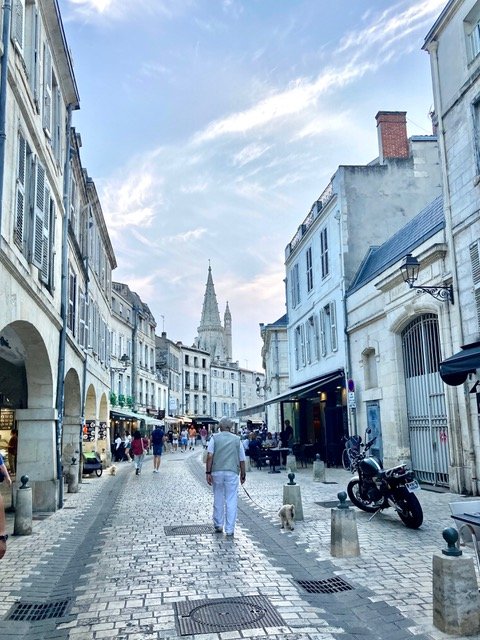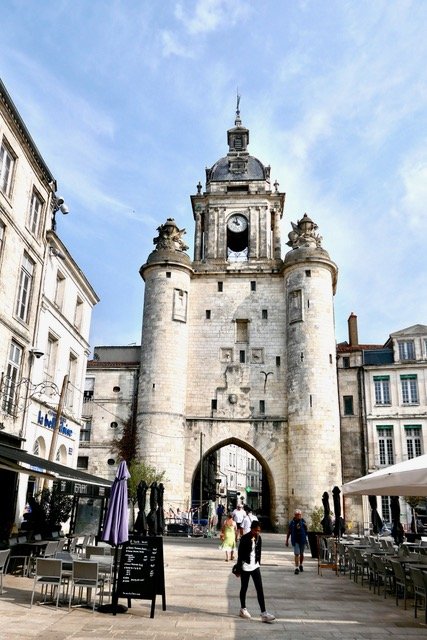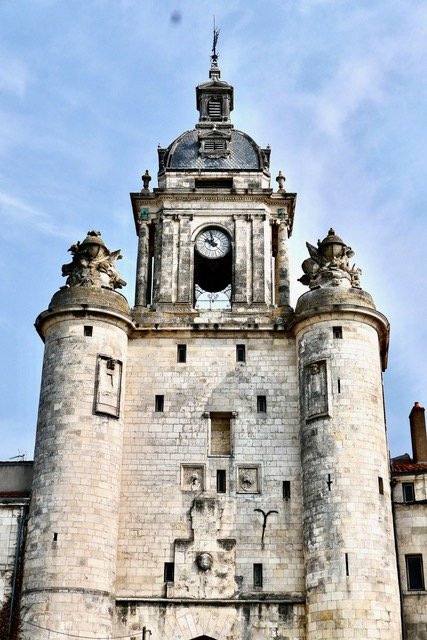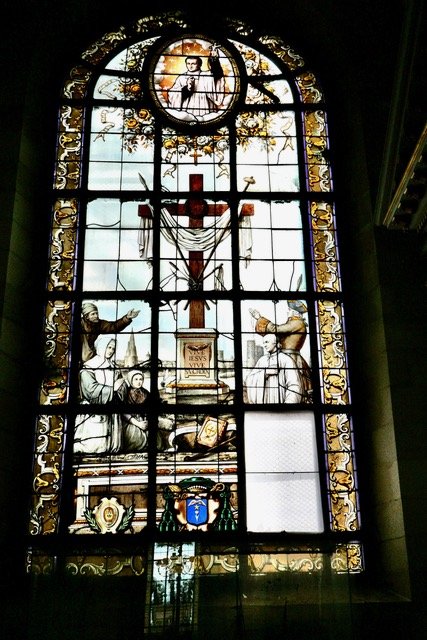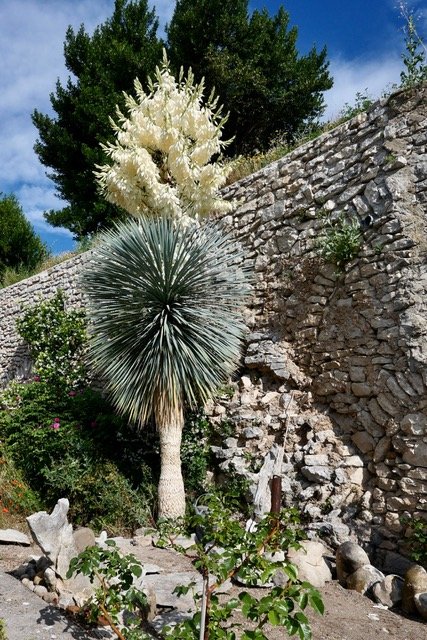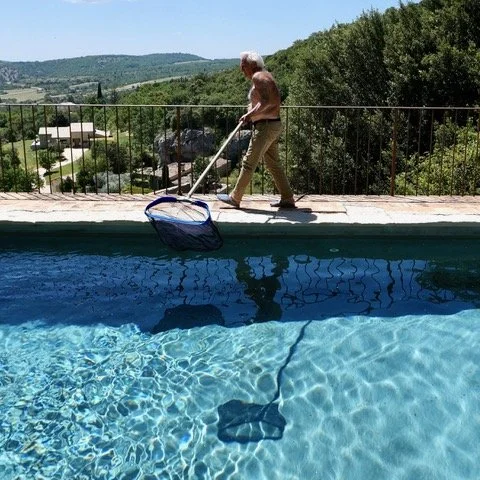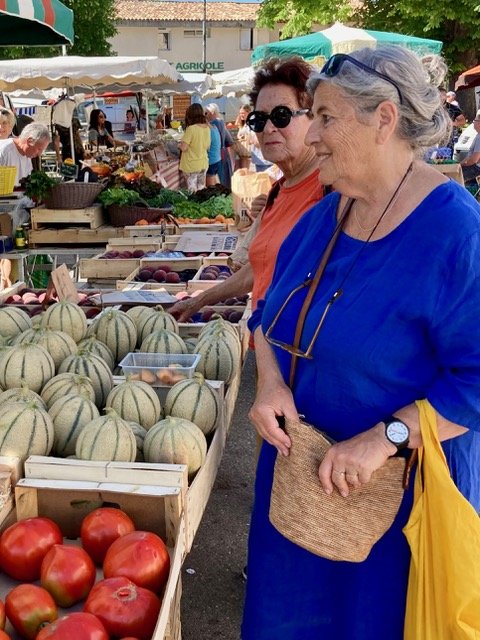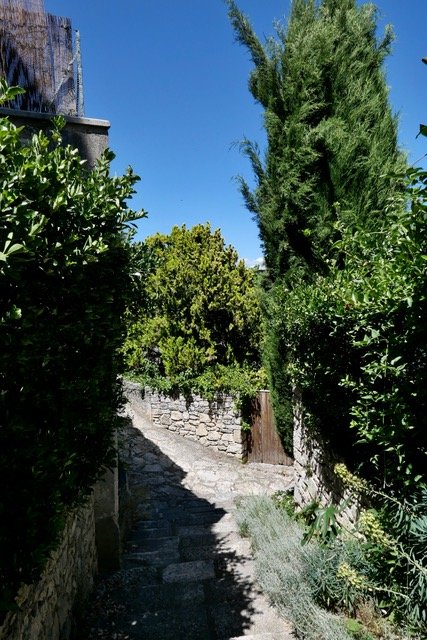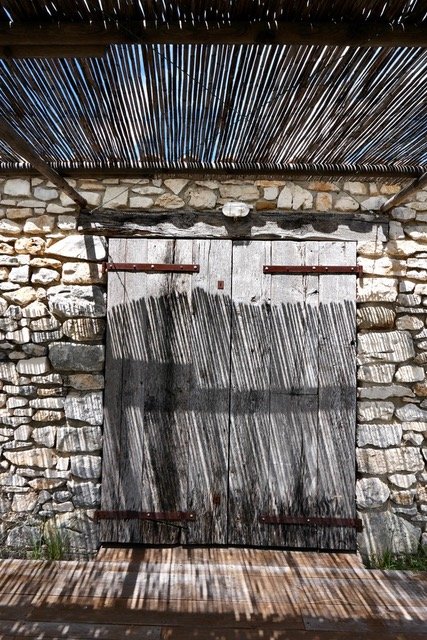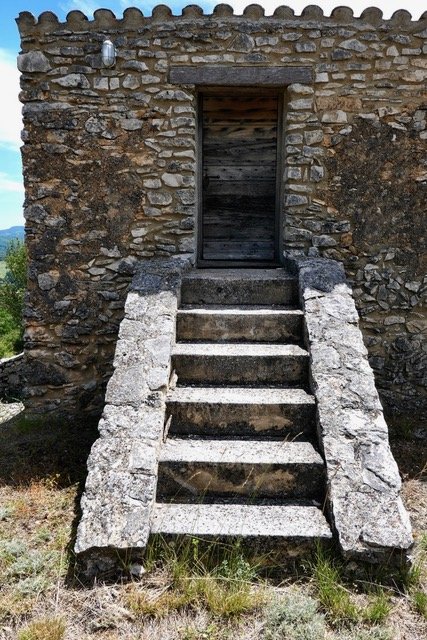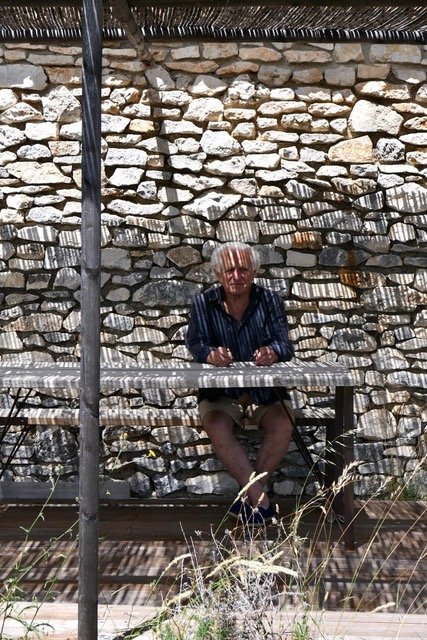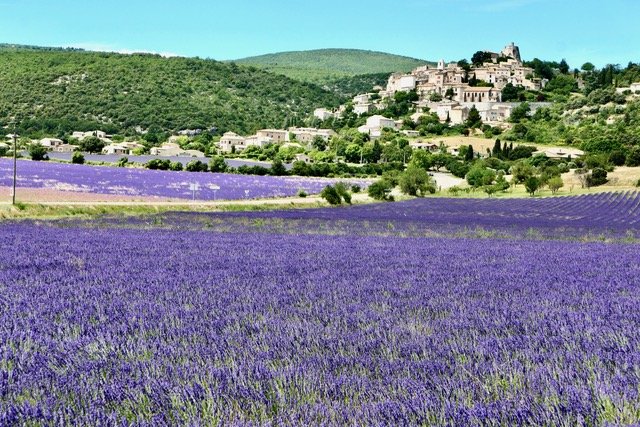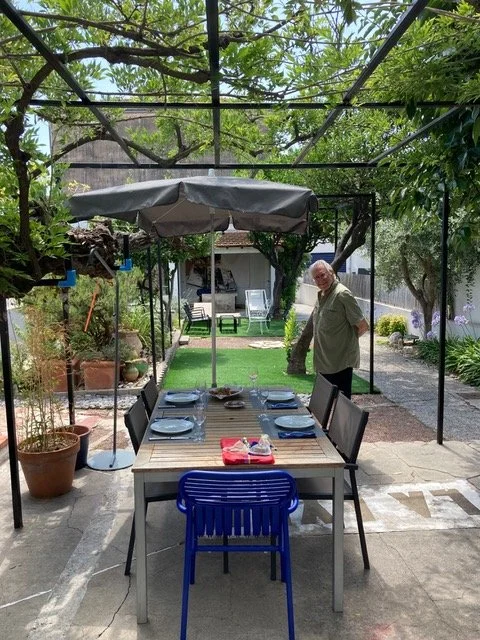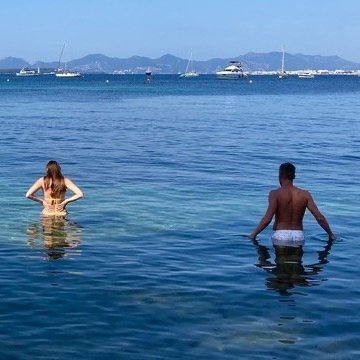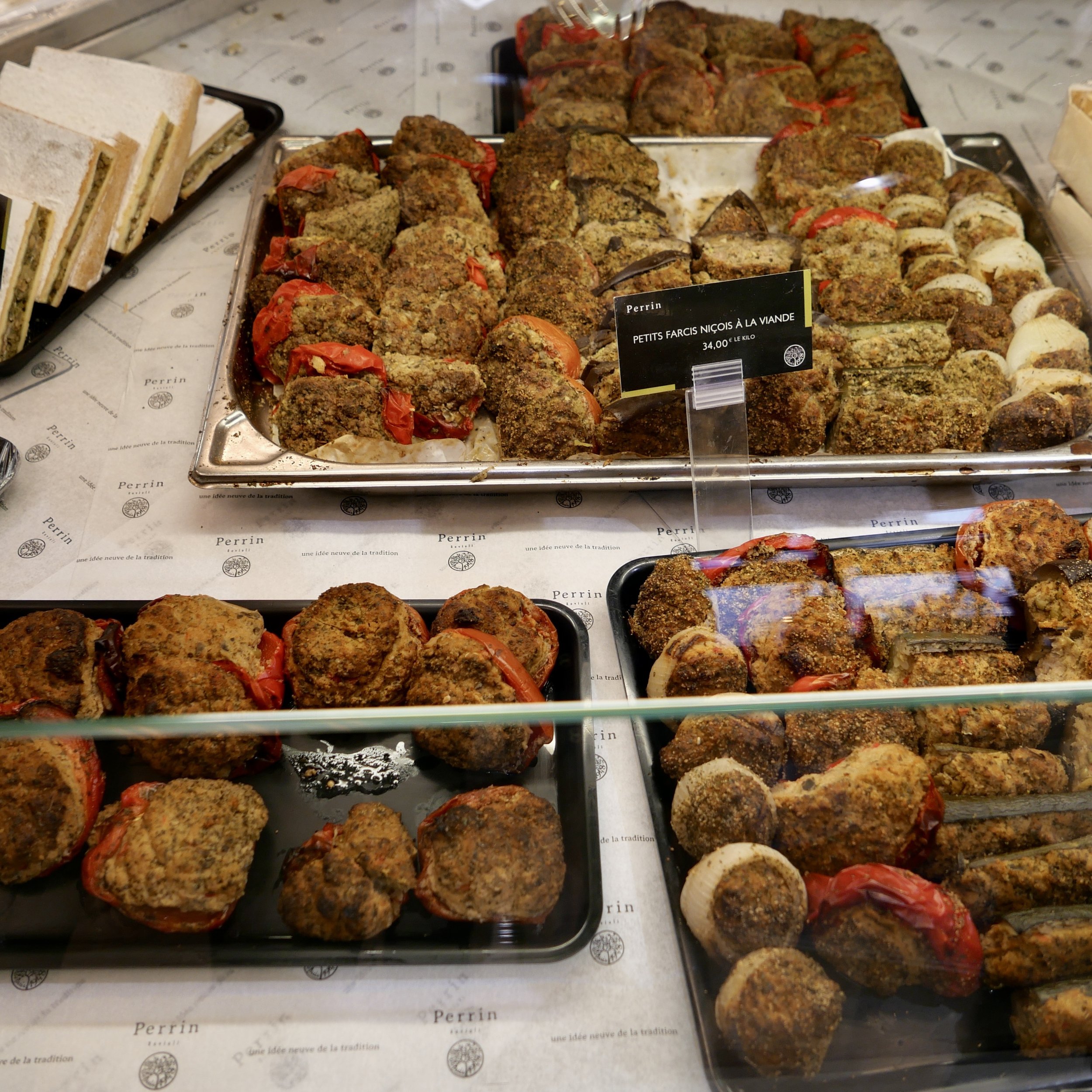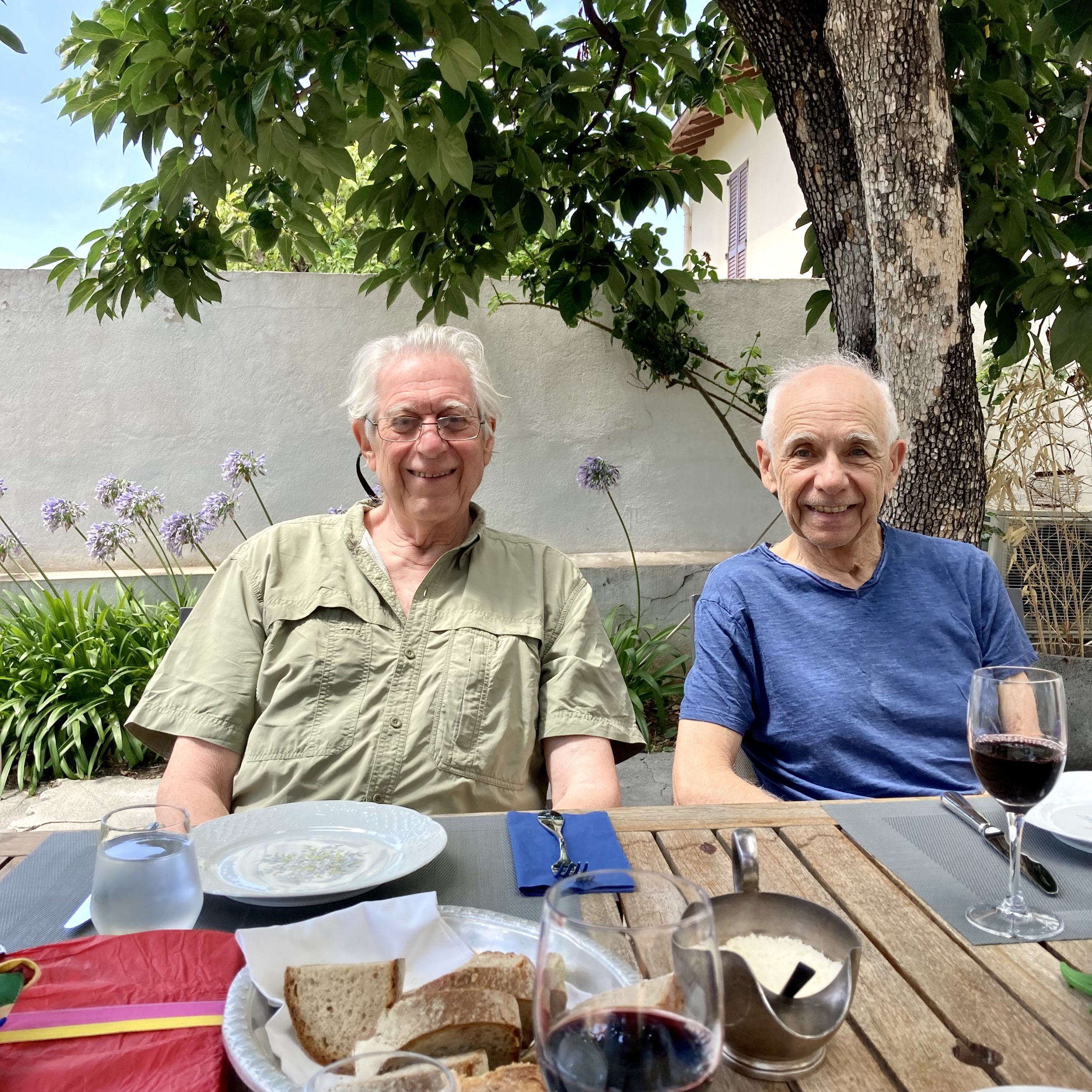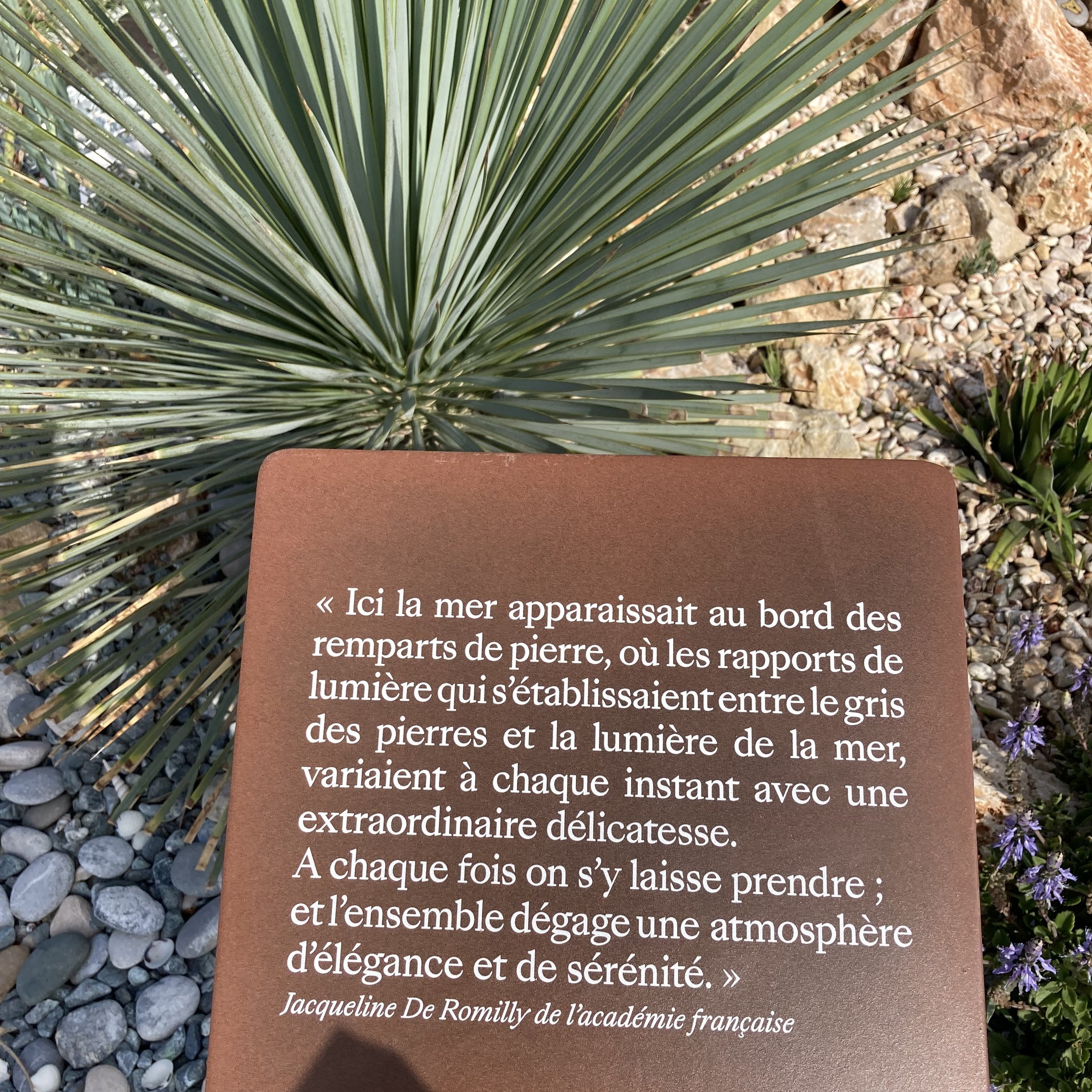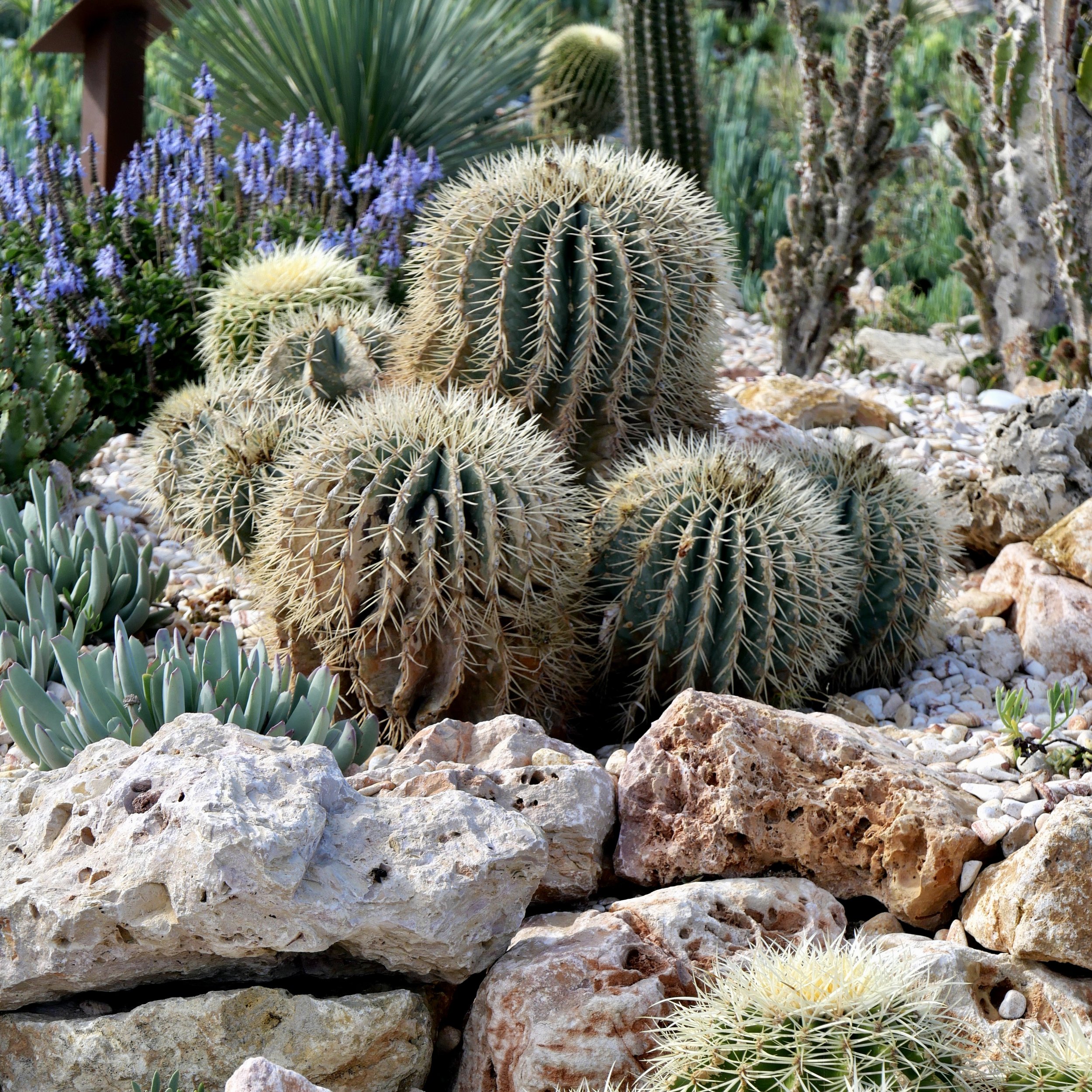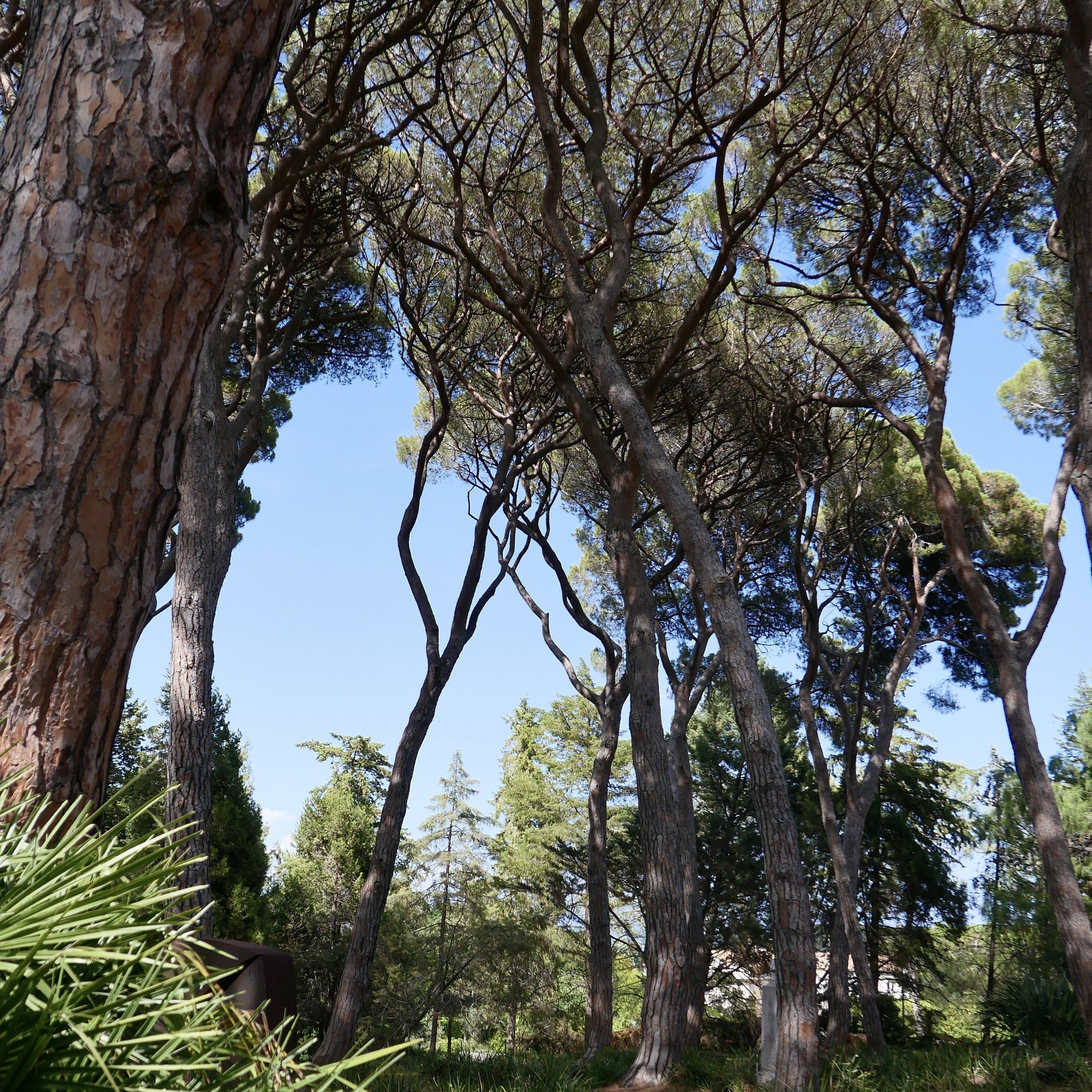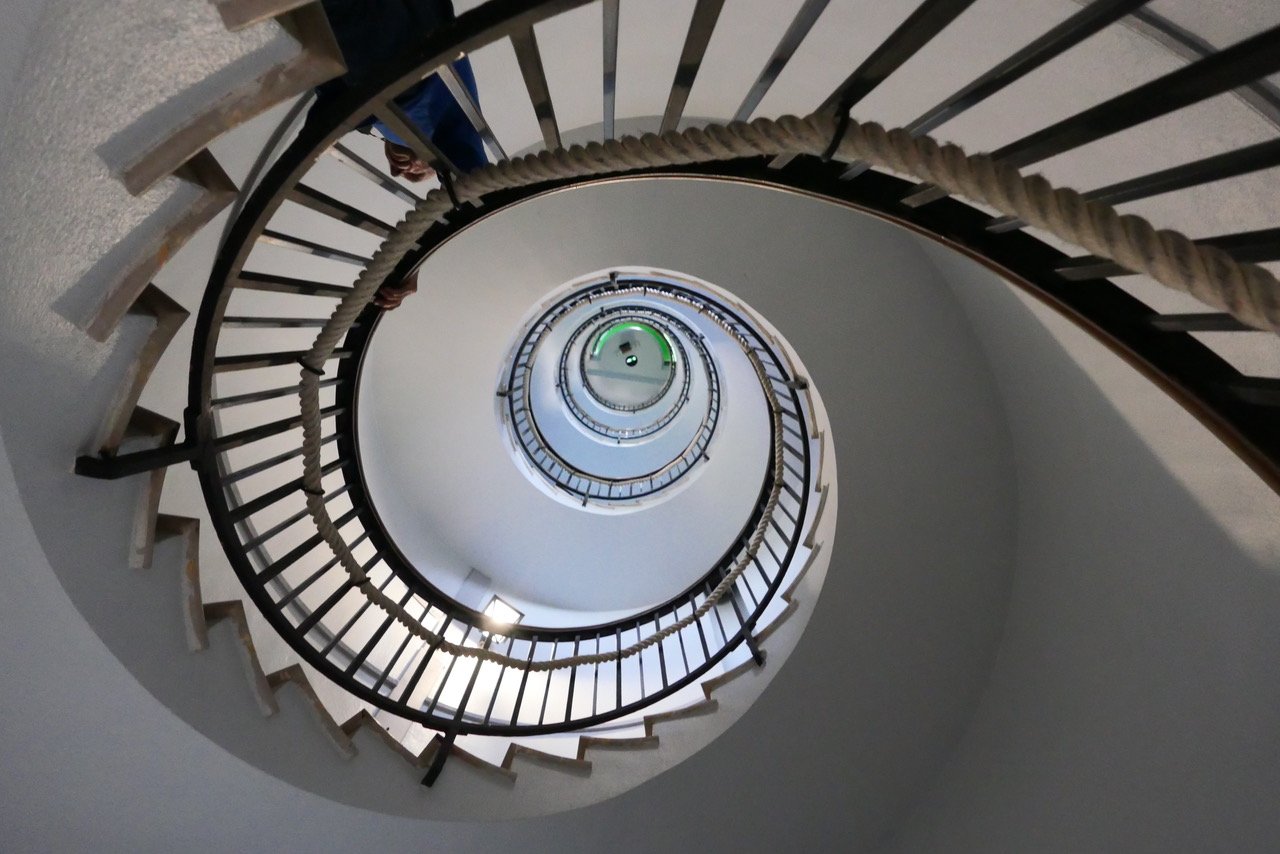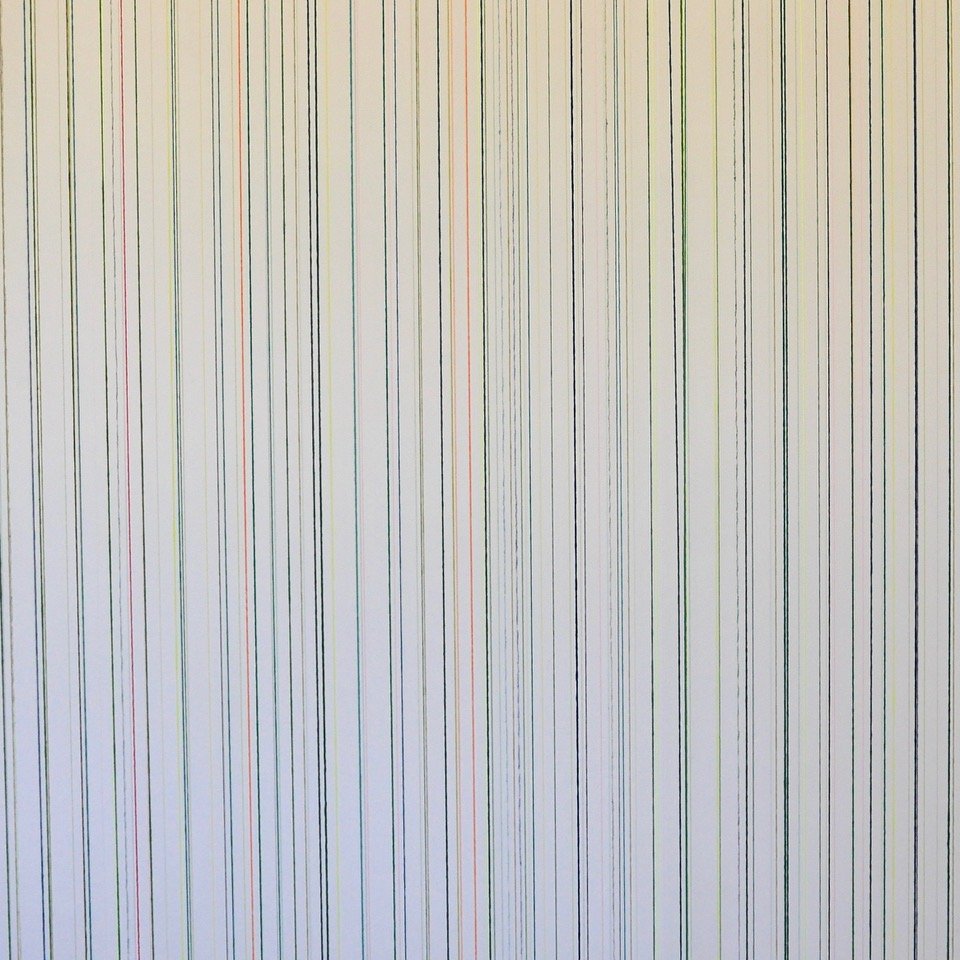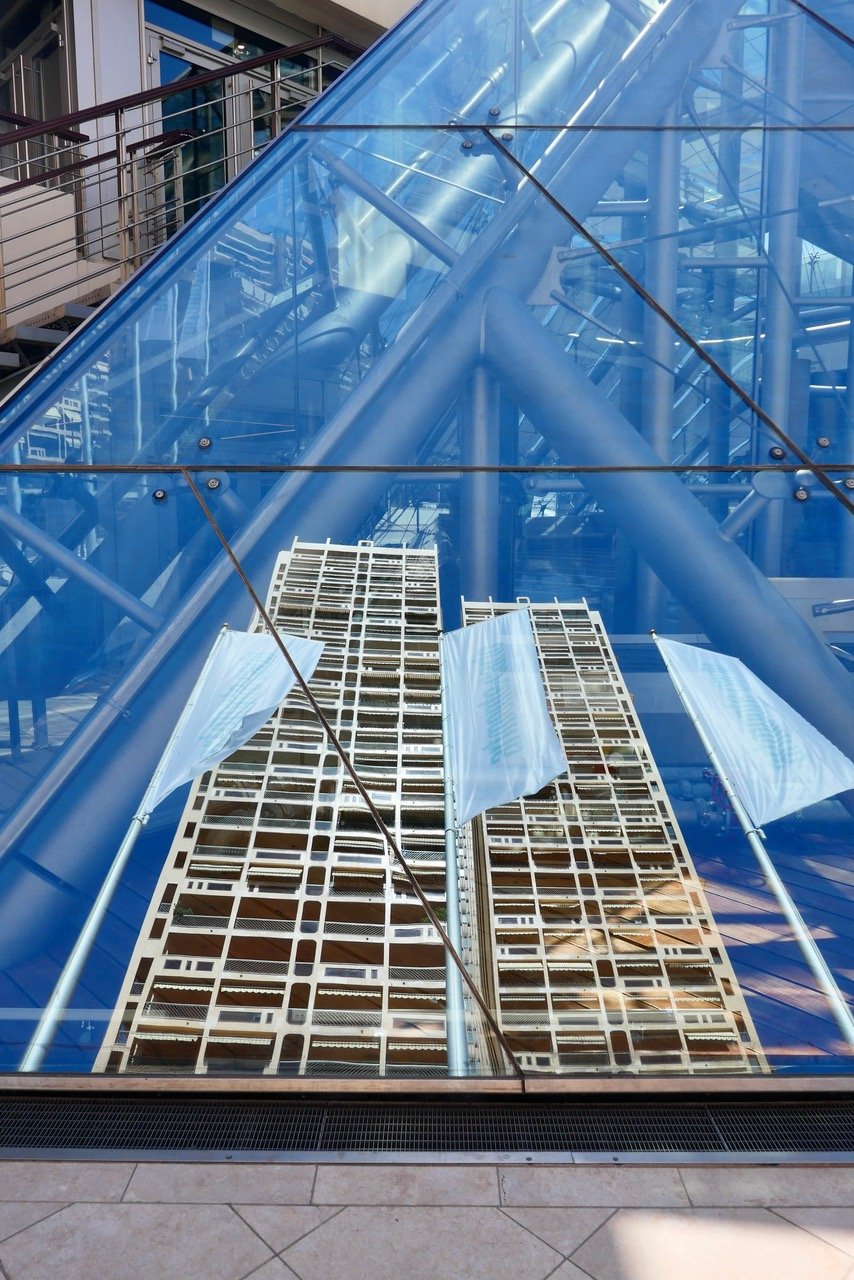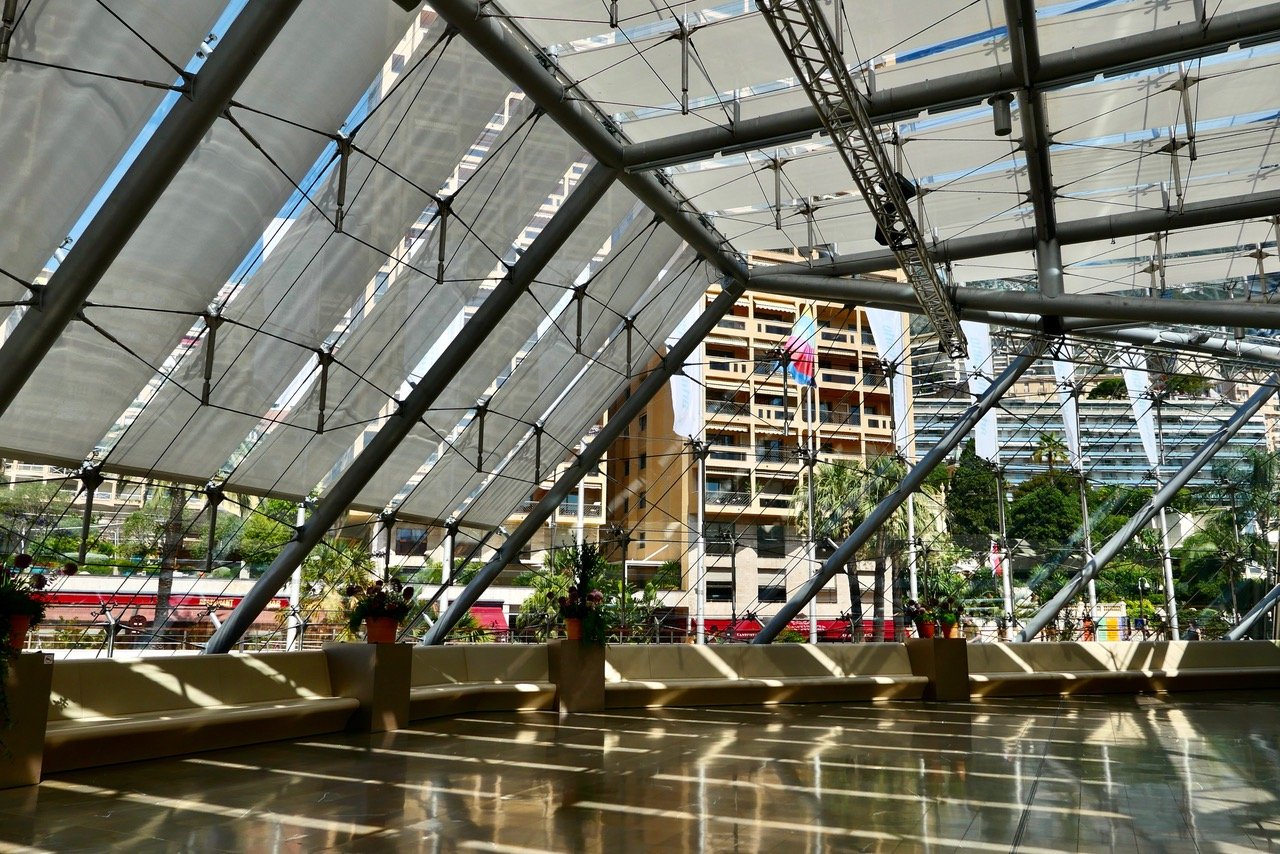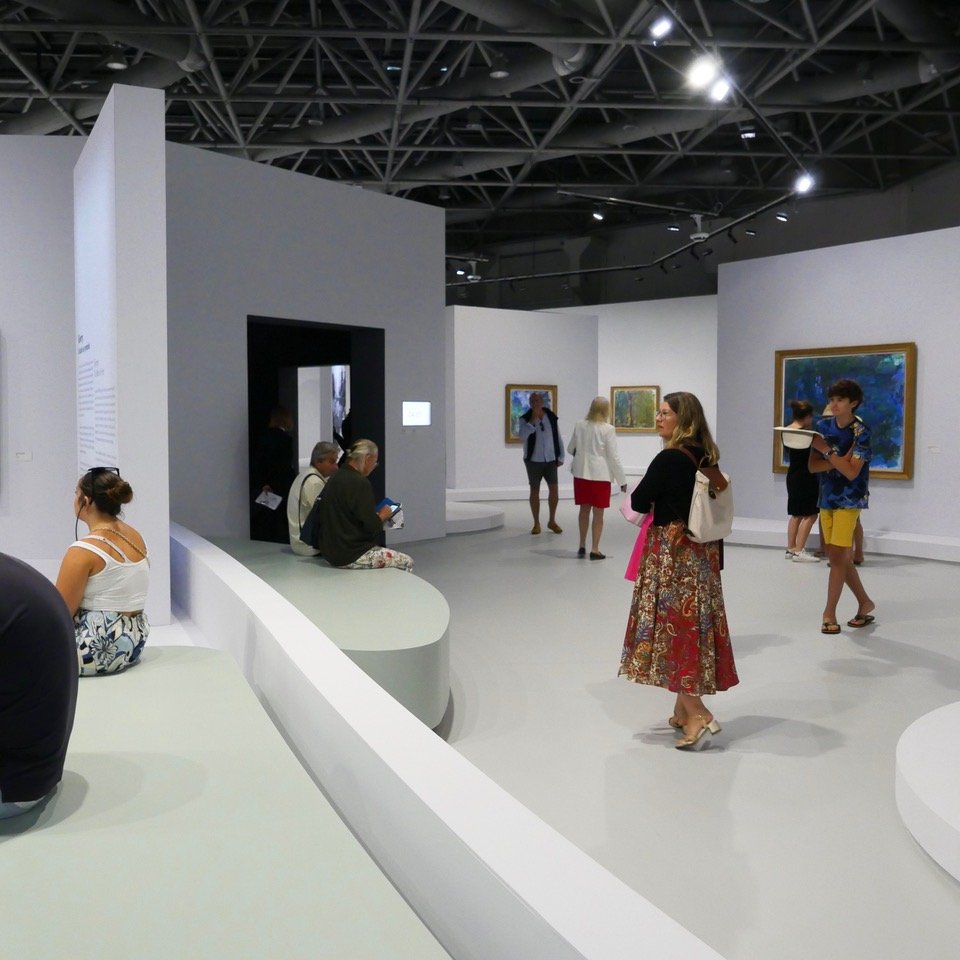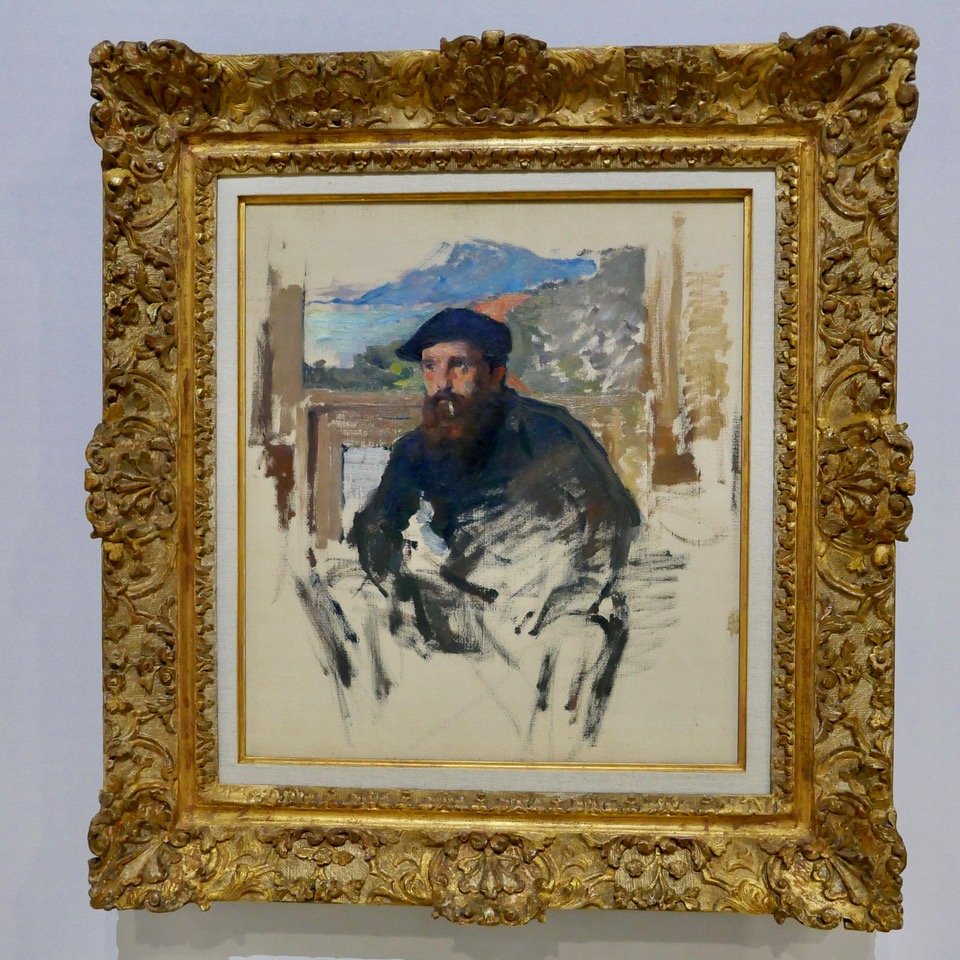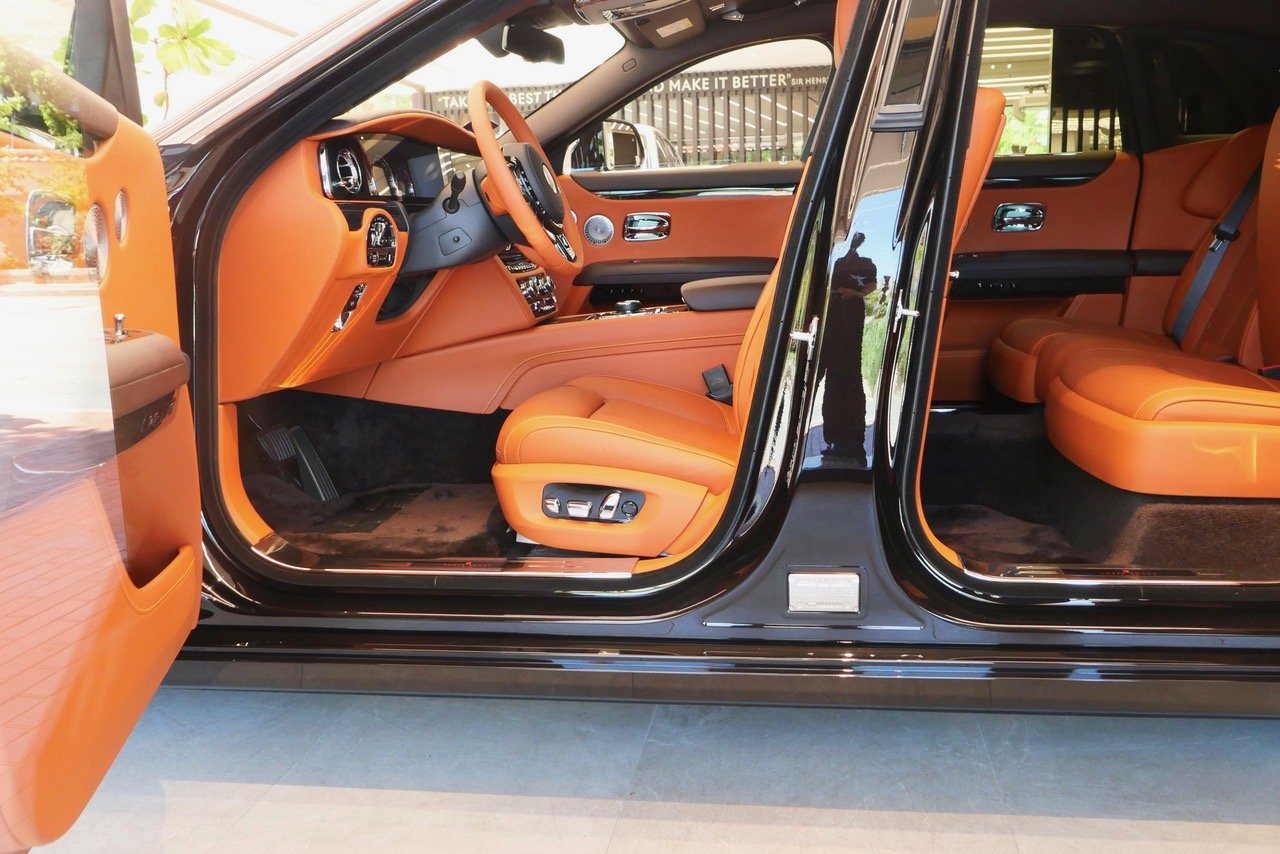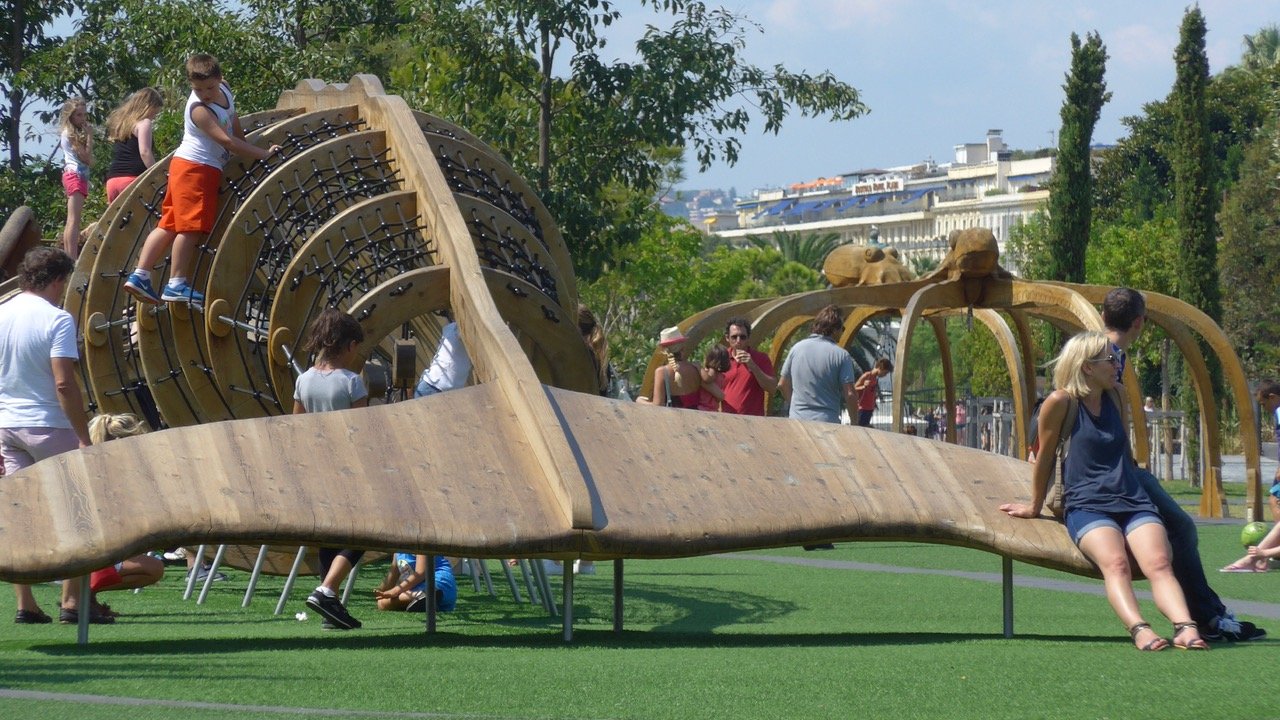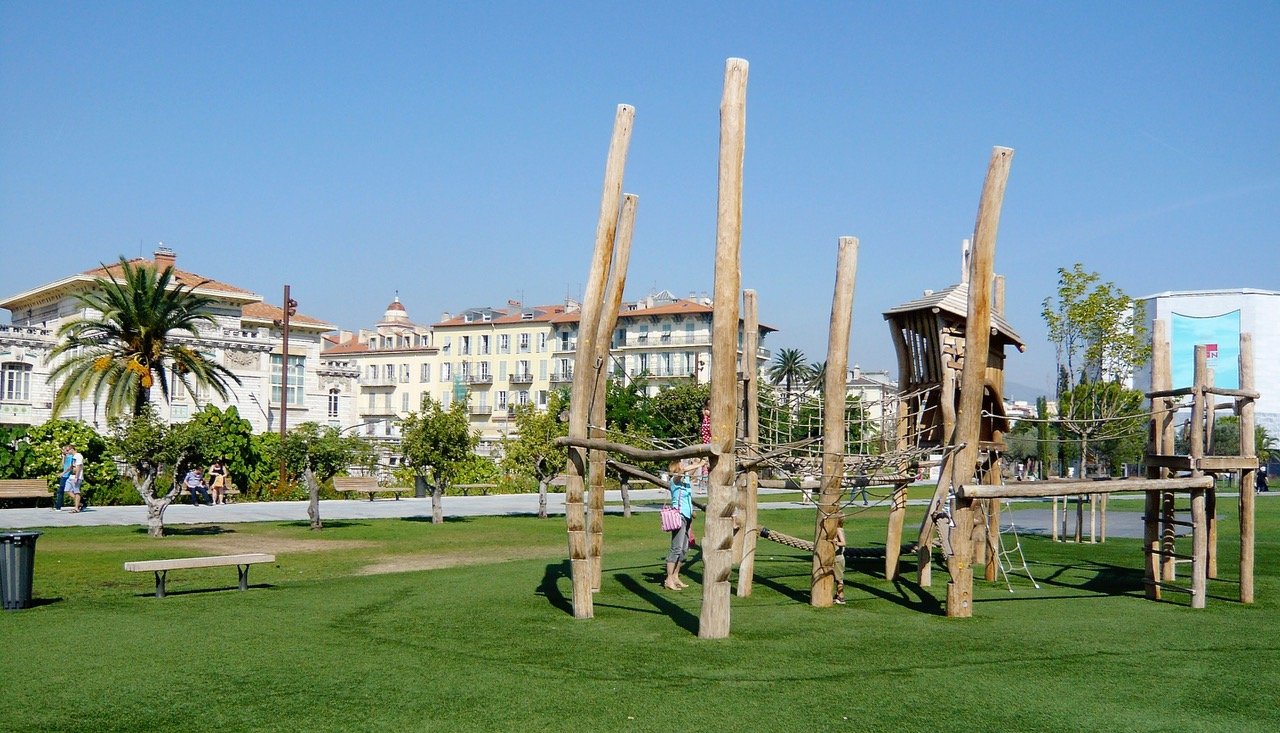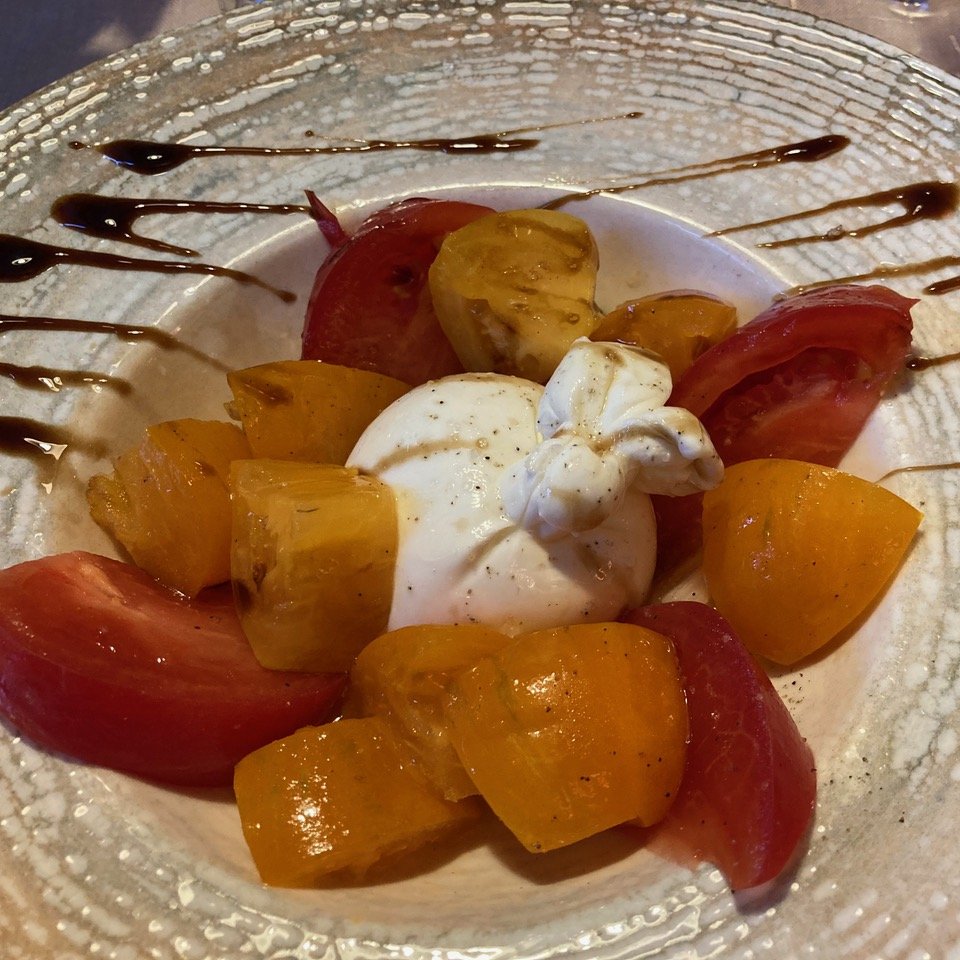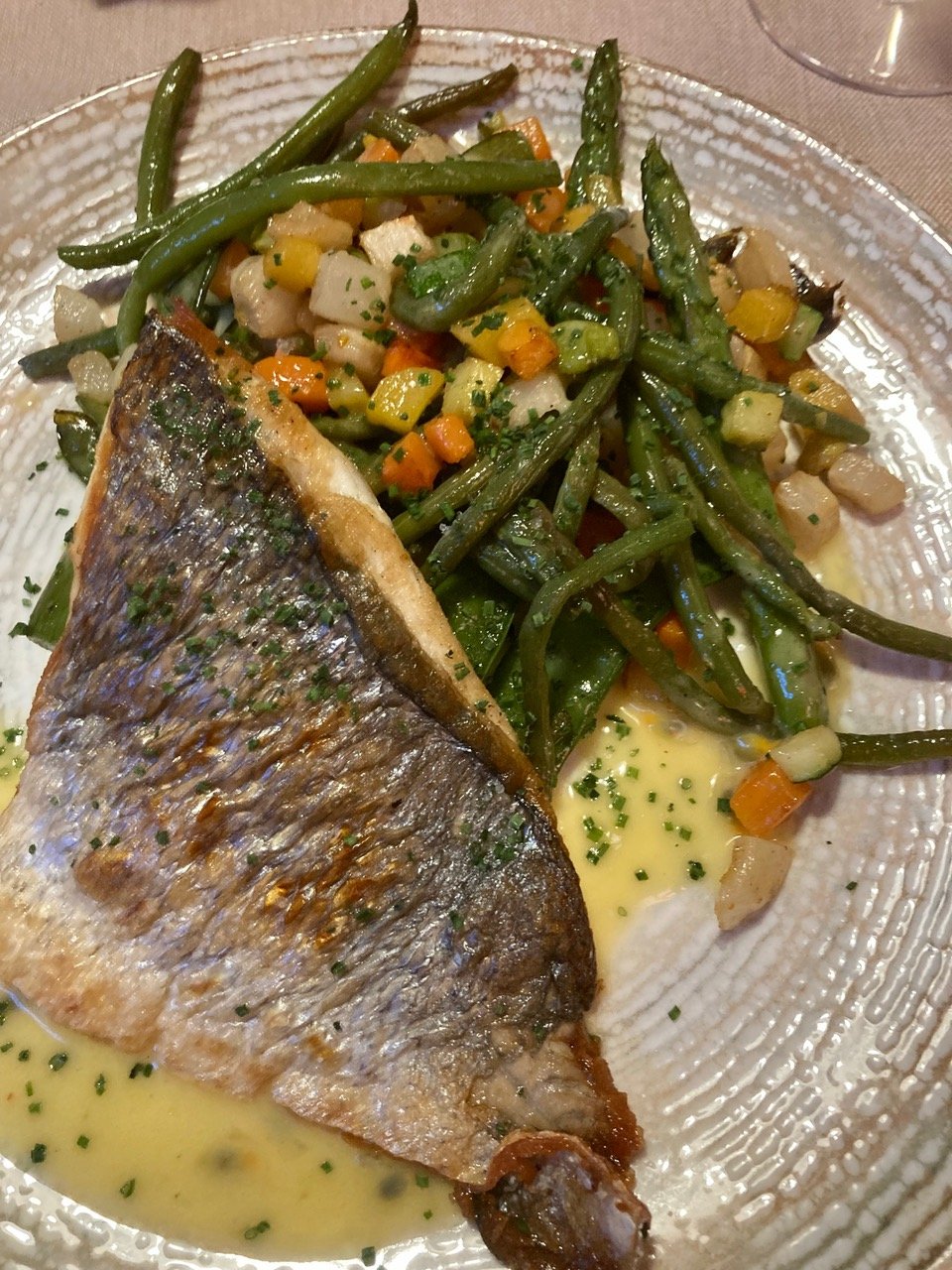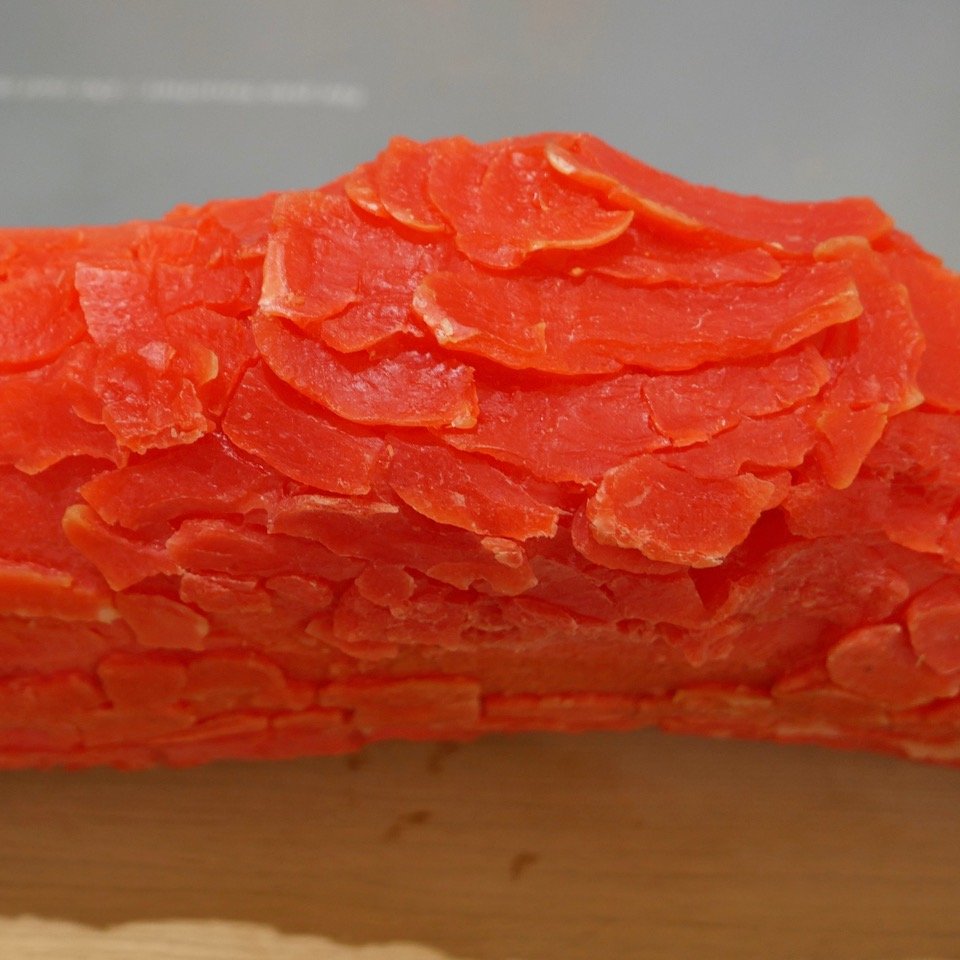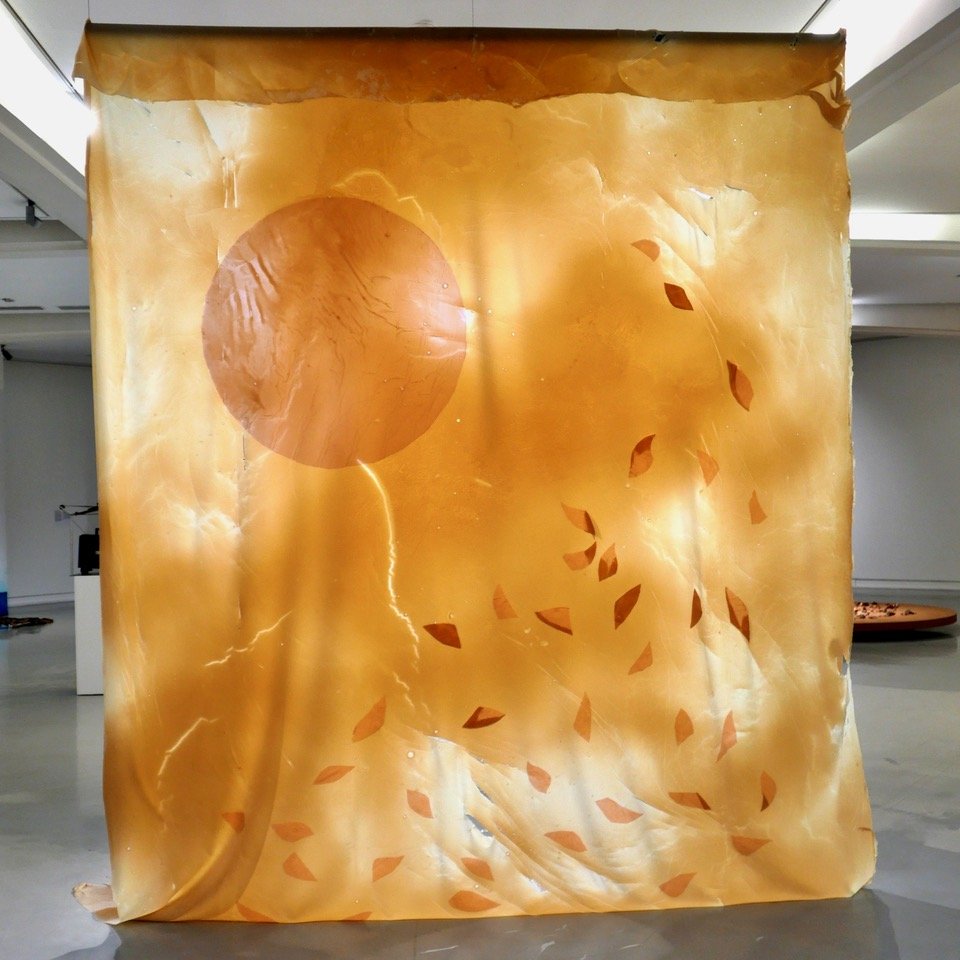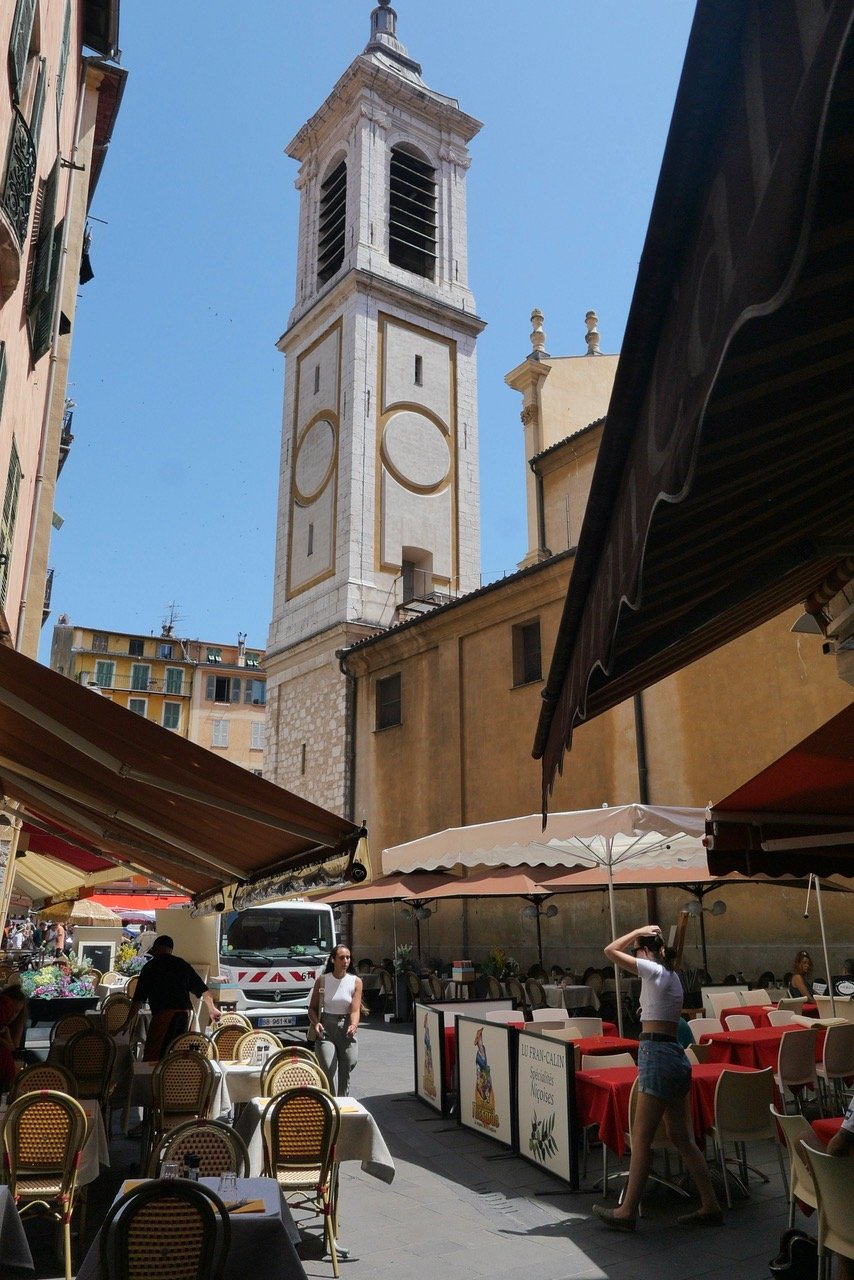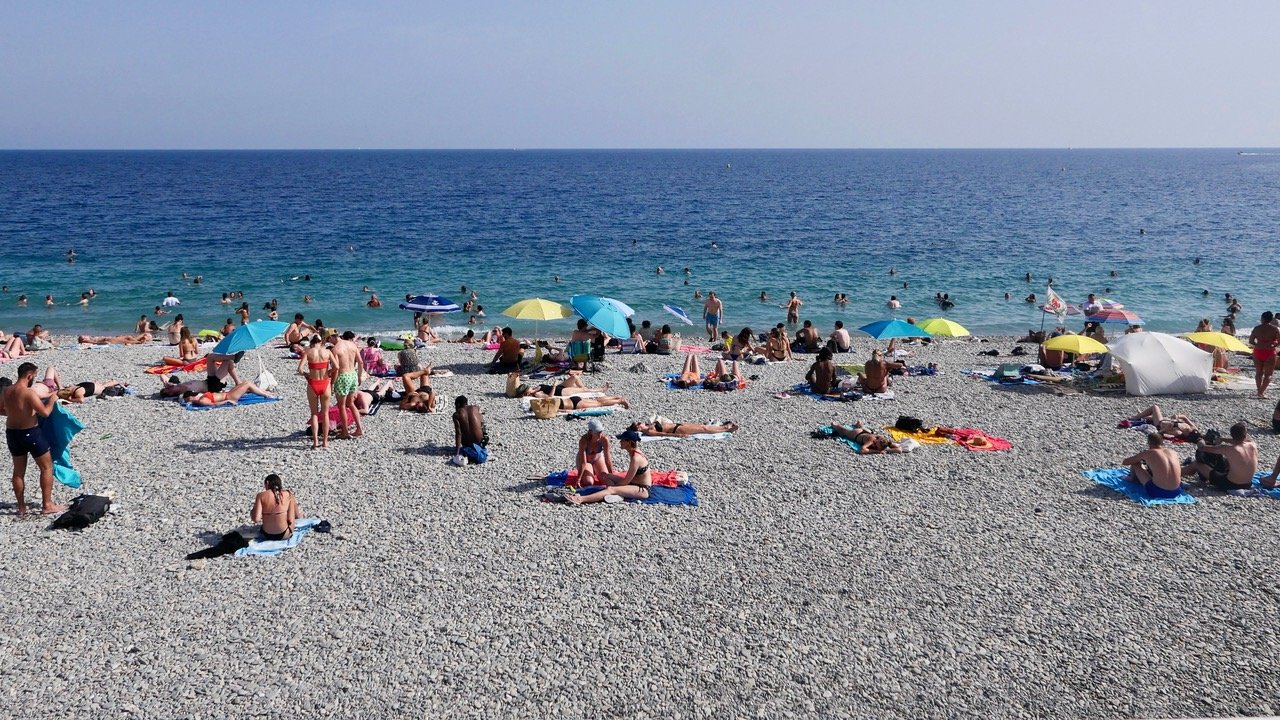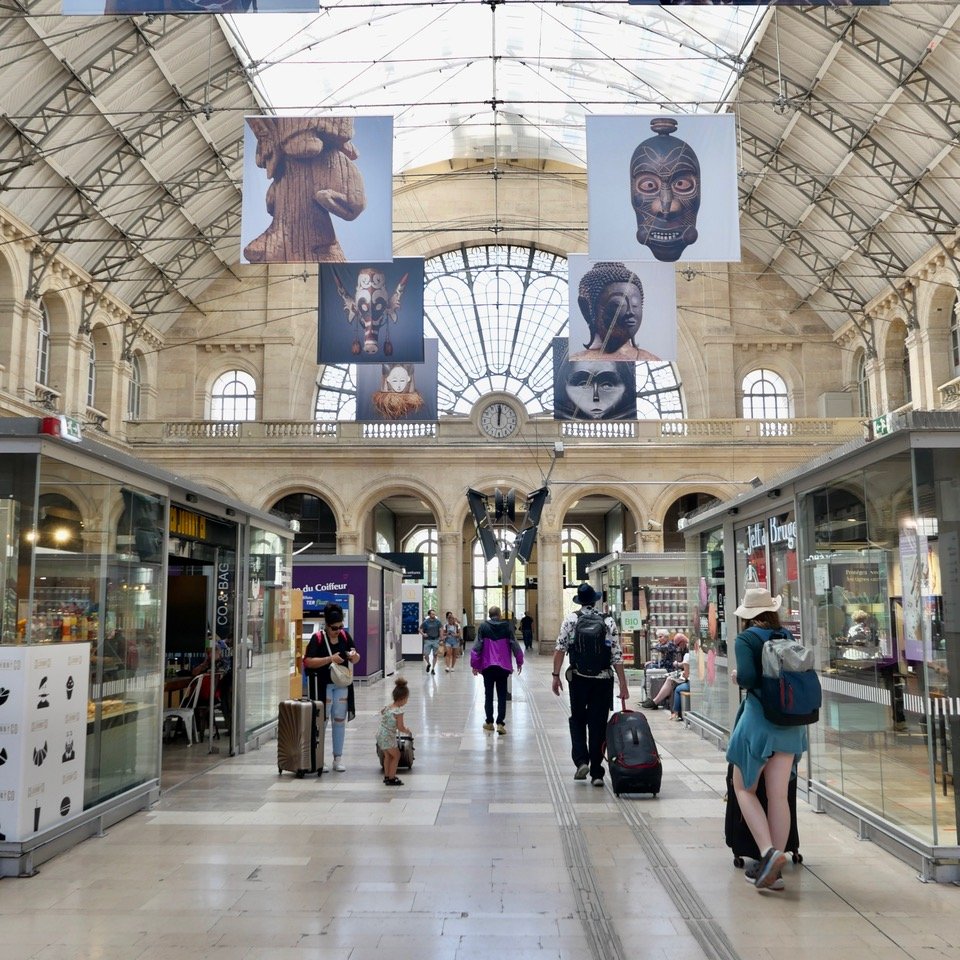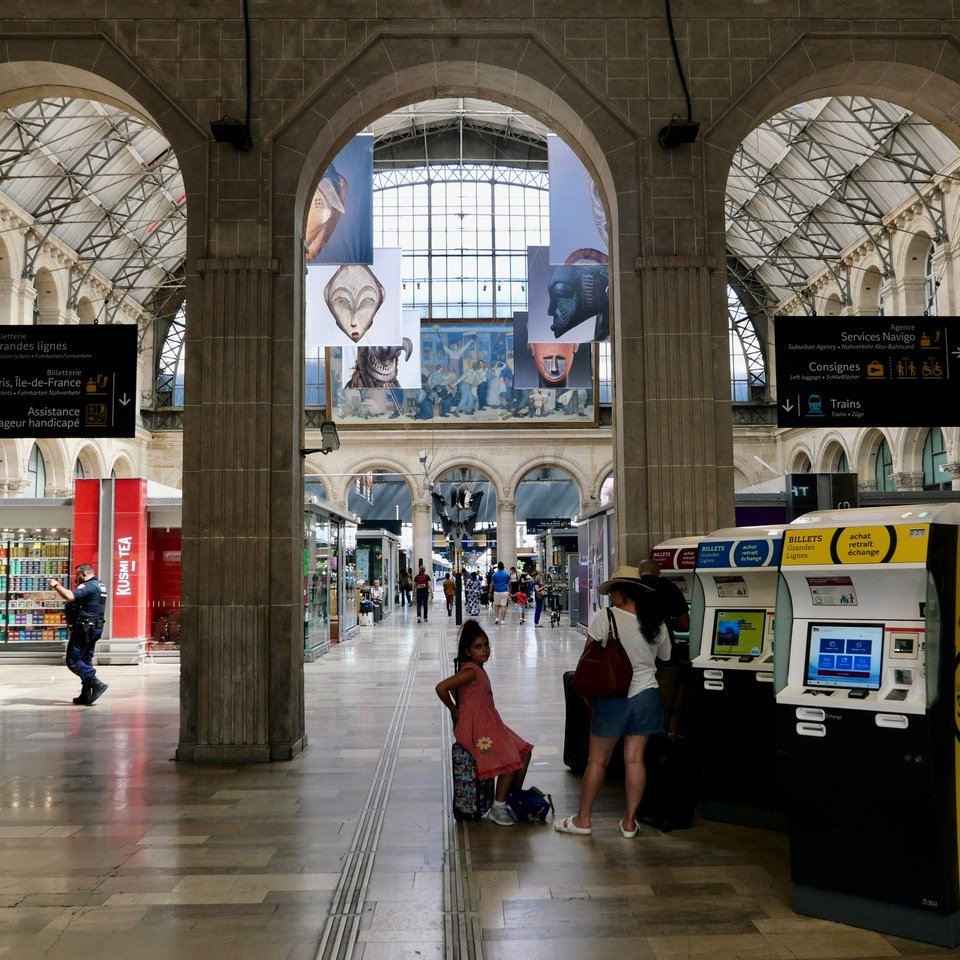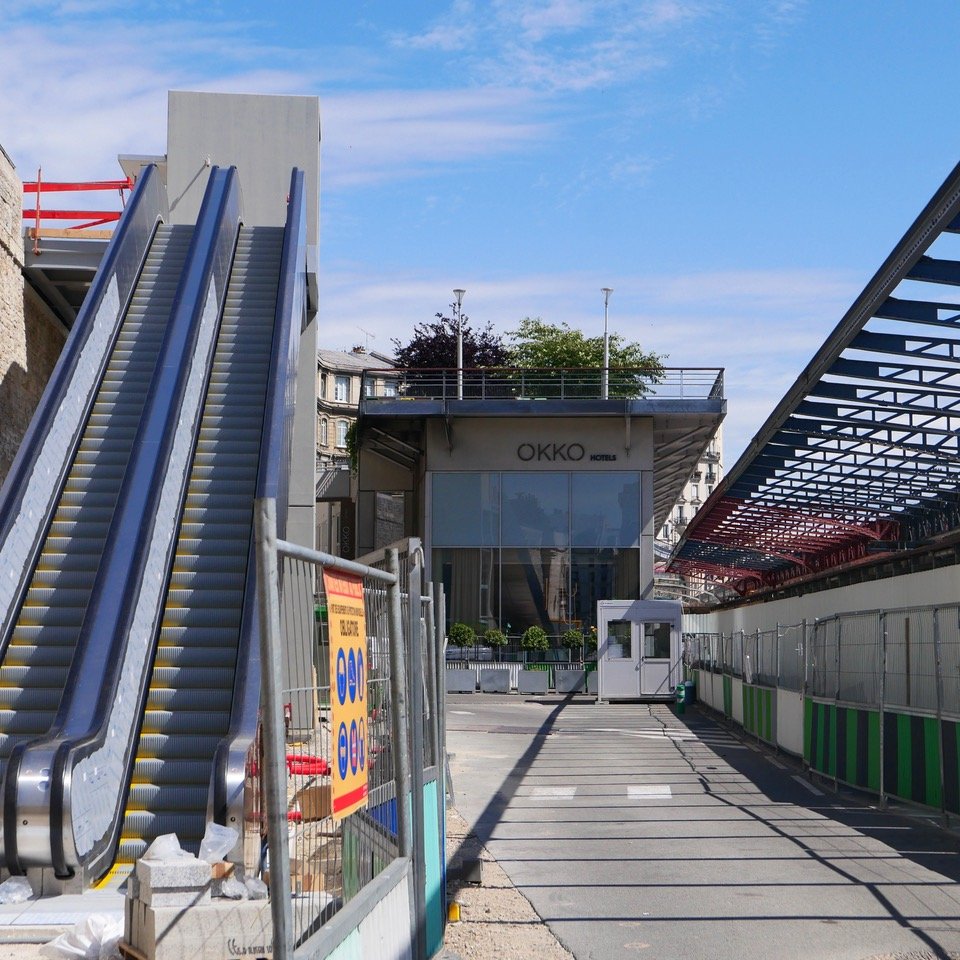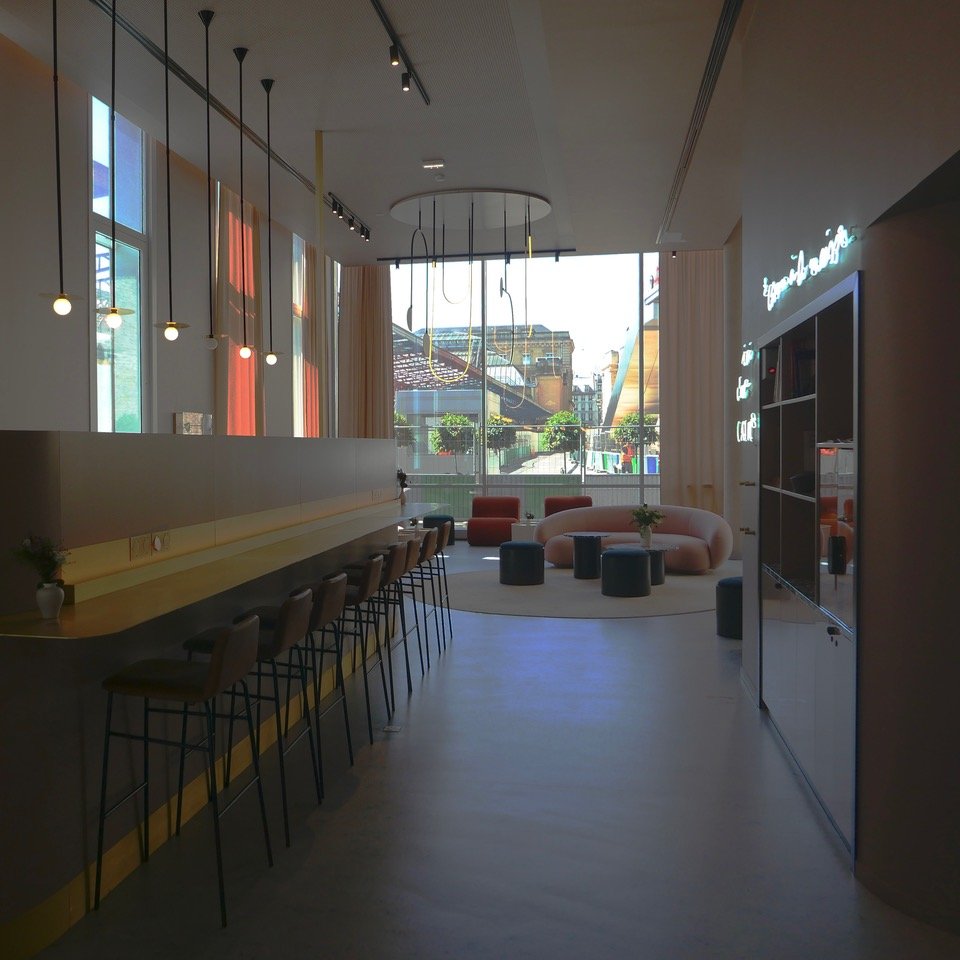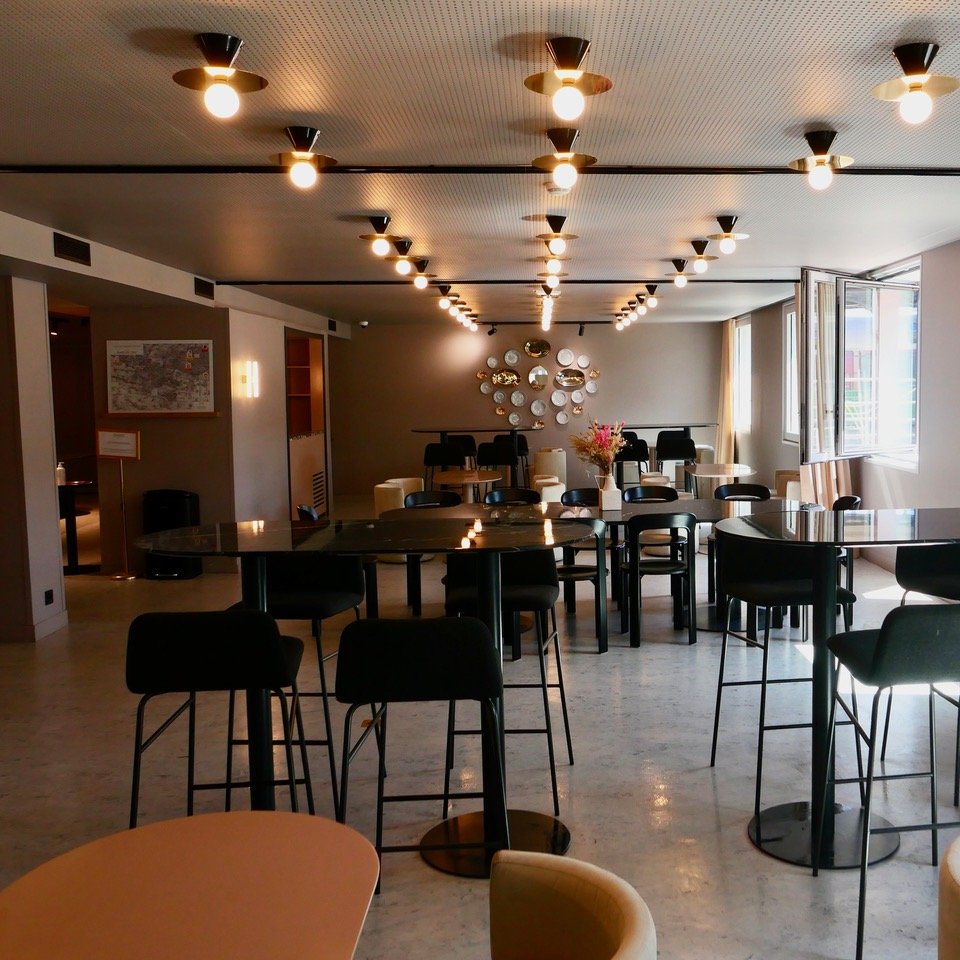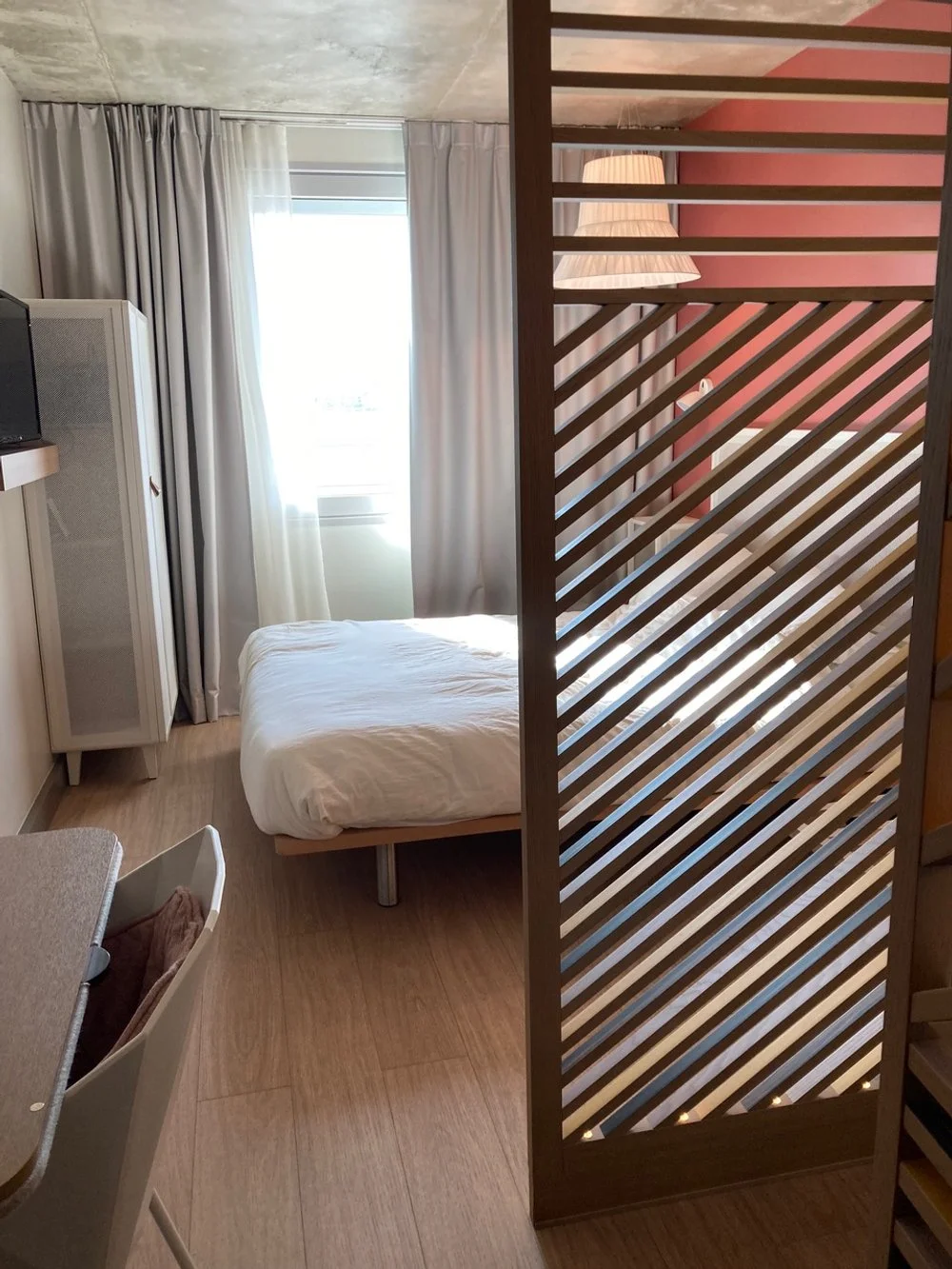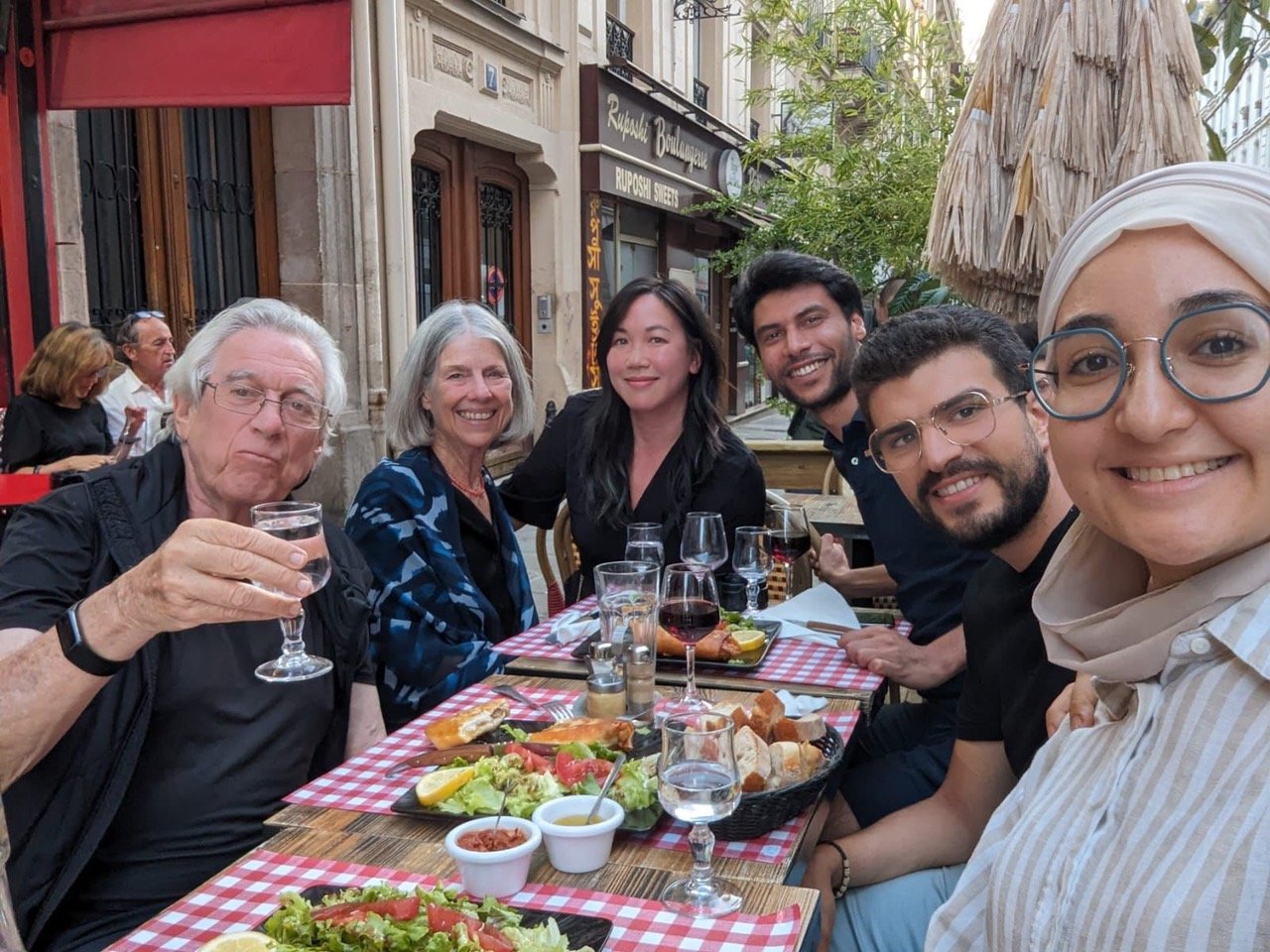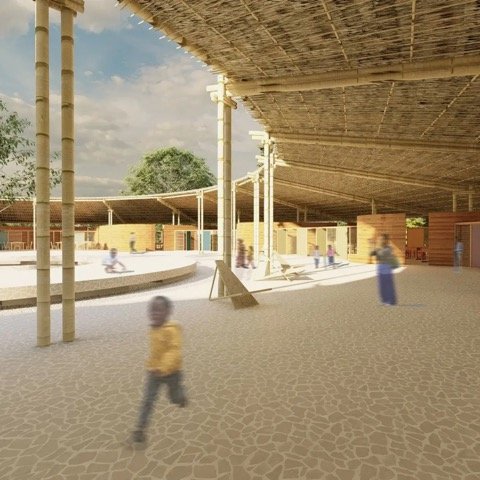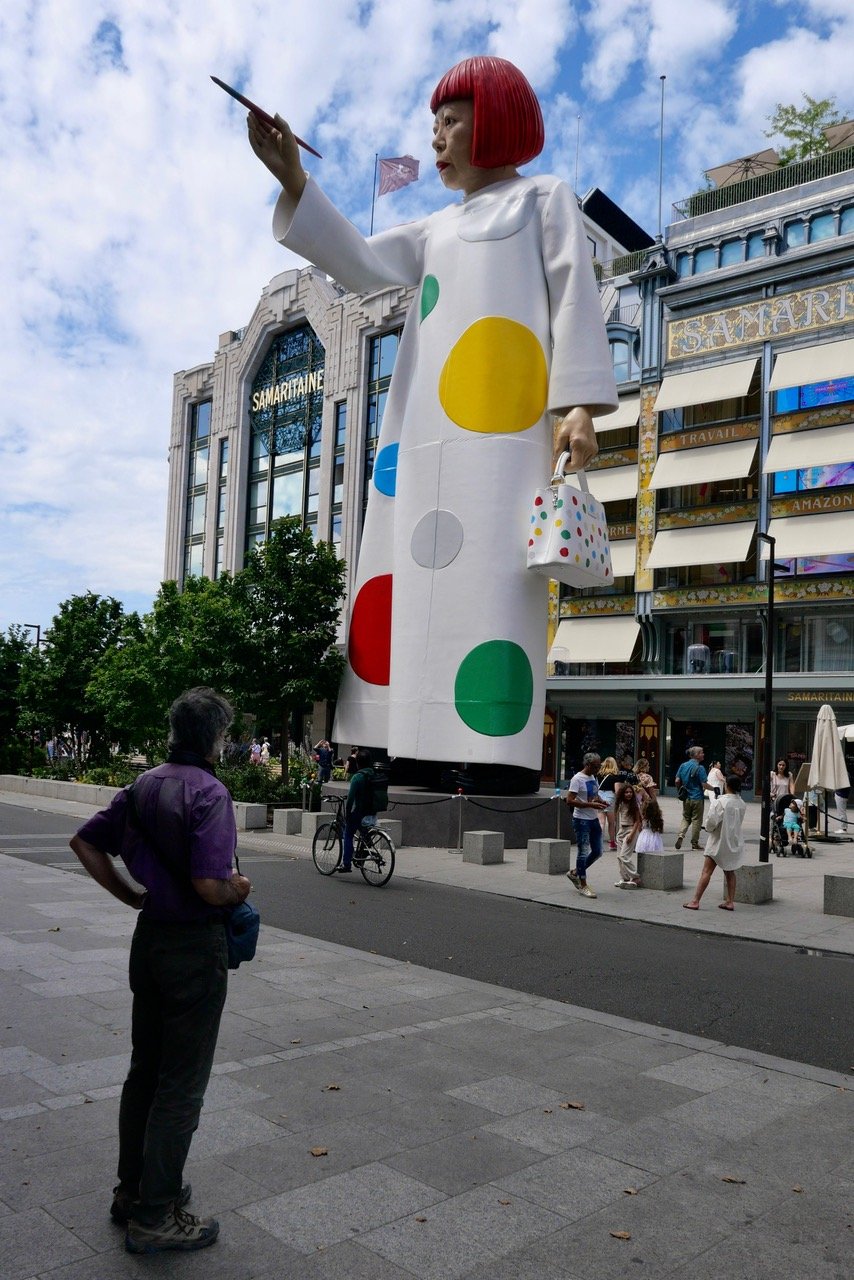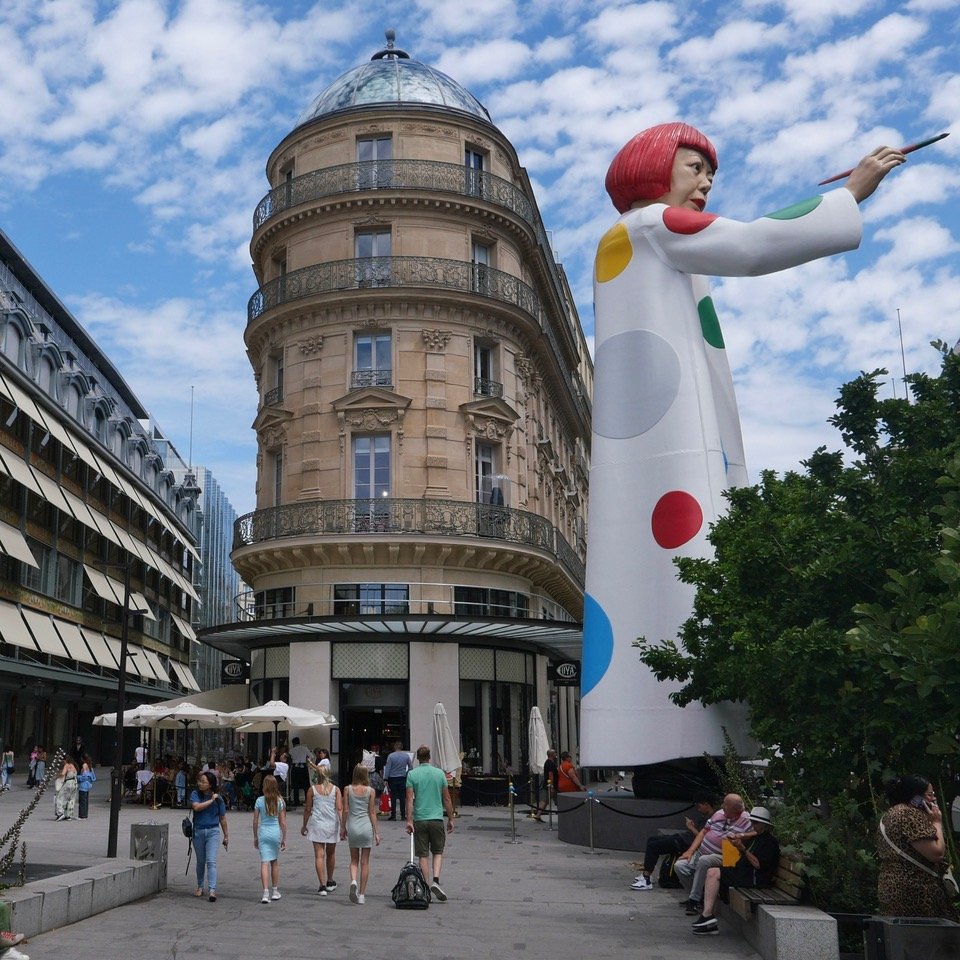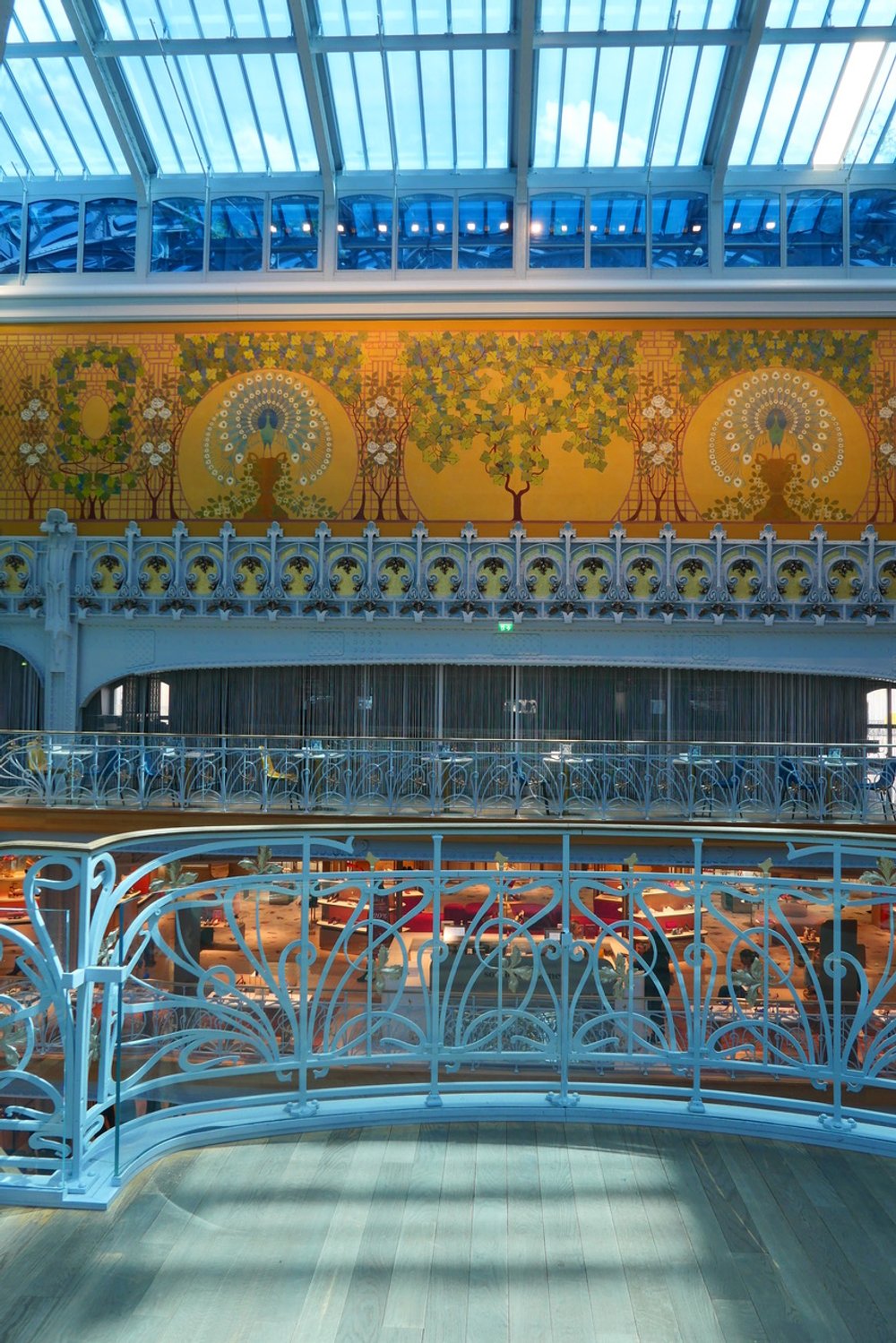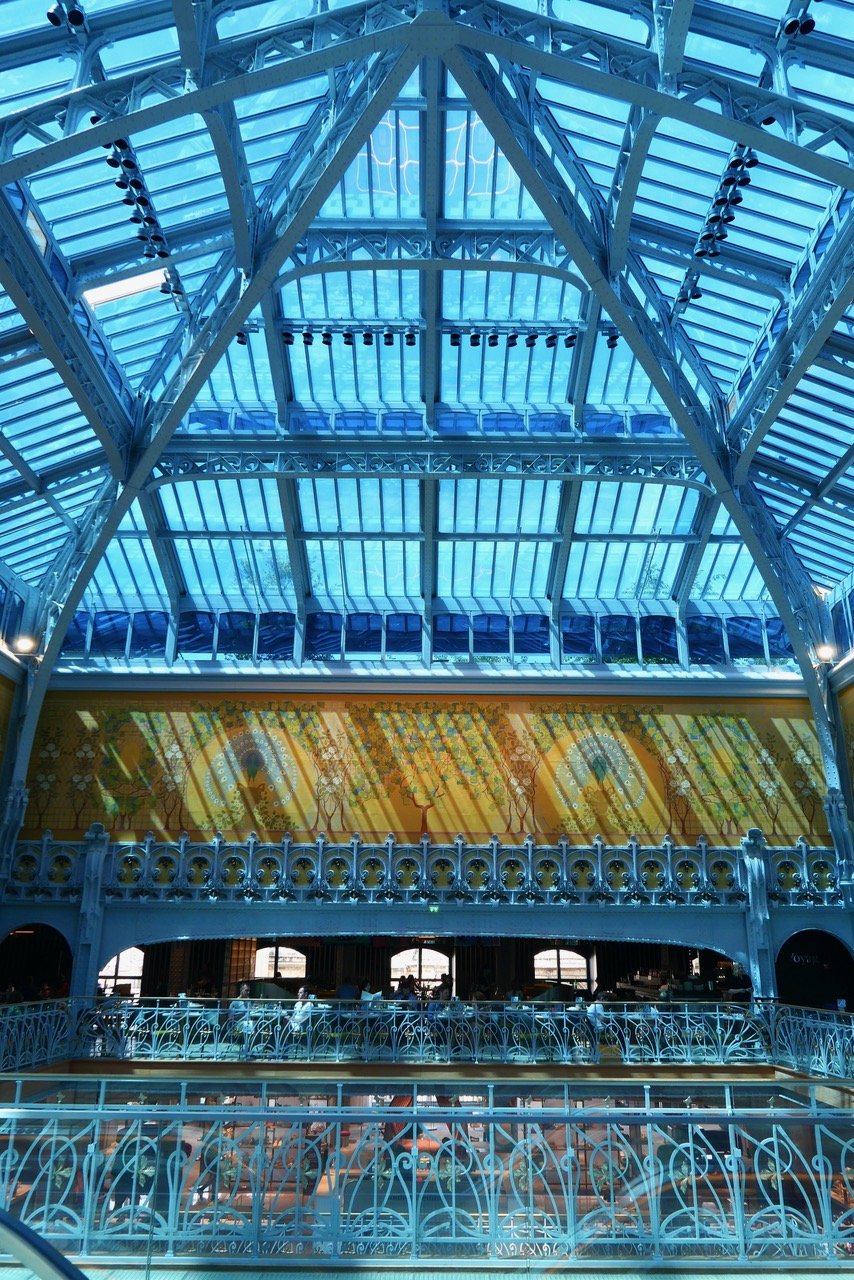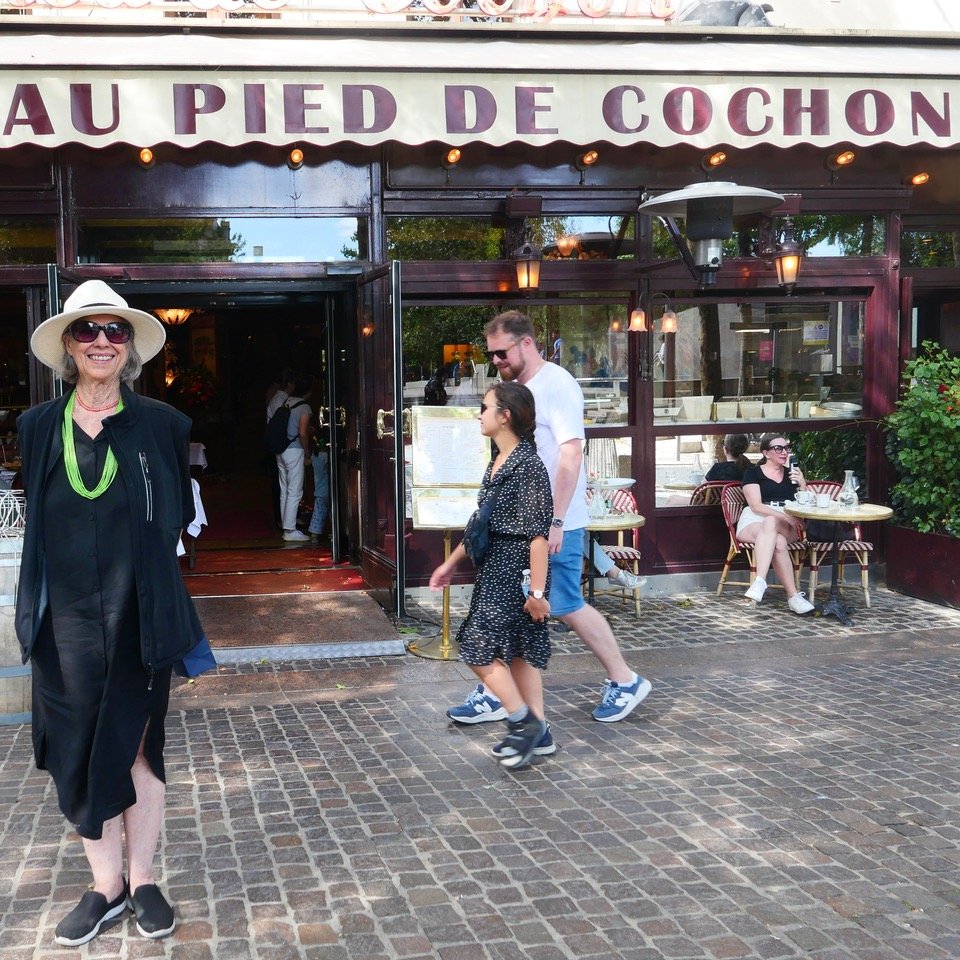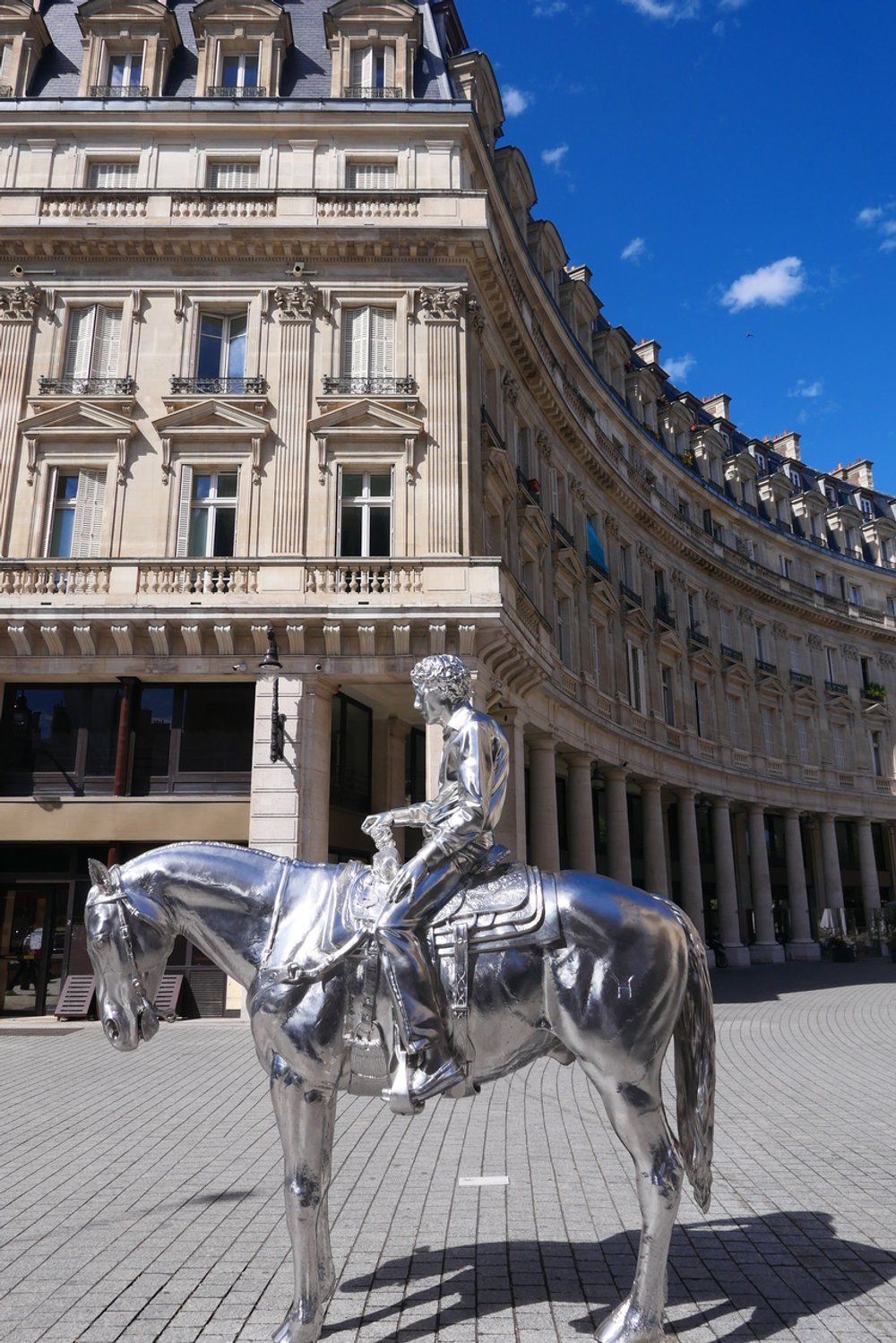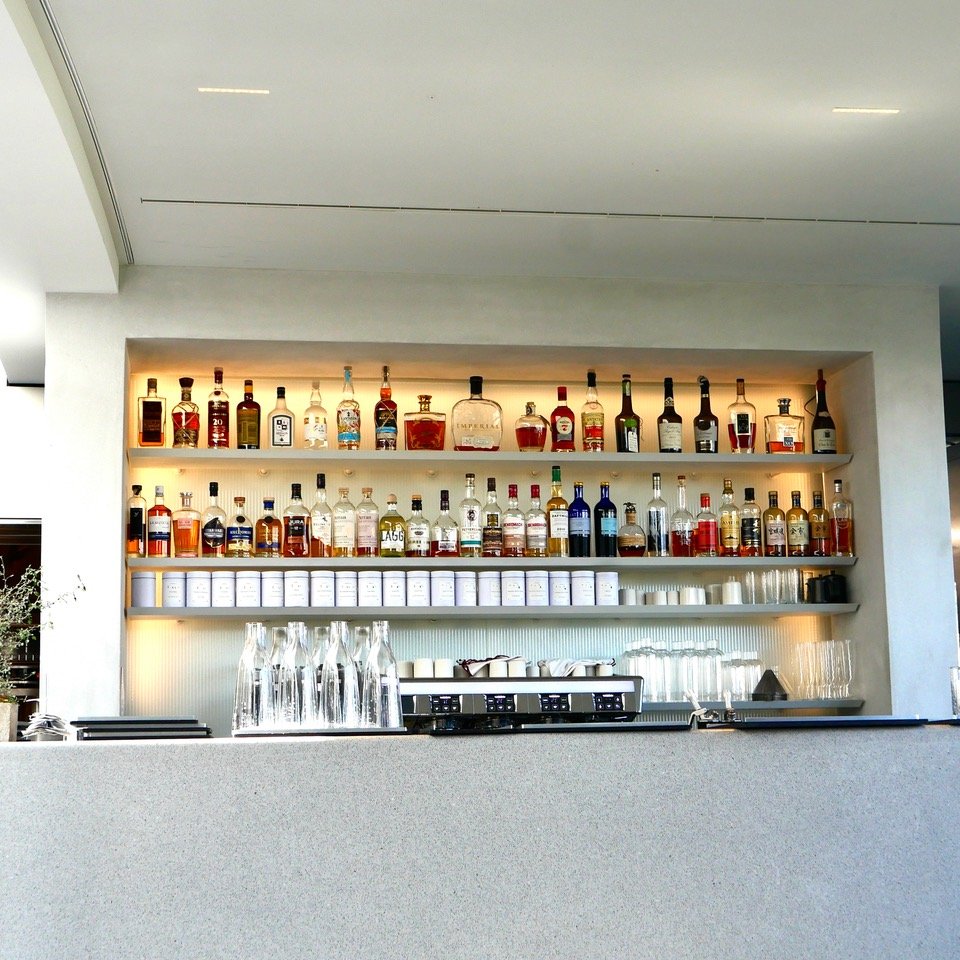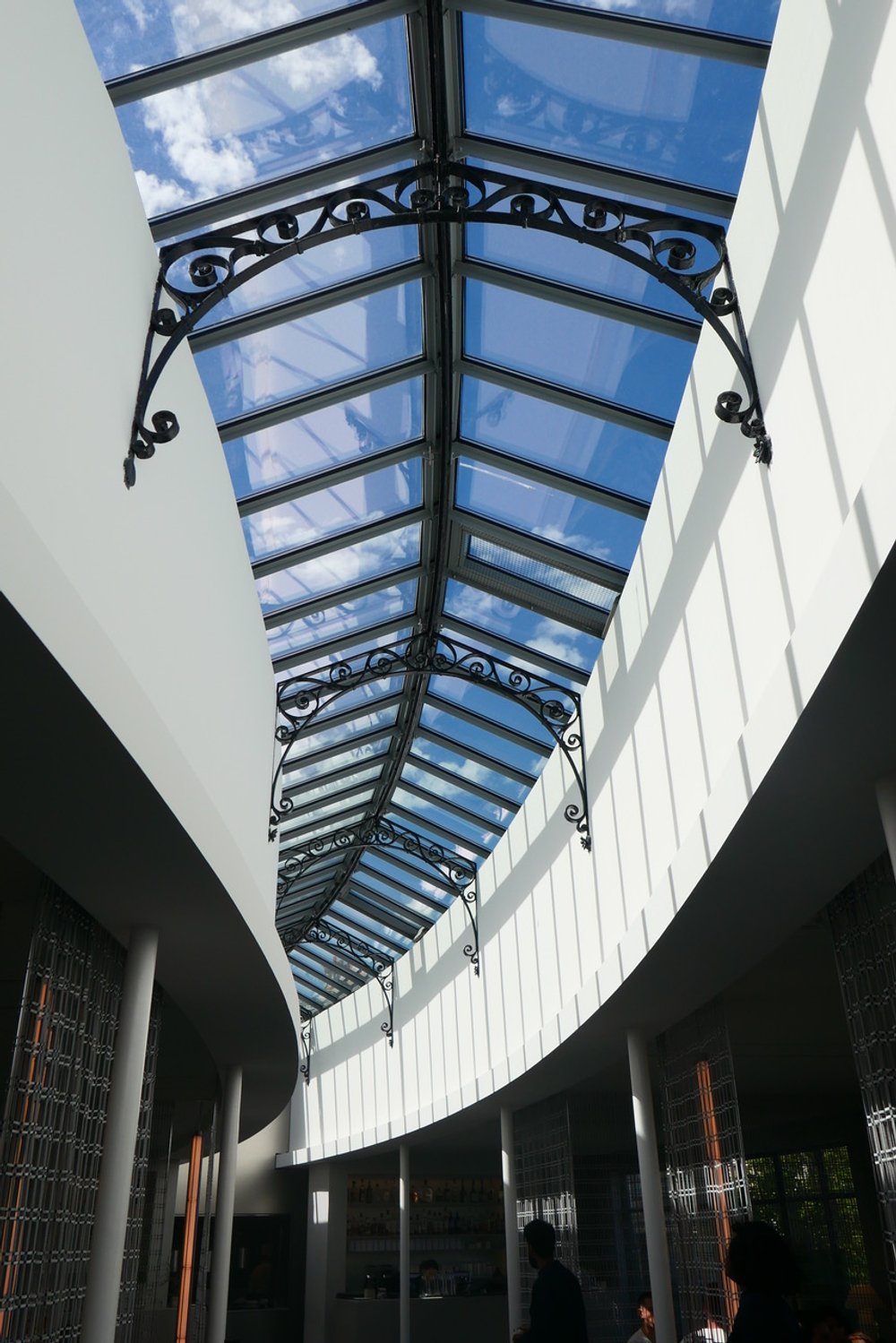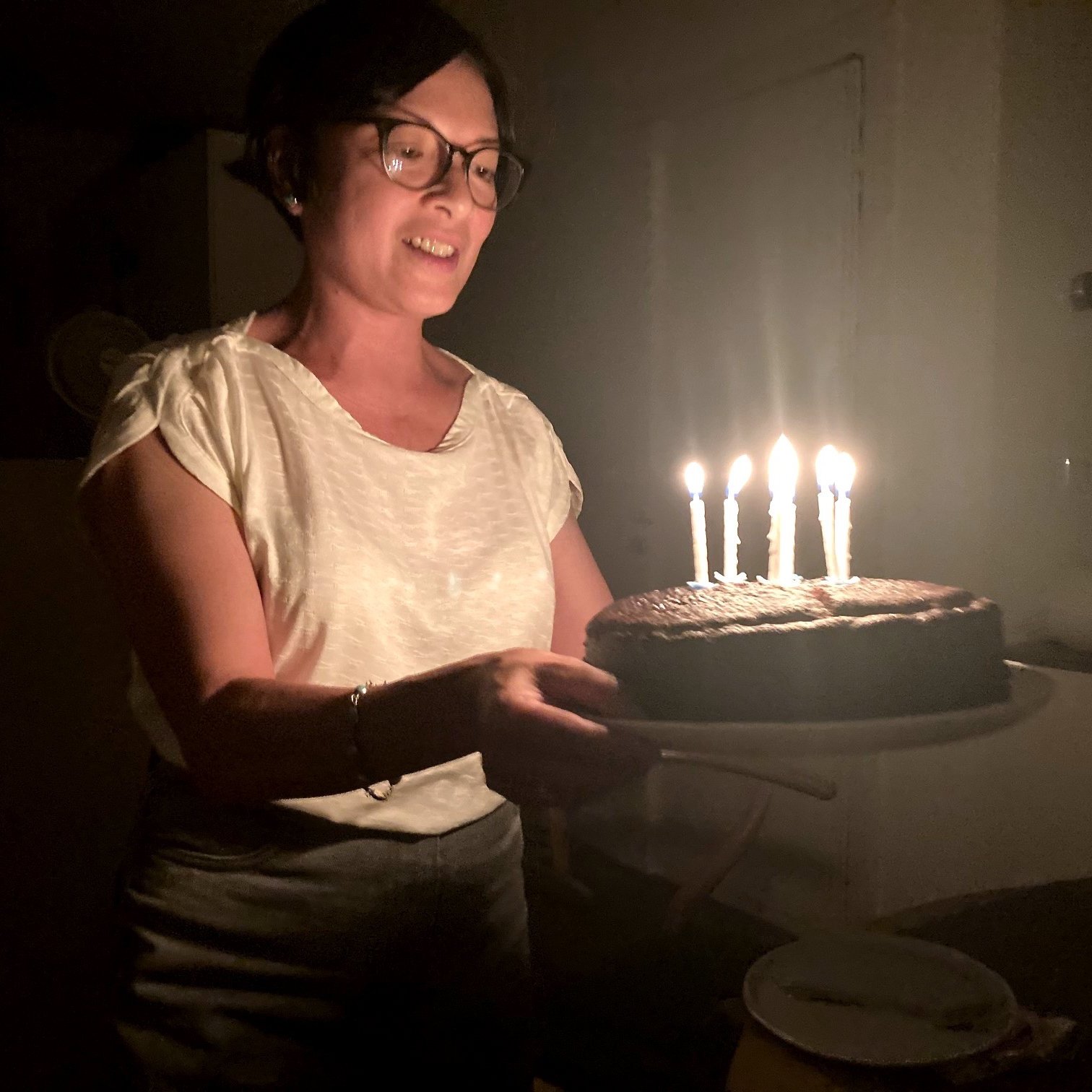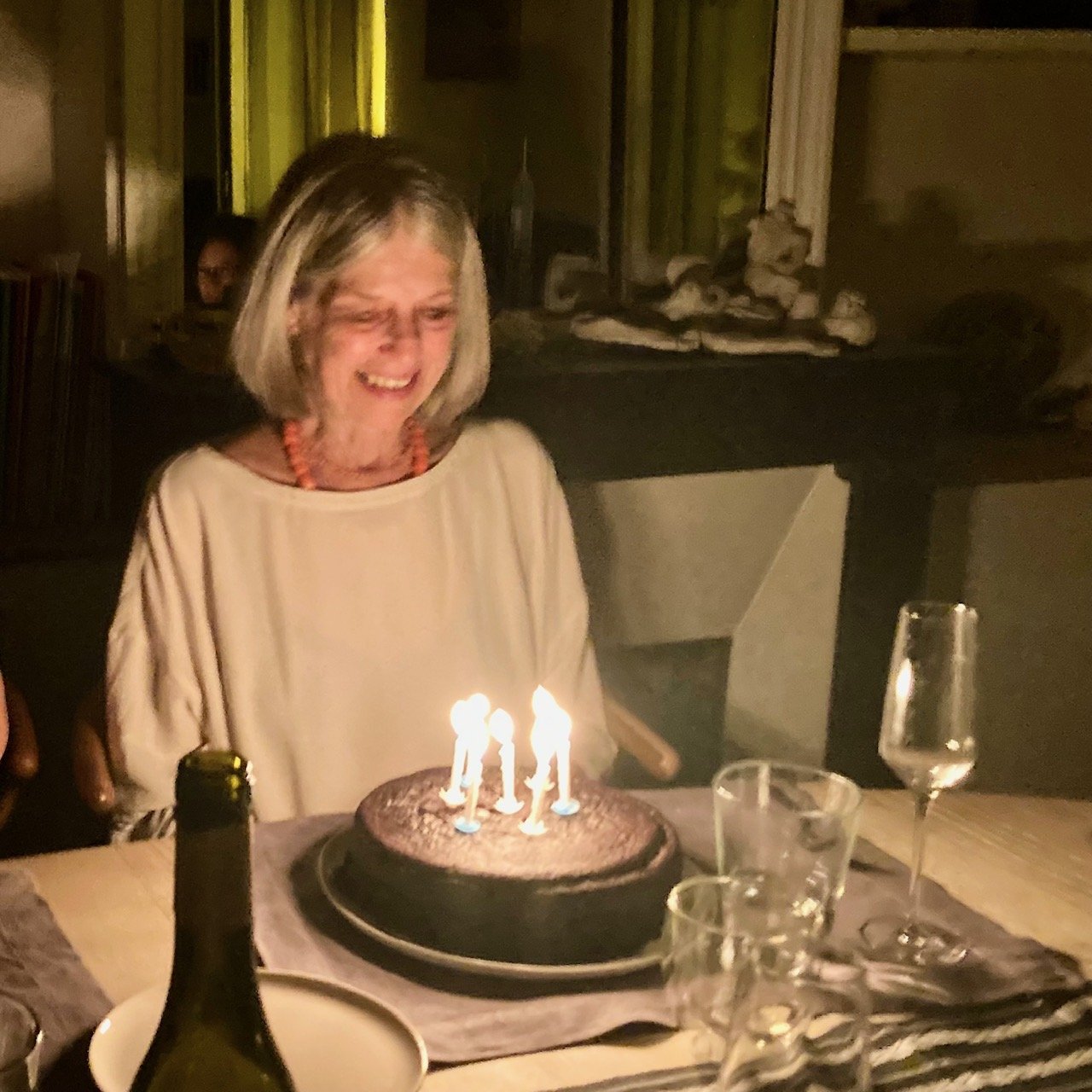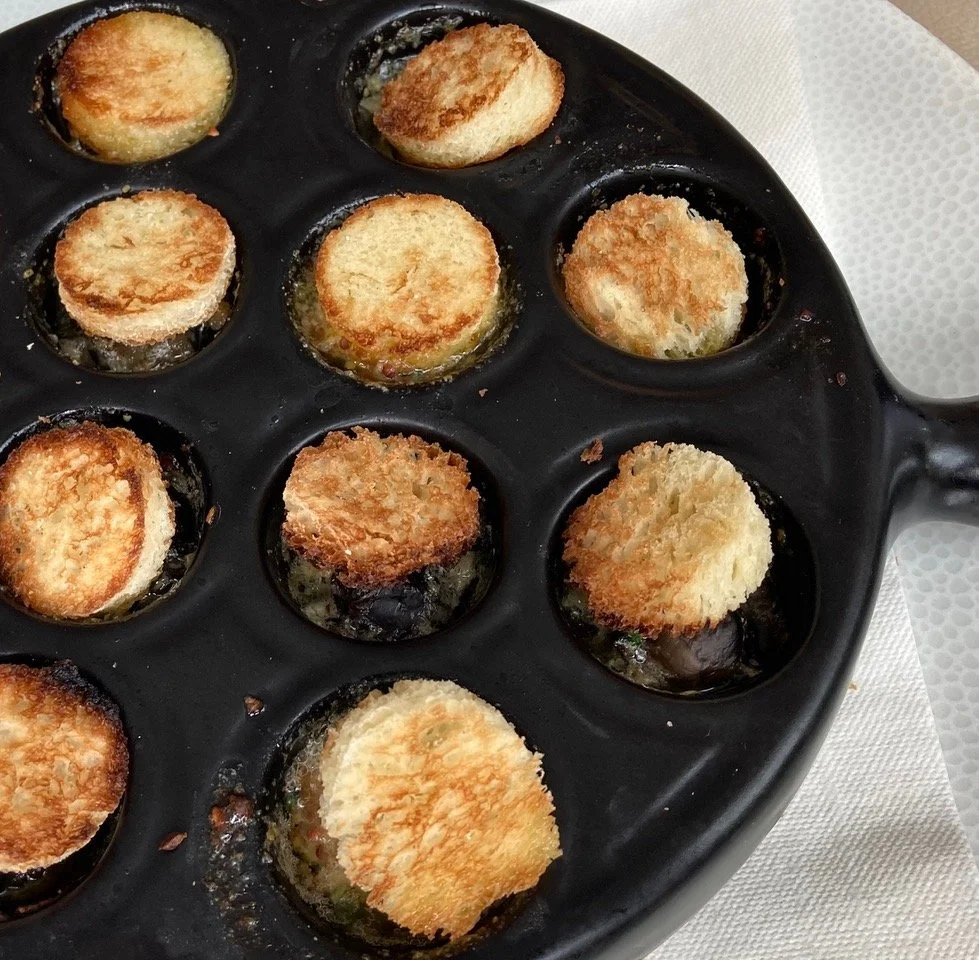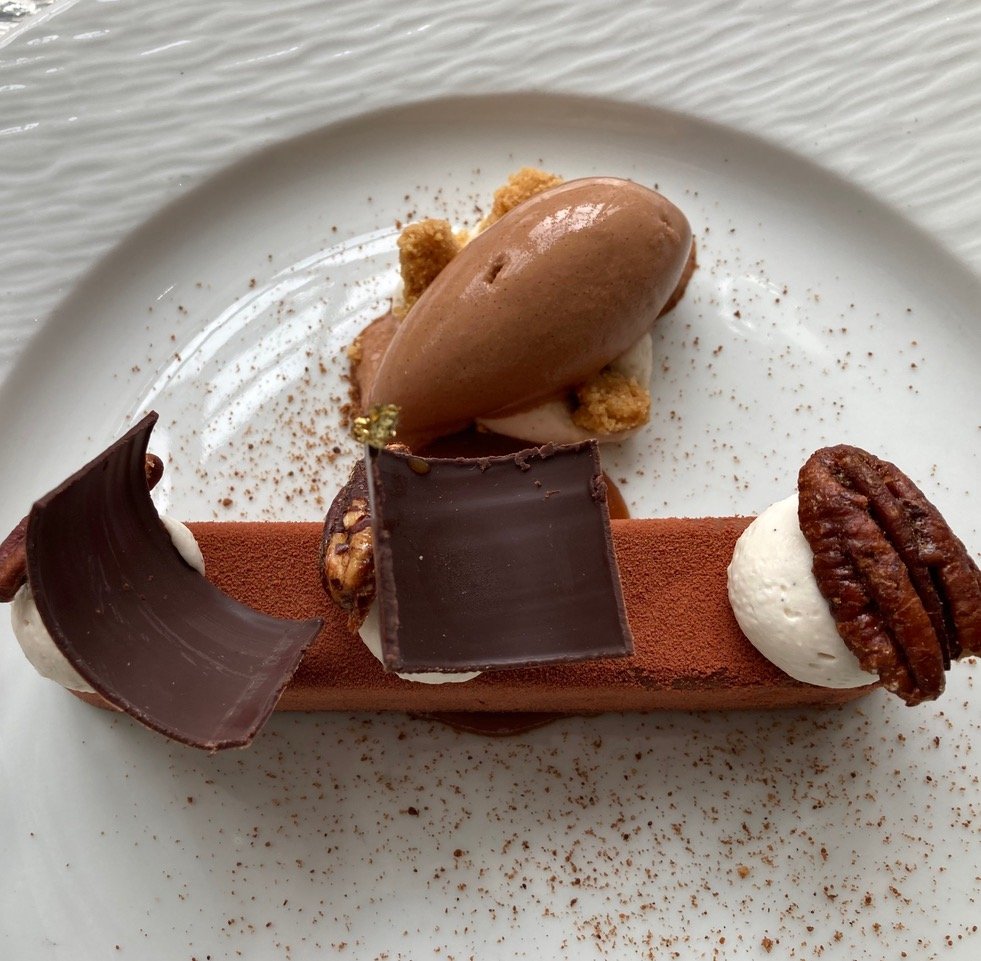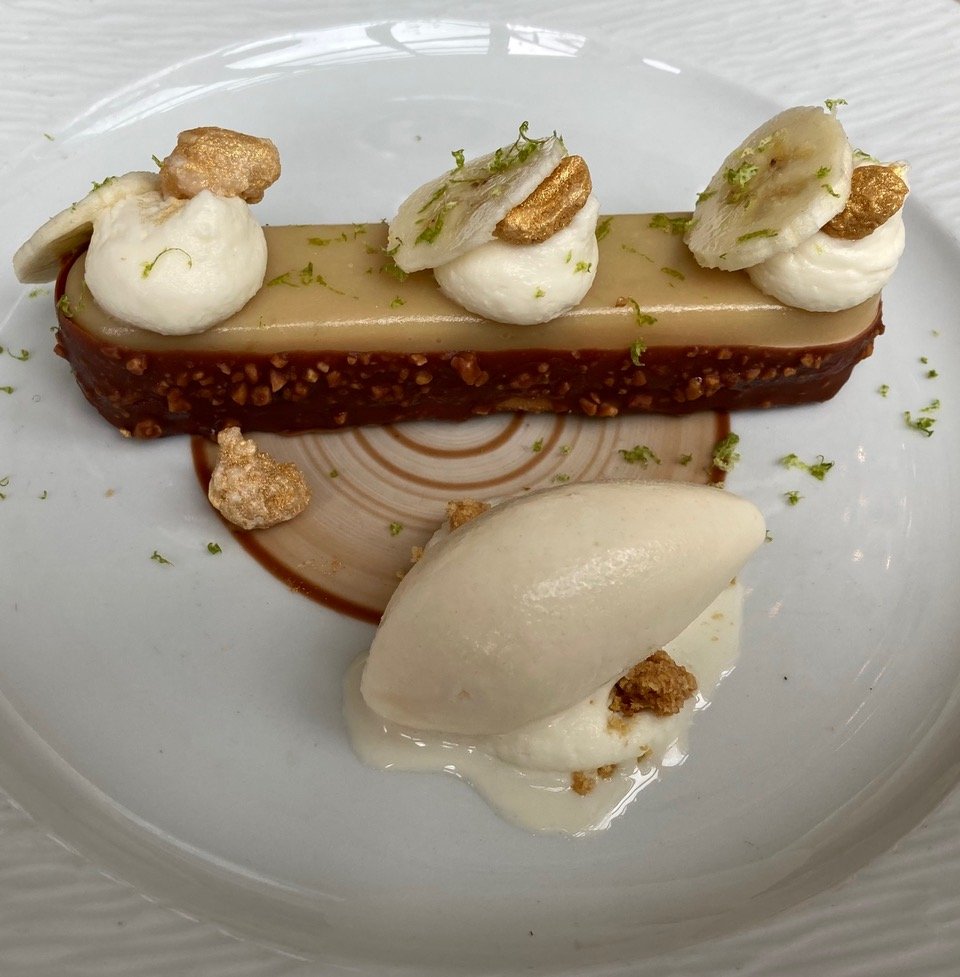OUR TRIP TO FRANCE | JUNE 16 - JULY 17 2023
Our trip to France in three parts
PART ONE
Saturday, June 17th Paris
It has finally happened. It has been three years since we have travelled to France. After settling into our rental apartment in the Latin Quarter in the 7th arrondisement (district) in Paris, we immediately took a walk to the Seine across from the Louvre. What a lovely way to come back to this beautiful city – so walkable, so enchanting, so lively, and seemingly so livable. It brought back many memories all the way back to the time I was a student in this neighborhood during my junior year abroad in Paris from Sarah Lawrence College in the 1960s .
Judy and Stanley on bridge over the Seine with Le Musée du Louvre in the background
Our dear friends Jean Charles and Jacqueline Blanc invited us for lunch at their apartment. We met in 1971 when we all were living in Afghanistan and we have been friends ever since. We decided to walk to their place in the 6th arrondisement. What a joy to wind our way through the streets of Paris gazing into store front windows displaying the latest fashion, to passing by small art galleries and antique stores. We even saw a store that had high design pencil sharpeners selling for 450 Euros. Stanley has the very same sharpener at home in his office. When he bought his, it certainly wasn’t that expensive.
Only in Paris, a four story poster of a pregnant model plastered against Le Musée Quai d’Orsay that floats over three modes of transportation: by bus, by lime-colored electronic bikes and by foot.
Jean Charles and Jacqueline greeted us with big smiles and such happiness. It has been three years since we have been together. Reconnecting with them was simply joyous. It was as though we had seen one another a few weeks ago. They immediately opened a bottle of champagne – a tradition that seemed to happen repeatedly whenever we visited our friends in France. Jacqueline served us a perfect lunch with three kinds of tomatoes, fresh basil, and Burrata cheese (a soft round mozzarella cheese), two kinds of prosciutto and three types of smoked trout. This was followed by a green salad, several special goat and sheep cheeses, and to top it off, for dessert, lemon sherbet with fresh peaches. A bottle of white Bourgogne wine accompanied the meal. In the French tradition, it was a wonderful two-hour long lunch catching up on family, friends and politics. Our whole trip to France continued to be filled with delicious food and long, leisurely conversations discussing everything from friendship, health, the environment and of course world politics. After lunch they suggested we take a quick siesta – something we easily adapted to during our month in France.
In the evening we had a rendezvous with Randa Massot, an artist living in Paris who is half French, half American. Her American mother, Gail, is a good friend of ours living in Virginia. She invited us to see a small exhibit of her artwork in a café near her apartment in the 11th arrondisement. Unfortunately, when we got off the bus, we encountered a sudden downpour, a real thunderstorm. Traffic came to a halt.
We ran to the nearest bistro – thank goodness in Paris – there are cafés on practically every block. Only ten feet away, we entered a bistro, now soaking wet since we didn’t have an umbrella. The owners welcomed us with big smiles. We asked where we could buy an umbrella but they insisted on giving us one from behind the counter. People often forget their umbrellas and never return to claim them. After checking the menu, we realized we were in a Korean café. We couldn’t resist sharing with the owners that our Korean adopted son Jong Soo was now engaged to a lovely Vietnamese woman. After more smiles, an herbal tea for the road, and an additional upgrade in umbrellas, we ventured outdoors.
Our fantastic Korean hosts at a Korean bistro.
When we met Randa, she explained that the owner had closed her exhibit for the night, most likely because of the storm. Randa’s partner also could not join us because a giant tree had fallen across the autostrada, just a car or two in front of her. Thank goodness, she was safe and unhurt. We went to another bistro and caught up over a simple meal of lintel salad and salmon tartar.
As you can see, we ate everything.
Paris has become more and more a biking and walking city with many added bike and scooter lanes. We noticed that many Parisians were on bikes. And if they weren’t riding a bicycle, they were on electric scooters, called in French a troittinette. It was a bit frightening watching out for bikes and the fast-moving troittinettes. We learned that the Parisians weren’t happy with the troittinettes since they often run into pedestrians and they are abandoned all over the city. The mayor of Paris would like to outlaw them.
Monday, June 19th
The next morning we met Jean Charles at the Le Père Lachaise Cemetery. Jean Charles and Jacqueline’s son, Timour, tragically died a few years ago in a motorcycle accident. He is buried here. The cemetery, dating back to 1829, has many famous people interred on its grounds including Frederic Chopin, Edith Piaf, Marcel Proust, Gertrude Stein and Jim Morrison. Sadly, when we got off the bus, we were told that the cemetery was closed for the day. Last night’s thunderstorm had caused many trees to fall down inside the cemetery.
On our way back, Jean Charles showed us a special wall where an artist had engraved Le Bateau Ivre (The Drunken Boat) by Rimbaud on a wall near the St. Sulpice Cathedral in the neighborhood where Rimbaud used to live. He was only 17 years old when he wrote this poem.
Only in Paris can one stand under the words of Rimbaud.
We had lunch in a local café in Jean Charles’s neighborhood. We toasted Timour and Jacqueline’s mother who was also buried in Le Père Lachaise Cemetery. In the late afternoon we visited Cindy Nguyen at her apartment. She was one of Stanley’s students and later taught with him when he led the architectural semester abroad program in Paris for nearly ten years. She wanted to show us her terrific apartment with a balcony overlooking Paris.
Judy and Stanley on Cindy’s balcony in Paris.
Tuesday, June 20th
We walked over to Le Petit Palais to meet our Tunisian friend Hafida Latta and her husband David, a British diplomat in the cultural affairs department. We hadn’t seen Hafida since 1966 when Stanley and I were Peace Corps Volunteers in Tunisia. Hafida, Suzanne Owen and I were roommates for two years in Tunis. We lost contact with each other until now when we serendipitously both wrote cookbooks on Tunisian cuisine. What an unusual coincidence that each of us wrote a cookbook at the same time.
Hafida and Judy with their cookbooks in the courtyard gardens at Le Petit Palais. Hafida is very impressive. She speaks several languages: Arabic, French, German, Italian and English. She has also just completed her autobiography. We promised we would not let so many years go by without seeing each other again.
The Petit Palais rarely gets the credit it deserves. The beautiful gardens and the magnificent Interior are always a surprise.
Interior of Le Petit Palais
Interior of Le Petit Palais
Le Petit Palais and its fantastic stairway.
Equally surprising was the collection in Le Petit Palais. Never a dull moment.
It was hard to walk by this one.
We were amazed at the realism of this scene of poverty in the streets of Paris painted in the 19th century.
Wednesday, June 21
Our friend Olivier Flaviano, now the director of the La Galerie Dior, invited us to have a private tour of the museum located next to Dior’s flagship store on Avenue Francois 1re.
Unfortunately at the last minute, Olivier had to give a private tour to the first lady of Korea and so he couldn’t meet us. No problem, Gabriel Wick, Olivier’s husband, stepped in and became our guide. Gabriel is a historian and landscape architect who taught in the Paris architectural program with Stanley and Cindy.
The six original buildings on the Dior site were completely gutted, combined and redone into a complex holding the original designer's workshops, retail stores for Dior Men and Women, and finally a museum dedicated to Dior. Given the quality of the new design and construction, elaborate displays and the bottomless riches of French businessman Bernard Arnault, we were clearly in for a wonderful treat.
From the street, we could see a clear contrast between the old and the new at Le Galerie Dior.
A display on the outside of the building of Le Gallerie Dior.
When we walked into the main entrance, the first thing we saw was the spectacular spiral staircase with recreated 3D-printed miniatures of Dior fashions lined up and down the walls.
The spiral staircase.
The dollhouse size reproductions are displayed on the staircase changing in hue from top to bottom
It was hard to get Stanley off of the staircase. He said that it was clearly an extraordinary anchor to the entire sequence of museum floors spread out over three levels with 13 rooms showing the different periods of Dior’s life.
The museum showcases the entire history of Christian Dior’s fashion from his beginning designs in 1946 to his six successors that included Yves Saint Laurent to today’s designer Maria Grazia Chiuri. We were surprised to learn that Dior was only the chief designer for 10 years.
The entire museum was truly an amazing experience with state of the art exhibitions spaces using videos, moving slides and lighting effects on the manikins giving the space a magical and at times Disney-like quality.
Even the transitions from one level to another became a cinematic operation orchestrated by the gifted designer Maria Grazia Chiuri.
One room featuring ballgowns had as its backdrop ever-changing videos and lighting effects that started with daylight…
and ended under a falling nighttime of shooting stars.
Olivier Flaviano, the director of the La Galerie Dior, joined us half way through our tour to say hello and give us a little of the history of the museum.
One more photo giving us all a chance to get into the act.
Gabial Wick, Stanley, Olivier Flaviano, Judy and Cindy Nguyen
Another fabulous display in La Galerie Dior.
Thursday, June 22
Today Stanley gave a lecture to the architecture firm, ENYA, outside of Paris. He did a terrific job speaking in French to over 20 people and an additional 20 people on Zoom. Five ex-students of his from Tunisia showed up for his talk. Youssef Hamza works for the bureau and his fiancée Maha Lassoued participated on the Zoom call. After the lecture, again they popped open the champagne. Stanley was so touched that his Tunisian ex-students had come to the lecture. He also was relieved when the lecture was over. I was very proud of him.
The poster announcing Stanley’s lecture.
Stanley describing studios in France.
Stanley getting excited about sketching in the field.
Some of the many images from Stanley’s student studios in Paris, Tunis and Washington DC.
Studios pursued in month-long intensive workshops each semester at Universié Tunis Carthage
Graduates from Université Tunis Carthage working for Enia Architects or other Parisian firms: standing left to right are Iheb Saadaoui, Mootaz Talbi, Stanley and Judy, Youssef Hamza, Cindy and Paule-Arlette Dieth with Jaouher Talbi sitting in front.
Friday, June 23
ANGERS/ SAINT-SATURNIN-SUR-LOIRE/ SAINT-REMY-LA-VARENNE/ L’ABBAYE ROYALE DE FONTEVRAUD
We were off for the weekend to Angers with Gabriel Wick. Olivier couldn’t join us. It was fashion week in Paris and he had to remain at La Gallerie Dior. Thank goodness Gabriel was there to navigate us through Gare Montparnasse to catch the train to Angers. It was very crowded and quite confusing, but he got us to the 1st class waiting room and then onto the train with our four pieces of luggage.
Cindy Nguyen met us in Angers where we picked up our rental car for the weekend. Gabriel and Olivier own a house in Saint-Saturnin-Sur Loire, once a chapel now converted into a lovely cottage. The once chapel with its beautiful vaulted ceiling sat next to a mini house for the priest. With only a little work, they turned the once religious space into a spectacular home away from home.
The entrance gate to Gabriel and Olivier’s home was alone worth the detour.
The chapel now converted into a house.
The interior space of the house with its star painted ceiling.
Architectural looking flowers in their garden.
Not only was inside of the house fantastic but the outside gardens were also spectacular. Gabriel, a landscape architect and historian, had transformed the back and front yards into a little garden paradise filled with roses, holy hawks and different varieties of herbs. Stanley was in heaven shooting every arrangement of plants that made this place so special.
Colorful flowers were everywhere.
In this small pond lives Mimi the frog. Now under the lily pads, she has taken up residence here.
For dinner we drove to Saint-Remy-la-Varenne. Stanley was again overwhelmed with the architecture of this small village, simple but beautifully laid out. The village was built in traditional stone with wonderful architectural forms.
The church in Saint-Remy-la-Varenne.
In the village Gabrial took us to a simple cafe that served a fantastic delicious pizza.
All of us waiting for our pizza. When it arrived, we thought it a chef-oeuvre. It was dribbled with olive oil and a thick balsamic vinegar. Gabriel, Judy, Stanley and Cindy.
This pizza included arugula, goat cheese, mozzarella and fresh tomatoes. Where do we begin?
Stanley thought it the best pizza he had ever eaten. He said these French chefs bought a new perspective to the Italian meal.
Judy and Gabriel agree this was a great lunch.
Saturday, June 24
We walked into our little village of Saint-Saturnin-sur-Loire to buy croissants, fresh vegetables and cheese. Gabriel told us the village of 1100 people has a very informed citizenry who want to keep up the traditional architectural integrity of the town.
Saint-Saturnin-sur-Loire
Stanley enjoyed photographing the patterns of aging wood in this small village.
More aging wood.
This is a sidewalk vending machine selling fresh baguettes, a staple in every French family’s kitchen. Available 24-hours a day supplied by the village bakery.
The mayor of the village recently obtained funds to support a proper bakery surrounded by a small everyday open market. A boy who helped us buy our vegetables at the open-air farmers market was no more than 12 years old. He wanted to practice his English as we bought our vegetables for our dinner. In the same square we found the source for the sidewalk vending machine, the bakery that was now filed to the brim with all that a bakery is expected to have.
In the bakery
The baker preparing some delicious bread.
And also some wonderful desserts.
Our destination for the day was L’Abbaye Royale de Fontevraud, a Benedictine convent founded in the beginning of the 12th century. It had always been run nuns, even though it housed both men and women. Now beautifully restored and open to tourists, it was an ever unfolding surprise of different spaces. The entrance was straightforward but adjacent to the building was the kitchen constructed with wonderful shapes Stanley said he had never seen before.
The amazing turrets and honey-combed roofs of the communal kitchen at L’Abbaye Royale de Fontevraud.
L’Abbaye Royale de Fontevraud is a serious basilica of stone arches and vaults. The grand nave was solid with promises of something special at the end. Eleanor of Aquitaine and her husband Henry II were both buried here as was Eleanor’s favorite son, Richard the Lion Hearted. On her tomb, there is a carved figure of her reading a book, a symbol of her cultured background. She retired here in 1200 and died four years later at the age of 82.
Judy and Stanley inside the basilica church.
Eleanor of Aquitaine and her husband Henry II in the foreground and Richard the Lion Hearted and their second son in the background.
Eleanor of Aquitaine and her husband Henry II. Eleanor reading a book.
When the French revolution occurred, 800 years of monastic life ended at the Abbey. The nuns were expelled and then in 1814 Napoleon transformed it into a prison. It became known as one of the toughest prisons in all of France until it was finally closed in the 1960s.
Today the nave has been converted into a space for 21st century artists. We liked the fact that something that was once an awful prison had been transformed back into a beautiful space holding art exhibits.
One sculpture that we especially liked by the French sculptor, Fabien Mérelle, was of a boy with a rock in his hand standing by a large altar at the end of the nave. As we approached the altar, we noticed rocks strewn across the floor strategically placed there by Fabien Mérelle. The artist had carefully placed large stone fragments with curious pictures of his children. He wrote that the pictures symbolized the ties between his family and his children and the ties of Eleanor of Aquitaine and her sons.
This intriguing sculpture is the silhouetted full size sculpture of Fabien Mérelle’s son holding a rock.
Here we see the artist’s son sitting on fragments of stone near the altar.
Here again is a tiny statue of Fabien Mérelle’s son standing high up on steps leading up to a window.
We walked outside to explore a beautiful large cloister courtyard. Stanley and I thought it one of the most beautiful abbeys we had ever visited.
The cloister courtyard of L’Abbaye Royale de Fontevraud
The courtyard of L’Abbaye Royale de Fontevraud.
Judy wearing her green necklace and hat fits right into the rhythm of the vaulted cloisters.
The tile floor aging over time has become an abstract painting of sorts.
The communal kitchen was a magical structure of vaults and chimneys built on a corner of the monastery.
The interior of the kitchen was awe-inspiring. It would have been fabulous to see the kitchen in full use those many centuries ago.
One of the rooms had models of the entire abbey showing its evolution on a set of architectural motorized seesaws that moved the huge site models up and down. It was all illustrated with an accompanying video that addressed the various stages of the growth of the abbey.
On our way back to Gabriel’s house, we followed the main roadway that ran alongside the Loire River passing small medieval villages with their stone houses and narrow streets all lovingly restored. It appeared that the farmers in the area have been able to make a living off this fertile land because of the Loire River running right through the area. To us it looked like a nice place to live with its rich agricultural lands and its beautiful, picturesque villages. Gabriel explained that when you see poppies, which we did, it meant the farmers were using organic products over harmful pesticides.
One of the villages we passed by on our way back to Gabriel’s house.
Gabriel prepared another delicious dinner. We had a tomato salad with a soft feta cheese alongside a cucumber and chives salad mixed with yogurt. He then served a pasta dish with zucchini and mushrooms. As you can see our trip to France has been filled with fabulous, healthy meals .
Gabriel invited his neighbors to join us for dinner. Jacques Baldet and his wife used to work for the World Bank. Jacques is now writing a book on the historic Jesus. He told us he taught himself Hebrew and has gone back and translated the original text. According to Jacques, it was never written that Jesus was the son of God, just the son of man. There was no mention of a virgin birth. He was just an exceptional rabbinical preacher.
Sunday June 25
Gabriel invited another neighbor, Tierie, for lunch. Again, I was the sous-chef. We sat in Gabriel’s lovely garden enjoying a cucumber and yogurt salad, a tomato and mozzarella salad and a fresh red leaf salad topped off with ice cream for dessert. It was all very French, all very pleasant and all extremely healthy.
Another toast before another great meal in Gabriel’s garden.
ANGERS
In the afternoon we were off to Angers to visit the Chateau of Angers. an imposing fortress of black stone interspersed with white stone surrounded by a mote and a classical French garden.
The heavy fortress like structure of the Chateau of Angers is in sharp contrast with the lyrical French garden below.
The Chateau of Angers’ drawbridge was most imposing and again a sharp contrast to what was exhibited within.
Stanley liked the unusual stone masonry on the fortress walls.
Inside the chateau in a high darkened room, there was an extraordinary display of 14th century tapestries commissioned in 1377 by Louis I, the Duke of Anjou. The tapestries recount the Apocalypse from the Book of Revelation by St. Paul the Divine.
It took five years to complete the whole series of tapestries that filled one entire room. Many of the tapestries depicted battle scenes between angels and beasts, a popular story in the 14th century that liked to focus on the heroic aspects between good and evil.
Even though most of the scenes include destruction and death, the final tapestry did end up with good triumphing over evil.
Stanley was somehow able in the darkened room to take 40 or more shots of the unfolding story. Wow, wow, and wow. It is definitely a place worth visiting.
After visiting the chateau, we walked through the old medieval section of Angers with some houses going back to the 13th century.
Medieval section of Angers
Medieval house in Angers. It is easy to understand the role of all the ’tudor’ timber cross-bracing required to brace the walls that have lasted a good 600 plus years.
Medieval Angers
ILE DE RÉ
Monday, June 26th
In the morning Cindy and Gabriel took us to the train station. It had been a wonderful weekend filled with great sites, lots of laughter and of course delicious food. We hugged and thanked them both for being so thoughtful and considerate, always looking after us and making sure we were having a good time.
Getting to Ile de Ré meant taking two different trains and a bus. With our 2 medium-sized wheeled suitcases and 2 small rolling ones that fit on top of the bigger suitcases, we easily managed getting on and off the trains. We were impressed with how polite and helpful everyone was, always there to help us getting our suitcases on and off the trains. It might be our age, but whatever the reason, we appreciated all this kindness. Who says the French are alouf? We certainly have never found that to be the case.
Scenes of Ile de Ré taken through the window of our bus moving at a snail’s pace suggesting a completely different landscape: horizontal, inundated with pools of saltwater, slowly evaporating to leave the precious sea salt that is then harvested and distributed throughout the world.
The flat landscape of Ile de Ré
Judy enjoying the bus ride to Ile de Ré.
The Salt ponds on Ile de Ré.
The Salt ponds on Ile de Ré.
Our friend Fabienne Lips Dumas was waiting for us at the bus stop on the island. We walked to her mother’s house where we would be staying for two nights. At 94 years old, Fabienne’s mother Evelyne was in terrific form and as lovely as ever. Her house is filled with paintings, books and fresh flowers. Fabienne is a filmmaker and writer who lives in Virginia with her American husband Tim. We met several years ago and have been friends every since then.
Stanley in the garden.
A wonderful breakfast with fresh croissants and fresh fruit prepared by Fabienne.
Fabienne, her mother Evelyne and Stanley.
Fabienne had two bikes ready for us to ride. Ile de Ré is flat so everyone bikes here. There are practically no cars on the island and since it is so flat, there is no need for the bikes to have gears. We rode our bikes to the edge of the sea —the Atlantic Ocean.
Our bikes without gears. There is need for them since the island is so flat.
Fabienne and I walked out on an old jetty and climbed down a ladder into the water. The water was very cold, but we both gradually got used to it. I was proud of myself that I actually jumped into the cold water and I had to admit that I found it quite refreshing. As for Stanley, he didn’t want to go swimming in such cold water. On the way back to the house, Stanley was having trouble with his bicycle seat. It kept slipping down. Fabienne had the solution. She knew a friend who had all the right tools to fix his seat. We stopped by his house and he repaired the seat. Finally, a happy Stanley on his bike.
Judy, Fabienne and Stanley by the sea.
Fabienne prepared a delicious dinner starting with cantaloup, the best I have ever tasted. This was followed with roasted squid marinated in olive oil, lemon juice, mushrooms, garlic and thyme. This being France, she also served a fantastic camembert and some local goat cheese. It was lovely to just sit around the table, catch up and enjoy spending time with good friends.
Evelyne, Judy and Fabienne enjoying breakfast on their patio.
Evelyne
Tuesday, June 27
We biked to the open-air market to buy more melon, strawberries, tomatoes, fresh bread and cheese. We walked through the flea market with all the displays of clothes, hats, cell phone covers and scarves. There was hardly a car to be seen anywhere. Fabienne thought that Stanley and I were such a permanent pair, increasingly evident from the way we strolled through the market.
In the evening we took Evelyne and Fabienne out to dinner at a small restaurant in the center of town. We passed by a small but remarkable church and met more of Fabienne and Evelyne’s friends.
A modest but splendid church on Ile de Ré.
Evelyn walking strong by the church.
Old friends on the island making ready for the next generation.
After dinner, we went over to a small square where we watched a theatrical performance about a Jewish girl who grew up in the slums of London in the 19th century and wanted to become an actress. There were only two players, a woman and a man who played three different instruments.
We watched this open-air play in a small courtyard in one of the villages in Ile de Ré.
The musician who played several instruments during the play.
The interplay between the music and the actress telling the story was truly original. Evelyne knew the aunt of the young actress who had been a well-known French actor. We didn’t expect to see such high quality of work. It could have been performed on Off Broadway .
The musician accompanying the actress during the play performed in a courtyard.
The next morning we all rode our bikes again to the center of town. I enjoyed biking through the narrow streets never worried about running into cars. It brought back memories of me as a ten-year-old girl riding my Schwinn bicycle in Malibu, California. With my brothers Rob and Lanny, we used to race up and down Old Malibu Road on our bikes.
Time to the say goodby to a very special Ile de Ré.
Wednesday, June 28
LA ROCHELLE
We took a bus to La Rochelle and to our small boutique hotel, Les Residences des Indes. Our room was big and spacious with Indian miniatures on the wall. The owner and his wife had spent many years in India – therefore the Indian motif. The owner’s father, a doctor, had bought the complex in the 18th century and had renovated it, turning it into a hotel.
Les Residences des Indes. Our bed at this hotel was comfortable which made Stanley very happy.
The walled-in garden ourside our window at Les Residences des Indes provided plenty of sunlight.
La Rochelle has been the center for fishing and trade since the 12th century.
La Rochelle
Arcades in La Rochelle.
We had dinner at a French restaurant on one of the pedestrian streets that was lined with one restaurant after another.
If you look closely you can even see our waitress’s reflection in the window as she photographed us.
We were not disappointed with our meal.
For an appetizer I had thin slices of red snapper on small pieces of toast spread with an olive and pesto sauce.
Stanley had mussels, scallops and prawns in a curry sauce. Absolutely delicious.
For our main course, I had sea perch with tarragon and eggplant….
and Stanley roasted cod. He loved the arrangement with the circle, the vertical diagonal slicing through the horizontal. Such attention to design.
And for desert, we had three extraordinary flavors of ice cream and all for an unbelievable modest price.
Our meal was only interrupted by a long line of protesters of all ages marching down the street protesting the lack of climate initiatives as well as the recent death of a young North African immigrant killed by the police. The national protests concerning the young man’s death increased in violence over the next few weeks. It even soon interrupted our own plans when we reached Avignon. The reaction seemed a bit out of proportion when compared to the United States where we witness killings by guns every day. How we in the US have all become so immune to this.
Street demonstration in La Rochelle.
Once the protesters passed by, we walked down to the seaport.
In contrast at the port, the street musicians were out with their guitars and bands.
One lone entertainer with his guitar was singing a Claude Francois song, Comme D’habitude. It brought back memories of my student days in Paris when I loved listening to this song.
A musician singing Comme D’habitude by Claude Francois.
Judy enjoying his performance.
Street scene in La Rochelle, closed to all car traffic.
La Rochelle medieval clock tower by the port.
14th century Tour Saint Nicolas
Thursday, June 29
We slept well in our comfortable bed at our hotel followed by a good breakfast that included fresh peaches and strawberries, croissants, good coffee and yogurt. It was the beginning of sales week all over France. I couldn’t resist buying three dresses on sale. I needed one since it was much more comfortable wearing a dress than wearing pants in such hot weather.
We read that the Aquarium La Rochelle was one of the ten best aquariums in the world. How could we not go? We spent over two hours looking at the fish and watching the faces of the excited children pointing out the different species of fish.
The Aquarium La Rochelle
We also visited the St Louis Cathedral dedicated to the long ago sailors returning from across the Atlantic in the 17th, 18th and 19th centuries. They painted primitive paintings of their ships now hanging in the cathedral. This ended our time in La Rochelle. Our next adventures would take us to the south of France.
St Louis Cathedral
Our trip to France in three parts
PART Two
Friday, June 30
We were up early to catch a rapid TGV train back to Paris. As senior citizens we could buy special first class discount tickets that included internet access and very comfortable seats. Back in Paris we took a taxi from the Montparnasse train station to the Gare de Lyon where we climbed on the rapid TGV train for Avignon. The hardest thing so far has been pulling our suitcases over the little round structure bumps in the floor at the railroad stations. The bumps help the blind navigate their way in the train stations.
Train station in La Rochelle
Judy at the train station in La Rochelle, ready to take the TGV for Paris and then another train to Avignon.
Our adventures began after our arrival in Avignon. We were to take a bus from Avignon to Apt where we would meet our friends Jean Charles et Jacqueline Blanc who would then drive us to their small village, Simiane La Rotonde, located in the Alps de Haute Provence.
Our bus was to leave at 8:30 PM. We waited and waited. No bus arrived. Eventually a woman came up to us and told us that she had bad news. All the buses in France had been cancelled. No bus would run after 9:00 PM because of the expected riots in the larger cities protesting the death of a Natal, the 17-year-old North African killed by a policeman. The French government was worried that the rioters would burn or turn over the buses. The problem, no official informed us of this decision to cancel all buses. There were five of us at the bus stop. One young man called his parents to come and get him. This left four of us. We decided to take a taxi – the cost 170 euros for the 1½ hour ride to Apt. One lady was only going ¾ of the way. She gave me 20 euros. A young girl who had just graduated from college split the rest of the fare with us.
SIMIANE LA ROTONDE
Jean Charles picked us up at the bus stop in Apt and one hour later we arrived in Simiane La Rotonde, a medieval hill town dating back to the 12th century. Jacqueline greeted us at their lovely country home with some herbal tea. We watched a little TV about Ukraine and we saw that there were indeed riots in Marseilles.
Fields of Lavender below the hilltop village of Simiane La Rotonde
Wonderful cafe in Simiane La Rotonde overlooking the valley filled with fields of Lavender.
Same perspective in a drawing by Stanley
Saturday July 1
Jean Charles and Jacqueline put us up in a separate little guest house with a bedroom, bathroom and even a built-in kitchen. The only precaution, they suggested that we put on our shoes if we had to get up and go to the bathroom during the night. We might by accident step on some harmless little black bugs that roll up into little balls when you touch them. In the morning, Jean Charles and Jacqueline left us breakfast on their terrace with fabulous strawberries, apricots, homemade jam, bread, yogurt and coffee. They were early risers and we never seemed to appear for breakfast until 9:00.
Jean Charles gave us a tour of his garden mainly planted along an old stone wall next to the house. In it there were several Jasmine plants that climbed up the stone wall as well as some beautiful Rose bushes and an enormous flowering Yucca plant imported from New Mexico.
The flowering Yucca plant
Close up of the flowering Yucca plant.
Being an artist, Jean Charles had also created different stone sculptures throughout the garden.
Jean Charles has a special saltwater filtering system that makes the water feel very soft on your skin and is much gentler on your eyes. Swimming in their pool was was a pleasure.
While swimming, we enjoyed listening to the birds chirping in the surrounding trees as well as looking up at a most spectacular blue sky dotted with billowing white clouds. When getting out of the pool, we could savor the lavender fields in the valley below.
The lavender fields spread out in the valley below Simiane La Rotonde
For lunch Jacqueline prepared a delicious roasted lamb. She served this with baked mushrooms stuffed with apricots. A green salad followed along with a selection of local goat cheeses, fruit and coffee. After another perfect afternoon of sharing food and conversation. I did get stung by a yellow jacket. I had stuck my hand under the door handle to open the door in our small cottage. The door was stuck and I couldn’t open it. It turned out there was a yellow jacket’s nest in the hole under the door handle. Jacqueline quickly gave me a special ointment and rubbed the finger with some herbal leaves.
In the late afternoon Jacqueline promised to babysit her 5-year-old granddaughter Kimya. It was a 40-minute drive to the medieval town of Forcalquier and the farm of her daughter Cynthia.
Kimya
A most excited Kimya with her most appreciative grandmother Jacqueline
The big event of the day was a dance concert in the village where Cynthia and Kimya both performed on stage. The dance teacher from the town puts on this concert every year. She teaches the children from ages 5 to 18. It really was quite wonderful. The entire auditorium was full of enthusiastic parents and grandparents.
Stanley and Jean Charles joined us in Jean Charles’ small 2-seater vintage Renault with no airbags. Stanley nicknamed the car “the singing sardine can” because of all the sounds emanating from metal rubbing against metal. Stanley said that it made so much noise that you couldn’t carry on a conversation.
Jean Charles’ Renault
Meanwhile, Stanley held tightly onto his seat as Jean Charles careened around the corners, often perilously close to white protective balustrades marking the edge of the winding road. He thought that they were made of concrete. Only later did he find out that they were only hollow plastic pipes that would have folded if you happened to crash into one of them. On the other hand, does that mean that the car slides off the hill side tumbling down safely into the valley below?
Meanwhile, as the car rolled around the corners, Stanley said he had an extraordinary vision of a ‘green city’ magically emerging from the landscape. Jean Charles stopped the car and Stanley stood transfixed in front of this unexplainable geological yet futuristic urban phenomena.
A mountain side that looked from afar like a green city. One could easily imagine troglodytic apartments dug into the strata of granite with their balconies supporting rows of vegetation. Stanley said that this image would certainly become part of one of his future presentations on the urban landscape.
Sunday, July 2
Another idyllic day in Simiane la Rotonde beginning with breakfast on the terrace followed by a swim in the pool and then another healthy lunch with fresh melon, prosciutto, pâté, feta cheese, salad, cheese platter and an apricot compote for dessert made with lemon juice and vanilla beans.
In the late afternoon Jacqueline and I returned to Forcalquier to watch for the second time Kimya and Cynthia dance in the concert. It was much better this time around. They had added new pieces for the little ones. It was interesting watching the children who definitely had some talent and the others who really looked like they had no clue what-so-ever of what they were supposed to do.
Stanley and Jean Charles joined us with our good friend Juliana Montfort who had just arrived from Aix en Provence. We all met at a Japanese restaurant in Forcalquier. It was great to see Juliana again. Sadly since the last time we had seen her, her husband, Bernard, had died in a tragic swimming accident. A huge wave overtook him while he was swimming off his sailboat in the Dead Sea off of Jordan. He swallowed too much sea water that infected his lungs and this eventually led to his death.
Monday July 3
We woke up to the smell of Jasmine and Lavender plants coming from Jean Charles’ garden. For breakfast Jacqueline had fresh croissants waiting for us. We sat and talked and talked about politics, family and life in general. We then of course enjoyed a swim in their pool.
Juliana, an excellent photographer, took some amazing abstract photographs of Stanley swimming in the pool.
Jean Charles and Stanley have had a great time together. They have remained such good friends for over 50 years. They shared ideas, laughed a lot and would constantly discuss different ideas for hours on end.
Stanley and Jean Charles catching up.
Tuesday, July 4
Jacqueline, Juliana and I went to the nearby town of Banon, another medieval hill town about 20 minutes away.
Banon
Banon is known for its goat cheese, lively open-air farmer’s market, and a really good bookstore. We walked along cobblestone streets to a large square with its open-air market selling fresh vegetables, fruit, cheese, meat and fish, as well as everything from clothes to watches and kitchen knives.
The Banon farmer’s market.
Jacqueline and Juliana buying fruit.
Juliana and Jacqueline insisted we take a break and have a Ricard pastis (an anise and licorice flavored aperitif.) in a local café.
Juliana, Judy and Jacqueline drinking their Ricard pastis.
We returned to Simiane La Rotonde for lunch in the village on a terrace overlooking the valley and its lavender fields. We had a platter of cheese from Banon (mainly goat with one called Herculus), a platter of prosciutto, ham and salami, salad, a lovely white wine from the region and ice cream for dessert.
The café in Simiane la Rotonde
Jacqueline and Judy with another round of toasts.
In the late afternoon, Stanley and I slowly strolled through this picturesque village with its green and blue shutters, cobblestone narrow streets lined with 17th and 18th century stone houses. We thought it might be difficult to live up here since no cars are allowed. Everyone must haul everything up by hand, bicycle or handcart.
Simiane La Rotonde
Winding paths in stone leading people up the hill and the rain water down to cisterns.
Simiane La Rotonde
Back at the house, we had a late dinner on the terrace with two of Jean Charles and Jacqueline’s Belgium neighbor friends. Allain is an architect and in charge of all the restoration in Simiane La Rotonde. He built a beautiful assemblage of stone houses at the top of the village as a short term rental unit. As Stanley was photographing the stone houses, he was fascinated by the shadows it created on the building.
Stone house built by Allain with its wonderful casting shadows.
Jean Charles at a table in front of one of the stone houses.
A view from Simiane la Rotonde of the sun setting behind the distant mountains.
Wednesday, July 5
We swam one last time in the pool overlooking the lavender fields below. We vacuumed the little guest house with Jacqueline’s new fancy cordless electric vacuum cleaner. It ran on batteries. In cleaning up Stanley encountered two small scorpions. He easily captured them and threw them out into the garden. One way to fertilize the plants. Thank goodness he only told me about this encounter with the scorpions hours later.
We will forever remember the fields of lavender below Simiane la Rotonde
Jean Charles drove us to Apt in his little Renaud once more zipping around corners as if we were on a roller coaster. Nevertheless it was a beautiful ride passing by fields of wheat and lavender, olive groves and vineyards.
Stanley and I both agreed that life in France is slower than our hyper speed one in America. It seems to be a cultural trait to simply enjoy having meaningful conversations over a delicious healthy meal. We also noticed that everyone seems more conscious of not wasting water and turning off electric lights than we Americans.
At the Avignon train station, we managed to find the right platform and the correct place to wait to get into our first class “couch #2” car for Antibes.
Three hours later we arrived in Antibes. Patrick Sabatier greeted us as we got off our train. It was an easy walk to their house where Dany was waiting with a bottle of champagne to toast our arrival. We love this festive French way of welcoming guests.
ANTIBES
Thursday, July 6
Dany and Patrick have a great downstairs guest apartment totally furnished with even a Nespresso machine to make our own cappuccinos in the mornings. Dany had fresh bread, fig jam, honey and yogurt in the refrigerator all waiting for us when we woke up – so, so thoughtful. We had breakfast outside on their patio underneath an ancient tree. A turtle that lives in their garden also made her morning appearance.
Dany and Patrick’s patio and garden and their turtle. They named their property La Lyre. (The lyre is a string instrument that looks like a small harp that goes back to the time of the Egyptians.)
It’s lunchtime. Dany and Judy enjoy fresh ravioli stuffed with beef bourguignon along with a salad and an excellent glass of wine.
Dany and Patrick took us to their favorite beach on the Mediterranean, La Plage des Ondes (The beach of Waves). La Plage des Ondes is one of the few sandy beaches in the area so it attracts people from many different countries. We heard German, Russian and English intermingled with French. We noticed one young lady sunbathing in a monokini, but it was not like 20 or 30 years ago when many more women dotted the beaches in their monokinis. It probably was no longer in fashion.
What a pleasure to go swimming in the Mediterranean Sea. The water felt incredibly soft on my skin. I loved looking down through the sea’s clear water at the rocks, small fish and seaweed below.
Stanley and I swam out to the buoys and back. Beyond the buoys, many yachts had put down their anchors.
We’d swim to the buoys, rest a bit and then slowly swim back to the sand beach.
We returned home for lunch on their terrace. Everything Dany served today was from different food shops in town. She said she had so many great choices in town for take-out that she hardly ever needs to cook.
Take-out offerings from the shops in town.
Stanley and Patrick enjoying lunch after their morning swim.
I noticed Dany’s sandals and the next thing I knew I was buying the same Dr. Martens sandals in a shoe store in Antibes.
Old Antibes is beautifully preserved with small winding cobblestone streets and lovely old stone houses. Notice Dany’s shoes. I bought the same ones.
We walked along the city’s ramparts overlooking the sea. At the end of the ramparts was a garden dedicated to poets who have spent time in Antibes. In the middle of the garden was a statue of Victor Hugo who lived during part of his life in Antibes. In the garden were small signs posting quotes from the different poets about the beauty of this place, the sea, the flowers and the brilliant sun.
Judy standing next to Victor Hugo in the Garden of Poets.
Victor Hugo wrote: “Everything here shines. Everything flowers. Everything sings. The sun, woman, love are all at home here.”
The Garden of Poets.
Scott Fitzgerald also spent time in the region with his wife Zelda. He wrote: “Once you set your eyes on the Mediterranean you know why this was the place where man stood up for the first time and extended his arms towards the sun.” Jules Verne wrote: “There is blue everywhere, up high, down low and enough green to resell.”
While I was surrounded by the poetry, Stanley was fascinated by the architecture of the desert plants that a talented landscape architect had so beautifully transformed from a once paved road into such an idyllic landscape.
With Stanley’s close-up lens, he captured the very special world of plants. He became lost in the patterns, rhythms, and geometries of the plants.
After such a feast for our eyes, we returned for another great meal. Dany prepared a grilled Royale Dorade with Kale and pine nuts. This was followed with a salad, baby tomatoes and some delicious ice cream from their favorite ice cream shop.
A fabulous Royale Dorard prepared by Dany.
July 7
A contrast to the desert gardens of the Poet’s Garden, we visited the Jardin Botanique de la Villa Thuret founded in 1857 by the botanist Gustave Thuret. It was the first privately research lab set up in France.
This botanical garden has 2500 different trees and bushes from over 1000 species of tropical plants. Smelling the strong scent of the Eucalyptus trees immediately transported me to my childhood growing up in California where Eucalyptus trees grew everywhere.
Amongst all the incredible species of trees, invited artists added their own contributions.
The largest tree in the garden was a Monterey cypress also transplanted from California.
Stanley loved the bark on this tree and the way it made a mighty transition into the earth.
Stanley called these palm trees “the dancers”, a set of trees that looked like they were choreographed.
The dancing trees were all beautifully costumed for the event.
Still filled with images of the many trees, we went back to Dany and Patrick’s home and their garden. Stanley was smitten by the olive tree sitting right next to the outdoor table.
Saturday, July 8
This morning we headed to the beach an hour earlier to avoid the weekend crowd. Again, it was a wonderful feeling to swim in the sea, savoring these precious moments in the water as the soft saltwater moved across my body.
We visited the Antibes lighthouse (Phare de la Garoupe) where we climbed up 116 steps of the spiral staircase to the top of the old lighthouse built in 1836. We had a spectacular view of the whole Mediterranean coastline and mountains beyond.
Phare de la Garoupe - The Garoupe lighthouse.
The lighthouse spiral staircase.
The top of the Phare de la Garoupe lighthouse with its extraordinary combination of colored glasses.
View looking up the spiral staircase in the Phare de la Garoupe lighthouse.
We had lunch at the Bistro du Curé next to the lighthouse and a small chapel (La Chapelle de la Garoupe). Every year the town’s people carry a statue of the Virgin Mary up from Antibes to this chapel on the hill. Legend has it that this statue saved everyone in Antibes from a plague in the 12th century. I gathered that those who didn’t pray to the Virgin Mary to save them probably died.
After lunch we visited L’Espace de l’Art Concert, an art center in a chateau in the hills above Antibes. We particularly liked one room where the artist Cecille Bart had dangled colored wool and cotton strings from the ceiling.
Cecille Bart’s art installation of wool and cotton strings dangling from the ceiling.
We also liked a room filled with wonderful panels of color.
I liked this painting where the artist had also applied pieces of tree branches.
We then walked into a room filled with the most fantastic collection of insects painted in watercolor by Cornelia Hesse-Honegger from Zurich.
Watercolor by Cornelia Hesse-Honegger
Watercolor by Cornelia Hesse-Honegger
Watercolor by Cornelia Hesse-Honegger
Watercolor by Cornelia Hesse-Honegger
Watercolor by Cornelia Hesse-Honegger
We took Dany and Patrick out to dinner to their favorite restaurant, Le Cesar on Plage Keller. It overlooks the water and it definitely lived up to its name as a little corner of paradise. It was the perfect place to celebrate my up and coming 82nd birthday. They gave me a lovely book, Journal de Nage by Chantal Thomas about the sensation of swimming in the Mediterranean Sea off the coast of Nice.
Judy getting ready for her 82nd birthday celebration. I love celebrating my birthday over many days.
Dany and Patrick soaking up the sun.
For dinner Dany and I had Coquilles St. Jacques with truffles sitting on a bed of pureed leeks. Stanley had salmon and Patrick squid served with an excellent Chablis, Chablis Tete d’Or 2021. All beautifully presented and delicious.
For dinner Dany and I had coquilles St. Jacques with truffles sitting on a bed of pureed leeks. Stanley had salmon and Patrick squid served with an excellent Chablis, Chablis Tete d’Or 2021. All beautifully presented and delicious.
Coquilles St. Jacques with truffles. So beautiful, a painting to be eaten.
Salmon artistically displayed on the plate.
Squid
MONACO
Sunday, July 9
We were up early to drive to Monaco to see an exhibit on Monet.
We were surprised that Monaco had built such an incredible modern museum located at the top of a hill in the center of the city. The huge expansive entry lobby was covered in an intricate network of beautifully detailed trusses holding up an expanse of glass. It was clearly inspired by I. M. Pei’s glass pyramid over the lobby of the Louvre in Paris.
Stanley liked this image of the overbuilt Monaco reflected in the suspended glass shell inside the new museum.
In the main lobby the museum’s light and transparent structure holds a field of white shading panels to counter the hot summer sun.
The exhibit was exquisite, extremely well displayed in spacious rooms. We were, however, so surprised that there were so few people visiting this ambitious Monet exhibition.
On display were many of Monet’s paintings inspired by his time spent on the Côte d’Azur. With so few visitors in the museum, it felt like we had the entire exhibit to ourselves.
We could see every painting close up and without distractions.
And there sat a younger Monet.
We learned that Monet was the first painter more interested in landscape and nature and less interested in people and storytelling. He wanted to paint landscapes without a history, a story. To him, the subject was of little importance. It was the light and how that affected his subject. “For me”, he wrote, “the subject is of secondary importance; I want to represent what lives between me and the object. I want to paint the air in which the bridge, the house, the boat stand.
Stanley photographed each painting with its frame.
And then when he photographed the painting in a close-up detail, you could appreciate the further abstraction of Monet’s work.
This close-up detail of a Monet painting could have been painted today. Extraordinary.
It was clear that Monet loved to catch on canvas the different qualities of light that occurred during the day. This was why he could paint the same subject repeatedly as he tried to capture the constantly changing light on a particular subject. A wonderful early black and white film of his work summed up his love of the act of brushing paint onto the canvas, where each stroke was celebrated.
A Monet painting
Dany and Judy at the Monet exhibit in Monaco.
By the end of our visit, we all felt we had experienced the work of a genius, beautifully curated and housed in a wonderful modern structure.
We left the Monet exhibit to pass by the store windows of a city that caters to the rich, whether a car (220,000 Euros) to get around or a simple meal (30 euros) at a neighborhood café.
That’s Stanley reflected in the frame.
Our trip to France in three parts
PART Three
Monday, July 10
NICE
This morning Dany and Patrick drove us to Nice where they dropped us off at our hotel. We hugged and said goodbye to our wonderful friends. We were now on our own. Our hotel, Hotel Aston La Scala, was spacious, clean and it had plenty of outlets for all our devices. From the hotel’s rooftop we could look down onto the landscaped park below and its fountains and long promenade that connects one to all the museums.
We took a walk through the city’s park lined water fountains spraying into the flat basins much to the delight of the children running in and out of the water. Many seemed to be immigrant children coming here to play under the watchful eyes of their parents and grandparents. Along side the water fountains were huge animal sculptures for the children to explore.
The children adored such an amazing playground and they appeared to stay there all day and into the evening.
A huge wooden whale in the park in Nice
More wooden climbing structures for the children to explore in the park.
Many of Nice’s streets were closed to cars. These pedestrian passages were filled with not only people but fancy high-end fashion stores, restaurants and cafés.
Lots of tourists visit Nice — many French and many from afar.
Downtown Nice
We had an excellent dinner at our hotel – although we were surprised that we were practically the only ones in the restaurant. Most people ate upstairs on the rooftop overlooking the city. We had a terrific waitress who knew her wine. She suggested a Bourgogne white wine for me over a Chablis. Stanley had roasted lamb and I had dorade – my favorite Mediterranean fish. We couldn’t believe the quality, presentation and cost of the meal, less than 70 euros for two people with wine, tax and service included.
Burrata with tomatoes for an appetizer
Thin sliced tuna for an appitizer
The Dorade was moist, cooked to perfection.
One happy camper.
Tuesday July 11
We walked through the park to Nice’s modern museum, MAMAC. Here we saw a terrific exhibit by the French Vietnamese artist, Thu-Van Tran called We live in the Flicker. We were blown away by these enormous paintings where she wanted to explore and comment on the devastation of the Vietnamese jungle through the use of vibrant colors.
A large canvas of a painting by French Vietnamese artist, Thu-Van Tran
CU detail from a painting by French Vietnamese artist, Thu-Van Tran
CU detail from a painting by French Vietnamese artist, Thu-Van Tran
In the exhibit Thu-Van Tran uses the rubber tree, (not indigenous to Vietnam but brought there in 1925 from Brazil), to show how it took over the landscape and then became a colonialist product – producing rubber. She made molds taken of the tree trunks and explored the use of rubber to make highly textured horizontal sculptural pieces. She did the same with agent orange used by the Americans during the Vietnam War and how it also destroyed the Vietnamese forests.
The rubber tree molds were filled with a semi-transparent material creating these highly textured logs.
Thu-Van Tran also created a further semi-transparent rubber-like fabric to permit further exploration in the form of hangings and even canvases.
An installation by Thu-Van Tran.
An installation by Thu-Van Tran
With light passing through sheets of rubber, Thu-Van Tran created amazing images.
An installation by Thu-Van Tran
An installation by Thu-Van Tran.
In another room of the exhibit Thu-Van Tran’s her paintings are wrapped around the entire floor of the museum.
When we finished visiting this entire exhibition, Stanley told me he thought it was one of the most inspiring experiences that he has had in this ever-changing explorations of the art medium. It would be great for this exhibit to come to America.
The museum also had a complex outside walkway on its roof with an undulating series of stairs and a garden like rooftop that overlooked views in every direction of Nice.
Looking down from the rooftop of the museum.
Judy explores the museum’s rooftop with its many stairways.
View of Nice and the Mediterranean from the Museum’s rooftop.
Looking down on the city of Nice.
Judy stands in front of the museum’s rooftop garden.
Leaving the heights of the museum’s undulating roofs, we headed over to the narrow pedestrian streets in the medieval section of Nice. We felt as if we were walking in an Arab souk in Tunisia, Morocco or Egypt. The narrow streets were filled with tiny shops lined up next to each other selling everything from spices to clothes, shoes and food.
The medieval section of Nice.
In the medieval section there were also many cafés and restaurants.
In complete contrast the medieval section of town, our next stop was to the Photography Museum (Le Musée de la Photographie) to see a spectacular exhibit by Jeffrey Conley, an American photographer who studied under Ansel Adams. He does mainly nature photography in black and white. He seems to like to take photos in the wide empty spaces in California, Oregon and Utah. He has a unique method of developing his photos using special paper, chemicals and a silver gel.
The interior of the Photography Museum (Le Musée de la Photographie) in Nice.
Photograph by Jeffrey Conley
Jeffrey Conley photograph
Jeffrey Conley photograph
Stanley a photographer at heart was fascinated by the black and white highly detailed images of the woods, at times reminding him of his own studies on Mt Desert Island, where he is in the middle of a book of photographs called On Closer Inspection.
Jeffrey Conley photograph
Jeffrey Conley photograph
Jeffrey Conley photograph
The boardwalk along Promenade des Anglais stretches 7 kilometers along the sea. It is always interesting, a place to people watch as well as sit in a chair and gaze out at the Mediterranean or simply enjoy a lovely stroll. Its name comes from the British who came in the 18th century to enjoy the sun and the health benefits of the local Mediterranean climate.
People enjoying the Promenade des Anglais in Nice.
The pebble beach in Nice.
The day we were in Nice, they were many people trying this flying balloon sport.
We preferred to go back to our hotel to go swimming in their rooftop pool. It had a fantastic view of Nice and the Mediterranean Sea. We had dinner on the rooftop made up of a delicious platter of cheese and cold cuts along with a glass of pastis. Much to our surprise, they had a small band that entertained us with mostly Cuban and Brazilian music. Watching the sunset and listening to the music, it was as lovely end of our day.
Our dinner of Prosciutto di Parma, cheese and melon.
Judy on the rooftop of their hotel in Nice.
PARIS Part Three
Thursday July 13
We found the Nice train station to be extremely crowded and very confusing but we somehow remained calm. We now knew the routine. You must simply wait for your TVG train to be posted on the big board listing all the arrivals. The you go in our case to Platform A where you wait for your train in the designated place for coach #2. Once we were on our train, it only took five hours and fifty minutes to be back in Paris.
Stanley was always concerned with hotels, their location, amenities and of course costs, especially in Paris where a really good 4-star hotels started at $600.00 a night. By patiently searching on internet, he found OKKO, a new 4-star hotel designed and operated by a Japanese group. They had just opened one alongside Le Gare de l’Est, a restored train station close to where he taught architecture in Paris a few years ago. The hotel’s location was excellent and the price was right, less than $200 per night. The problem was how to find it. In the train station we couldn’t find any signs indicating where the hotel was located.
La Gare de l’Est was as magnificent as ever, a wonderful combination of transportation, shops and people arriving or leaving the station.
La Gare de l’Est but nowhere a sign of our hotel, which we believed had to be constructed on the edge or side of the station like on another train track.
We finally found our hotel located along the edge of the tracks, the entrance still under construction.
Okko, our 4-star hotel.
We wheeled our suitcases up to the entrance of the OKKO Hotel where the receptionist warmly greeted us and gave us a quick tour of this most unusual hotel.
It appeared that the hotel like a train, had to be long and narrow, possibly only 30 wide at most.
The public spaces were generous, with plenty of beverages and cookies for the guests.
On the shelves in the lobby there were beautiful well-detailed models of Pullman sleeping cars.
In many ways these Pullman cars were an advanced introduction to our hotel room .
Just like in a train, we walked down a long corridor.
We opened our door to find an incredibly tight room but where every inch was so well-designed.
Every inch was so well thought out with all the parts and furniture well integrated in the space. This was the bathroom with shower.
It felt much like the interior of a cabin in a sailboat.
Our hotel room was small but very compact with everything you might need including a magnifying makeup mirror, a Nespresso coffee machine and a small desk. Stanley was completely taken by the design and he especially liked our bed that was very comfortable.
Staley also like looking out our window at the ever-changing view overlooking the train tracks at the back of the room. What was even more remarkable was the thick sound-insulated glass that enabled us to sleep in silence without hearing any of the passing trains.
After checking into our hotel, we met up with Cindy Nguyen. She had arranged for us to meet three of Stanley’s ex-students from Tunisia at an Algerian restaurant near our hotel. In fact, it was very close. All we had to do was take an elevator up to the pedestrian street that led to La Gare du Nord and the Algerian restaurant.
The elevator outside our hotel that took us to the street level and our Algerian restaurant.
From left to right: Stanley and Judy smiling, Cindy, the organizer, Ousemma, Youseff Hamza and his talented fiancée Maha Lassoued. They are all recent graduates from L’Université Tunis Carthage where they participated in an intensive month-long design studio workshops over a three year period with Stanley and his colleagues. They insisted on taking us out.
Youssef and Maha who are now engaged met in the architectural class at L’Université Tunis/Carthage during the time Stanley taught there. They, of course, want us to come to their marriage when it happens in Tunisia.
Youssef was so proud to announce that he had come in third in an international competition for a school in Senegal. There were over 1000 entries – so coming in third was absolutely amazing. Stanley was so proud of him.
Youssef Hamza’s award winning design for a school in Senegal.
Youssef Hamza’s award winning design for a school in Senegal.
Friday July 14
Cindy wanted to take us to the newly renovated Samaritaine Department Store. It took over 20 years to complete the renovation. Bernard Arnault, said to be the richest man in the world, paid for the project. He is the founder, chairman and CEO of LVMH (Louis Vuitton, Moet and Hennessy), the world’s largest luxury goods company. He also funded the Dior Museum. When we got there, there was a giant sculpture by The Japanese artist Yayoi Kusamna , a most interesting invitation to a much awaited restoration to this Parisian historical landmark.
The sculpture by Yayoi Kusamna looms large in front of the Samaritaine Department Store
Holding a poker-dotted handbag she is busy painting colored dots on the Samaritaine Department Store.
The completely restored Samaritaine Department Store complex and courtyard.
Inside the Samaritaine Department Store, we climbed to top of the interior court where the walls were beautifully covered in vegetal motifs.
Interior of the Samaritaine Department Store.
Interior of the Samaritaine Department Store.
We walked across the street to the Louis Vuitton pop-up store where they had on sale Louis Vuitton items. According to Cindy, this was the new technique. You couldn’t just have a store with ultra-high-end fashion. You needed to create a whole happening. At the top of the building was a high-end restaurant where Cindy treated us to a coffee and some delicious chocolate cake.
The Louis Vuitton pop up store with a most elegant almost warehouse space.
Inside the Louis Vuitton café was a beautiful display of deserts by Maxime Frédéderic.
Judy and Cindy stared in awe.
Here the Tarte aux Fraises is presented with the same care and dignity associated with displays in a museum.
Once back on the street, Stanley was excited to see the transformation of part of the once bumper to bumper Rue de Rivoli into a pedestrian street. It seems that Parisians are just as comfortable with historic preservation when appropriate as with a contemporary architecture that explores new materials such as this addition to the Samaritaine Department Store now called Samaritaine Paris Magic City.
Samaritaine Paris Magic City.
Window display at Samaritaine Paris Magic City.
Parisians sitting at colorful bistro tables in Samaritaine Paris Magic City. They appeared to feel just as comfortable here as in a traditional sidewalk café in other historic parts of Paris.
The highly reflected molded glass sheets seem to make the building transparent as the lower portions reflect the historic Paris across the street while the upper portions reach up and appear to disappear into the blue sky above. Stanley wondered if this could be the new Parisian Gothic where the wall finally disappears as the heavens come down and take over. Today this ground to sky phenomena can be further appreciated without fear of being run over by a car. Once more the city of Paris has transformed the often bumper to bumper traffic of Rue du Rivoli into a vibrant pedestrian street.
Rue du Rivoli now a pedestrian street.
The undulating glass reflects the traditional architecture as well as the sky and heavens above.
We walked over to Les Halles that has also been redone and passed by the recently cleaned facade of the wonderful Église Saint Eustache, home to excellent organ concerts that rival those in the Notre Dame. I always like to go by the restaurant, Au Pied de Cochon. This is where I went with my father when he took me to Paris with Groucho Marx in 1958. At that time Les Halles with a huge outdoor vegetable, fish and meat market. My Dad took me here at 6:30 in the morning to have a traditional onion soup along with all the people buying their food for the restaurants for the day.
Église Saint Eustache
Judy in front of Au Pied de Cochon in Les Halles district.
We continued our walk to the La Bourse, the old French stock market where they used to negotiate the trade of grain and other commodities. As we turned the corner, much to our surprise we came across a statue of Horse and Rider by Charles Ray. It was like being home as another copy proudly sits in Glenstone, a new museum just outside of Washington, DC. Made of solid stainless steel, the artist sits on Hopper, said to be a famous Hollywood horse, barefoot in sandals.
La Bourse
Horse and Rider by Charles Ray
La Bourse has now been renovated into museum with a high-end restaurant on the top floor. This one was financed by Henri Pinault, another wealthy man in the fashion world. He is the CEO of Kering that owns Gucci, Ives St Lauren, Balenciaga, Alexander McQueen and many other fashion houses.
Admission to the exhibition at La Bourse was very costly and we only had an hour left on their opening schedule. We quickly decided that it was now our turn to to treat Cindy to another round of coffee. While Cindy and I were enjoying our coffee in La Bourse high-end café, Stanley was able to sneak around and photograph through a few openings the recently renovated space by the contemporary Japanese architect Tadao Ando.
La Bourse café. The cooks and the kitchen are on full display.
In La Bourse café, there was a beautiful display of alcohol for those that need more than a coffee.
The winding corridor behind the openings to the grand court provided opportunities to peak inside. This all the design of Tadao Ando.
La Bourse’s skylit dome hovers over the central space that is now a museum designed by Tadao Ando.
The Bourse’s skylit dome.
Timur and Cynthia Friedman invited us to dinner at their apartment in the 11th arrondisement. We have known Timur since he was a little 5-year-old boy living in Afghanistan. His parents, Ed and Arline Friedman, have been great friends of ours since we met them in Kabul in 1971. Now over 40 years later, Timor lives in Paris with his wife Cynthia and their two children. They managed to convert two apartments intoone big sized three-bedroom apartment. During this same time, Timur decided to apply for French citizenship. He passed the test and he now has two passports — one American and one French. He has become involved in local politics and in fact was just elected to the election board for their neighborhood. He teaches as well as does computer science work for the European Union. Cynthia teaches English literature in the University of Paris system.
Cynthia below, Stanley above, Judy, Anna and Timur
Cynthia prepared a delicious birthday dinner for me starting with guacamole and chips, followed by French green beans and my favorite fish, Dorade, accompanied with a corn salad.
The piece de la resistance was a homemade chocolate cake that their kids Darius and Leyla helped prepare. They sang Happy Birthday to me in French. Darius asked for a big slice of cake. He told me he likes soccer and chess. Leyla said she likes to speak French more than English because there are more slang words in French. Darius prefers English. It was a most memorable evening and a great way to celebrate the day before my birthday.
Cynthia with the homemade birthday cake.
Judy admires her birthday cake.
Now how do I slice this cake? Darius says he wants a big slice.
Darius and Leyla proudly watch as I cut the cake.
Saturday, July 15
I turned 82 years old today. It’s amazing to reach such an age and to still feel so healthy, relaxed and full of enthusiasm to greet each day with joy. To celebrate my big day, my wonderful friend Anne Marchal invited us for a birthday lunch in Versailles. Anne and I have been friends since we were 19-years-old, and we have never lost contact with one another since then. Anne and her husband Philippe brought out the champagne as soon as we arrived at their home in Vauxcresson, a beautiful tree-lined town just outside of Paris.
Anne can’t stand up for long without a walker. She says her muscles above her hips can no longer hold her up. She is also just recovering from a colon operation. Philippe also has serious heart problems. I was so touched that they have made such an effort to see us. Anne was as gentle and loving as ever. Philippe was still as funny and opinionated as ever. He told us that he has no opinion on American politics but he did have an opinion on Putin. As for as he was concerned, he was a monster.
After finishing our champagne, they drove us to Versailles to the very chic, very elegant Waldorf Astoria Palace Hotel overlooking the Versailles Palace grounds.
The Waldorf Astoria Versailles Hotel
Anne and Judy
Anne, Philippe and Judy in the lobby of the Waldorf Astoria Hotel.
Anne, Philippe and Judy in the elegant lobby.
Judy and Anne, Stanley and Philippe seated in the dining room ready for lunch.
Of course, an excellent wine, a Moscato d’Asti 2022.
Judy and Anne together again.
Our first course began with escargots. This was followed with Lotte, a wonderful Mediterranean fish for me and for Stanley a lovely fillet mignon.
Escargots
Lotte with a caper sauce
Fillet mignon
I believe wild mushrooms
For dessert, we had a delicious chocolate cake. It was another fabulous afternoon with wonderful old friends. Back in 1964, I was even at their wedding. I secretly flew to Paris from Tunis to attend it during the time I was in the Peace Corps in Tunisia. We were not supposed to travel to France but I couldn’t resist going to Anne’s wedding.
I have always liked celebrating my birthdays, July 15th to be exact, over several days with friends.
So the traditiion continues every year, and this time with an amazing chocolate cake creation.
Stanley refers to these desserts as architectural constructs, an elaborate stage set built of many parts to be eaten with pleasure.
My friend Anne celebrating with me.
Sunday, July 16th
It was our last full day in Paris and we needed to shop for a few more gifts. Le Marais, historically a Jewish neighborhood, was open for business. We also couldn’t be in Paris without visiting Place des Vosges, one of our favorite squares in Paris. We met Cindy there next to the center fountain in the middle of the park. Afterwards, we all had lunch in a café overlooking the beautiful garden square.
Place des Vosges (originally Place Royale) was built in the 17th Century (1605 - 1612) by Henri II and for good reasons remains an example of a gracious urban park used by everyone. The young people sit and picnic on the on the lawns. The children play in sandboxes and multiple generations sit on benches or in the cafes that surround this precious green space. We learned that Place des Vosges is the oldest planned square in Paris.
People still inhabit the buildings that define the urban edges of Place des Vosges.
Lovers, be they young or old, always enjoy sitting on the benches in Place des Vosges.
Place des Vosges is a great place for families to stretch out and enjoy one another. Everyone always seems to leave the place as clean as when they first arrived.
Judy and Cindy enjoy lunch under the vaulted arcades that line the four surrounding streets around Place des Vosges.
We walked over to the Musée Carnavalet for coffee in their courtyard. What a surprise. The French are always taking advantage of their many courtyard gardens. Some talented landscape architects had turned the courtyard into an outdoor café and lovely gardens. Again this beautiful city of Paris offered us another extremely pleasant experience on a perfect sunny day..
The Musée Carnavalet courtyard now turned into a festive place to relax and have a cup of coffee in a garden garden space.
In the courtyard a Statue of "Victory" or "Immortality" by Louis-Simone Boizot (1806-1808) overlooks the space.
The Musée Carnavalet courtyard now turned into an outdoor café.
Cindy, Judy and Stanley enjoying a relaxing moment in the Musée Carnavalet courtyard café.
In the evening, back at our hotel, Randa Massot and her partner Anna dropped by to give us a present to take back to Washington for Randa’s mother. They brought some pink champagne to continue my birthday celebrations. My last night in Paris ended like it began, with a glass of champagne.
Anna and Randa join us for our last evening in Paris. What a trip!!!!
Final toasts from our incredible 4 star train station lobby in Paris. We will soon be returning. Judy, Stanley and Randa.
It was a great trip and it was especially wonderful to reconnect with all our friends. Everyone made us feel so special and so welcome. Our French, we were amazed to discover, only got better and better. It was such a fantastic feeling to walk everywhere. This is something the Europeans do with so much more ease than we Americans. We averaged 10,000 to 12,000 steps a day! As for fashion, I noticed this time that the women were wearing their dresses at all different lengths. White tennis shoes seemed to dominate the scene on the sidewalks in Paris. I did notice one trend --- the women tucked their blouses in the front and then left them to flow out in the back.
Sunday July 17
Our trip back to Washington DC was pleasant. I had a premier ticket with my frequent flyer miles so we were allowed in the Air France lounge that offered two long buffet tables filled with food. They even had two people who came around offering us free champagne.
Jong Soo and his financée Anh picked us up at the airport. It was lovely way to end our trip. Our first meal with them, a Vietnamese soup. Life continues to be good. After a month abroad, we were happy to be home.









